








FRONT COVER Red squirrel by Kim Robinson
We know, it’s a HUGE magazine, and not everyone wants to read every section. So we make it easy – just click the number below to jump straight to the section you want. Or you can just go make yourself a mug of tea and start from the beginning...
NEWS Saving Afghan babies and the Gugg, Princess Anne ... and planning
A COUNTRY LIVING Matthew Holland –C&O Tractors, fire-fighter and cider man
RURAL MATTERS The new housing targets are unrealistic, says CPRE
ART - ZARA MCQUEEN Making patterns of chairs to tell a family’s story

TAKE A HIKE
Walk from Hardy Monument to the Kingston Russell stone circle – 10.5 miles
Contact The BV Team: 01258 472572 Mon-Fri 9 to 5.30
Editor: Laura Hitchcock
04 22 26 30 44 60 64 76 82
editor@BVmagazine.co.uk


BRIAN STUBBS
The local equestrian photographer on the discipline of photography, the challenge of action shots and the joy of the horse-rider bond
EQUESTRIAN – A BIG MOVE Jess Rimmer packs up all five horses, their kit and herself, says goodbye to Fontmell Parva and hello to Fox-Pitt Eventing: an exciting next step for her and Elsa, Max, Henry, Jimmy and Mattie.
COMMUNITY NEWS 20 pages of news, reviews, puzzles and politics
LOCAL HISTORY Motcombe 100 years ago, and 60s Charmouth and West Bay
WHAT’S ON Eleven pages of what’s coming up this month
Advertising: Courtenay Hitchcock
advertising@BVmagazine.co.uk
Sub-editors: Gay Pirrie-Weir
Fanny Charles
WILDLIFE Joy of ivy, Wild Woodbury ... and HELP! Barn owls in the combine!
READERS’ PHOTOGRAPHY
14 stunning shots from September
What next for Dinah’s Hollow?
Environmental disaster or essential work to avoid a tragedy?
Dorset Council’s controversial plans for the road through Melbury Abbas

90
97
FOOD AND DRINK Golden Forks, the best Dorset producers, and blondies
OUT OF DOORS Garden jobs, and Barry Cuff’s allotment round up
FARMING George Hosford’s obsessing over his cover crop seed, and Andrew Livingston’s given in, conceding we really cannot have it all

A couple of days after we published our September issue, Courtenay and I were on our way to our biggest boy in Seattle. It feels no time at all since we were teaching him to eat with a spoon. And yet, now he’s flying us across the world to visit him in the city which he and his wife call home. It was wonderful to spend some time with them: the simple act of having dinner in their home was special, and we finally met his cat (anyone remember Mochi? She’s the cat who fell out of the fouth floor window?). While we were in Seattle the Press Gazette’s Future of Media conference was on in London. We were shortlisted for a major award, to be announced at the evening dinner, but it was a little far for us to pop back, so we asked features writer Tracie Beardsley to attend for us,
106 110 112 114
HEALTH Mental health is physical health, and ALL the tea you need
BUSINESS NEWS This month just the latest from Dorset Chamber
DEATHS JOBS
reassuring her there was almost zero chance we could win.
We were in the middle of a busy midday Seattle sidewalk when Tracie’s message came in ... The BV is officially the Regional News Site of The Year!
You can see the faces we responded with. We did a big whoop-jig (me), high five (C), stupid grin (both of us), we-must-messagethe-kids (simultaneous) excited fluster right there in the middle of the street.
These particular awards are a Big Deal in news media. The FT, Telegraph and Sky News were all big winners on the night. But in the one regional category, we smashed it: ‘The BV is serving a clearly defined rural audience, delivering great news content through a well designed, easy to use, technically strong and commercially sustainable model.’
That’s US!
We’re still beaming, can you tell?

by Fanny Charles
Environmental disaster or essential work to avoid a tragedy? Dorset Council’s controversial plans for the road through Melbury Abbas

Dinah’s Hollow is back in the news. Dorset Council proposes to spend £8 million on safety work – felling trees, clearing undergrowth, compulsory purchase orders on adjoining landowners and stabilising the slopes with soil nails. This week the council’s strategic and technical planning committee agreed the first step: a Tree Works Application to remove trees along the hollow currently covered by a woodland Tree Preservation Order (TPO).
Objectors believe that the holloway is environmentally and culturally important, and home to rare and endangered creatures, including dormice, bats and several red and yellow-listed bird species. The approval for the tree works will last for five years, much longer than usual, because of the potential delays with the CPOs. It could be three years or more before the stabilisation actually happens (perhaps even longer if there has to be a public inquiry).
The hollow, on the C13 road between Shaftesbury and Blandford, may be a remnant of the ancient forest which once covered this area of the Blackmore Vale: ‘It isn’t just
any old holloway,’ says David Webber, chairman of Melbury Abbas and Cann Parish Council, whose family has lived in the area for at least 200 years.
‘And I find it ironic that Dorset
You couldn’t make it up. After the Dorset Council committee meeting on 2nd September was declared null and void because official invitations were not sent to consultees, including the parish council, Cranborne Chase National Landscape and CPRE, the reconvened strategic planning committee meeting, on Monday 30th September, couldn’t start for nearly half an hour due to the fact it was not quorate.
This means that not enough of the possible 15 members of the committee (as listed on the council website) were present for a legal meeting to be held.
The situation was eventually resolved when a substitute was agreed and a quorum was duly established. After that it was relatively predictable – nobody really said anything, and the proposal, controversial as it is, was nodded through. Nobody even asked the question – raised in the report in The BV last month (see here) – raised by local resident Sara Jacson: ‘Why, if as alleged there is potential danger for a serious fall, are we still allowed to drive through the Hollow?’
A member of Dorset Council’s communications team told The BV: ‘The quorum for strategic and technical planning committee is six members, and we had six members in attendance on the committee, five committee members and one substitute. Other members in attendance but not on the committee were councillors Shane Bartlett, Jon Andrews, Simon Christopher, Scott Florek and Jane Somper.’
Council has just declared a nature emergency.’ (see The BV Aug issue here)
Local MP Simon Hoare supports the need to improve safety for road-users on the C13 and dismisses the argument that Dinah’s Hollow has any particular significance. He says: ‘Ultimately we are not short of pretty ancient lanes and beautiful trees in North Dorset – and in this particular case they are self-seeded, non-specific and rather unremarkable examples.’
A deal to be had Parish council chairman David Webber told the councillors at Dorchester that the geology of the hollow was very different from that at the Beaminster site of a tragic double fatality following the collapse of a tunnel in 2012. The parish council has hired Devon-based Red Rock Geological Sciences Ltd, which has been working with the landowners on a hybrid scheme involving some soil nails and retention fencing. It would cost much less, involve a much shorter period of road closure and very few trees would need to be destroyed. The alternative A350, which runs parallel to the C13,
is a primary route from Poole Harbour, where it is signposted for traffic heading to the motorway network. Between Blandford and Shaftesbury it is currently part of a voluntary oneway system for heavy vehicles – southbound on the C13 and northbound on the A350, through Iwerne Minster, Fontmell Magna and Compton Abbas, with the notorious Steepleton bends and steep Cann Hill near Shaftesbury.
‘Please do not talk AT them, but work WITH them. It will save a lot of time, money, trees, plants and wildlife’
Richard Burden, principal landscape officer at Cranborne Chase National Landscape (NL, previously known as an AONB), told the committee: ‘You have been told, correctly, that a TPO is created to sustain tree growth and amenity. How, therefore, does removing 80 trees sus-
Mr Webber recognises the problems for the A350 villagers and the people in Melbury Abbas. He says once you get over the county boundary into Wiltshire, the standard of the road improves, ‘but Dorset has spent nothing on it,’ he says. He urged councillors to defer the decision: ‘Please sit down and listen and talk with the principal players.
‘Please do not talk AT them, but work WITH them. It will save a lot of time, money, trees, plants and wildlife. There is a deal to be had.’
tain amenity? As you know, the National Planning Policy Framework guides you to give great weight to conserving and enhancing landscape and scenic beauty, and giving National Landscapes the highest level of protection. Your landscape officer is clear that there would be substantial adverse impacts arising from the tree felling. He then concludes that would not impact on the wider NL. That logic is fundamentally flawed: it would mean the NL could be eroded bit by bit.
‘The test for decision-makers relates to the nature and scale of changes at this specific part of the National Landscape, not locations miles away!’
Mr Burden told the meeting that if the committee did not

Cross-section through Dinah’s Hollow. Image: Dorset Council

refuse – or at least defer – the application until further actions to conserve and enhance natural beauty are included, the council would be failing to comply with its duties under the CRoW (Countryside and Rights of Way) Act 2000, which was recently amended. While it did not override the Highways Act 1980, said Mr Burden, the two had to be considered together. ‘That duty is not optional; and current governmental guidance puts Cranborne Chase NL as the initial assessor of compliance.’
A sensible solution
MP Simon Hoare said he had congratulated new Dorset Council leader Nick Ireland for keeping the previous administration’s pledge to keep the Dinah’s Hollow scheme in the capital budget for what he describes as a sensible solution: ‘NOT to do anything is absolutely not an option. The next landslip could easily result in a fatality – and quite aside the human devastation that would cause, the council would be entirely culpable if it hadn’t acted on those reports.’ The problem had been discussed and researched for so long, he said, ‘If there was any chance of a silver bullet, it would have been identified by now.’

we all know it to be – must be made fit for purpose.
‘If it were possible, there is little doubt this action would not be the first choice. But over the last ten years the council has exhausted all options. The only actual solution is an entirely new road – but the economic benefits of a parallel road running to Poole Harbour from the A303 are simply not there. The planning implications cannot be justified, the topography makes it almost impossible and the land ownership tangles as it works through the various SSSIs, National Landscapes etc are unthinkable.
‘It’s gone on too long. We cannot keep twiddling our thumbs, waiting for the perfect solution to magically show up’
He recognised the enormous disruption to residents and commercial operators when either road is closed. ‘But if we want there to be a vibrant, viable economy in North Dorset, our existing road network – imperfect though
On top of all that, the infill development that would be required to justify the spend from the public purse will make a vast swathe of our beloved county entirely unrecognisable.’
It’s gone on too long, says Mr Hoare: ‘We cannot keep twiddling our thumbs, waiting for the perfect solution to magically show up.’
Beacon ward councillor Jane Somper says Dinah’s Hollow has never been a party political issue for her: ‘The important point has always been about the local community voices being heard – and the safety of road users.’ She believes a public meeting is needed ‘to give everyone the opportunity to hear the details of what is planned and put their questions to senior council officers.’
While she accepts the need to stabilise the slopes, Cllr Somper says there is also a need for a full understanding of the wildlife present and the steps to mitigate harm to the wildlife and vegetation. Her other major concern is the impact of the works and the closure of Dinah’s Hollow.
‘My focus now will be on the roads that will be most negatively impacted, and the residents I represent, while the works are carried out. It could cause huge disruption and damage to our narrow rural roads, and I have requested that funding be put aside for the repair work that will no doubt be required, along with traffic calming to avoid HGVs
meeting at various pinch points along the A350. I will also be requesting a temporary 20mph along a stretch in Fontmell Magna and at other pinch points along the route.’
North Dorset CPRE told The BV the villages of Melbury Abbas and Melbury Down ‘will be scarred for many generations. This scheme will come with no benefit to the village or to traffic management within the village, nor increase safety for residents, cyclists or numerous horse riders. The proposed works to the hollow, which is rich in flora and fauna, will neither benefit the biodiversity of the area or provide any environmental gain.’
The countryside campaigns group says that although Dorset Council voted to budget £8m for the Dinah’s Hollow
Who was Dinah?
scheme, ‘the actual cost is likely to be considerably higher. No cost benefit analysis has been published, even if one has been carried out.
‘In a time of austerity and tight financial constraints facing councils, this enormous £8m sum could be better spent on more urgent needs’
In a time of austerity and tight financial constraints facing councils, this enormous sum could be better spent on more urgent needs such as adult social services. This scheme will also mean an ongoing maintenance cost to the tax payer.’
One of the affected local residents is Mrs Sara Jacson of Grove Farmhouse, who says: ‘It seems that Dorset Council is prepared to spend £8 million pounds on Dinah’s Hollow felling trees and wrecking the
Dinah’s Hollow is a holloway – a landscape feature common in Dorset, Somerset and many other parts of Britain. A holloway – literally a hollow way or sunken lane – is defined as a road or track that is significantly lower than the land on either side, not formed by the (recent) engineering of a road cutting but possibly of much greater age. The term ‘holloway’ is thought to come from the AngloSaxon word ‘hola-weg’ which means ‘sunken road’; no-one knows how many of these tunnel-like lanes exist throughout Britain. Theories about how holloways were formed include erosion by water or traffic or digging double banks to mark the boundaries of estates. They are also found in France, Spain and the US, where these ancient routes are called “traces” –one of the best known is the Old Natchez Trace, an ancient corridor originally used by Native Americans, which starts in Mississippi and runs north-east for around 450 miles.
They are typically found in regions with soft terrain, such as the chalk and sandstone areas of southern England, rather than rocky landscapes. Essentially, they are man-made, which is why they have cultural as well as environmental significance – writers and campaigners, including Robert Macfarlane and the environmental arts
undergrowth by aggressive nailing of metal sheeting. The Hollow has been worn by millennia of feet both human and animal: it is not artificially man made. The trees shelter wildlife and their root structure is dense and effective in retaining soil.’ She criticises the impact on trees and wildlife, following the council’s decision to declare a nature emergency. There are no representatives of North Dorset on the new Dorset Council cabinet, she says, so no voice can be raised at that level ‘in protest at this apparent vandalism over which there has been no public consultation.’
charity Common Ground, have highlighted their importance. These paths were slowly etched into the landscape through repeated human activity – the passage of countless footsteps and the movement of livestock, shaping these distinctive deep lanes over time.
Shaftesbury, a major hilltop settlement, is surrounded by holloways, of which Dinah’s Hollow is the best known (partly because it has been subject to successive council plans to clear, widen or close it). Among Dorset’s other famous holloways are Shute’s Lane and Hell Lane at Symondsbury, near Bridport – if you’ve never visited it, see the BV’s spectacular walk through Hell Lane here
No-one knows where Dinah’s Hollow originally got its name (there are also references to Diney’s Hollow and Dinas Hollow). One explanation comes from the late Bob Breach, local historian, former teacher and parish councillor, in an interview on Shaftesbury’s radio station This is Alfred, on 24th May 2021. There are two suggestions, he says – that Dinah was a local whore, or that it is Dina from Dinas, a Celtic name for a road through somewhere (in Cornwall and Wales, dinas can also mean a fort).
Whether the answer is a road or a whore, Bob Breach says: “I wouldn’t like to take a bet!”
by Rachael Rowe
Dr Michael Fernando’s life-saving training empowers Afghan medics to improve neonatal care through simple, cost-effective techniques
It’s often small changes that make a big difference. Dr Michael Fernando, a consultant paediatrician from Yeovil Hospital, has just returned from Afghanistan, where he implemented a project that will save the lives of thousands of babies.
Afghanistan is one of the poorest countries in the world, ravaged by war and civil unrest. In 2021, the Taliban took power in the country, and has significantly restricted the rights of women. International sanctions have been imposed on Afghanistan, and many aid agencies have withdrawn their support. Infant and child mortality is very high. It was with this in mind that Dr Fernando, who is also Somerset NHS Foundation Trust’s associate medical director at Yeovil Hospital, decided he wanted to find a way to help Afghanis to give their babies the best possible start in life. ‘I loved doing paediatrics at university. Children are amazing. They get sick really quickly, but they also get better quickly. It was one of my first jobs after qualifying. I started with paediatric surgery and then medicine. Then I became a consultant.’
Through Rotary International, Michael had previously led a programme in the Sindh province of Pakistan training the trainers in remote and rural areas how to resuscitate babies at birth.

units there. This was part of a wider multinational project that went on to become a global quality improvement programme in neonatal care.
‘It all started five years ago, when I attended a Helping Babies Breathe course in London where professionals came from around the world to learn how to train trainers in resource-limited settings,’ says Michael. ‘I met a doctor from Pakistan, which at the time had the highest neonatal mortality rate in the world, who asked me to introduce him to Rotary to help spread this training further.’
Michael went to Pakistan, leading the Helping Babies Breathe programme there. After running two ‘Master Trainer’ courses in Pakistan, the American Academy of Pediatrics asked Michael to work with UNICEF in Pakistan, as part of a yearlong programme to run ‘telementoring’ in neonatal
Two years ago, Katerina Kotsali-Papadimitriou, Rotary International president’s special representative to Afghanistan, asked Michael to run the Helping Babies Breathe programme in the country, working with Rameen Javid from Rotary Kabul City and other Afghan Rotary Clubs.
Michael says: ‘Data suggests that the number of babies who die per 1,000 births in Afghanistan has been reducing in recent years, down from 40 in 2019, to 35 in 2024, but this is still way too high –it’s about one in 30 births.’
Overcoming challenges
Michael had several challenges to overcome in order to get to Afghanistan and set up training. ‘It’s surprisingly easy to get to Afghanistan – there are scheduled flights! The main challenge is getting visas, because the status of the Afghan Embassy in London is unclear. When I was asked to set up this programme I thought it would be difficult
because men are not allowed to teach women in Afghanistan, and women are not allowed to treat men, so there’s an immediate block. However, we overcame this by providing a chaperone in the room and that satisfied the authorities. Then, with restrictions on education for girls and with us being an educational programme, I began to think this was impossible and we would never do it. But the people on the ground negotiated – after all, just about everyone wants their child to survive, so people saw the value in what we were trying to do.
‘Most of the doctors who look after babies in Afghanistan are female. It’s not that widely known, but there are women midwives and doctors there. It’s one of the exempt professions in the regulations set down by the government –through sheer pragmatism. Most of the challenges they face are actually a lack of resources in healthcare settings, especially in rural areas.’ Girls in Afghanistan are currently not allowed to study after primary school, which will clearly have an impact on future graduates.
saved, by ensuring that the baby breathes.
‘That first minute is the most important part we teach in our training sessions, and we deliberately kept things simple, such as teaching people how to position the head – that can be lifesaving in itself.
‘The programme is cheap, easy and works on a train-the-trainer basis. Master trainers then train others, who then spread the training themselves ...
‘I began to think this was impossible and we would never do it’
It can work in every country in the world. You need very little equipment – a company called Laerdal provides the equipment at cost price. The Rotary Club also provided kits for teams in Kabul.
‘I got some volunteers to come and help with the training – most were people I had met five or six years ago in London, so we had a personal connection. We paid for our flights ourselves, and did this in our personal time. We were treated very well by our hosts and the facilities in the hospital were very good.
‘That is the situation at the moment,’ says Michael. ‘It is seen as a block with international relations. Although the Taliban are in power, there are far more extreme groups in the country and lots of politics at play.’
The programme works by training trainers to spread the teaching methods and materials.
‘When a baby is born, there’s very little that needs to be done in the vast majority of cases, apart from babies needing to be dried, kept warm and given back to mum. Some need to be stimulated to breathe, and a smaller number need air to be pushed into their lungs. Fewer than one in 100 needs more advanced treatment such as chest compressions and medication, like adrenaline. ‘There’s a golden minute where a baby’s life can be
‘Some of the doctors in Kabul were telling me that when the Taliban took over they were quite hostile towards the hospital, because it was seen as part of the old regime.
‘However, when they discovered the work that was happening, their attitudes changed and relations softened. We had a number of female doctors on the programme who had come from more remote parts of Afghanistan: they were very keen to push the training out to these places, and the fact they travelled such long distances to get to Kabul for the programme was heart-warming.’
Already, trainers are beginning to spread the programme far and wide in Afghanistan, helping to save more babies’ lives with simple procedures following a birth.
‘The magic of this programme is that it’s selfsupporting, says Michael. ‘There is very little cost involved. They can deliver the programme themselves – it’s independent now.’


Seth Dellow considers the rise in non-determined applications as councillors demand a louder voice in decision-making
In recent months, the government’s Planning Inspectorate has approved two sizeable housing developments in north Dorset, for 67 new homes in the village of Marnhull and 41 retirement flats on the site of the former Shaftesbury Cattle Market.
It is the Inspectorate’s latest intervention, necessitated by Dorset Council’s failure to reach a decision within the minimum time frame of eight weeks. The technical term “nondetermination” refers to a local authority’s failure to determine a planning application within the statutory deadline. Those deadlines range from eight to 16 weeks, depending on the type of development under review.
Between July 2023 and 2024, nine planning applications
(including those at Marnhull and Shaftesbury) were not determined by Dorset Council within the relevant time frame. This is an increase of six from the previous year.
While not every applicant appeals to the Planning Inspectorate, the majority do.
Although such an appeal is free, it’s a lengthy process, which can take more than a year.
planning system is by no means in the same situation as it was after the pandemic.
This ‘pandemic backlog’ was further compounded by the exodus of 12 planning officers
Objectors are concerned that appeals risk invalidating the issues raised by local residents, who submit comprehensive comments.
However, Dorset Council’s
In 2021, the local authority issued an unprecedented public statement, explaining that its planning services were ’struggling with Covid demand.’ Only 72 per cent of planning applications had been decided in time, compared with the national average of 82 per cent.
This ‘pandemic backlog’ was further compounded by the exodus of 12 planning officers – those people charged with deciding the bulk of delegated planning applications, from tree felling to property extensions.


Dorset Council is also grappling with extensive delays in the publication of the county’s controversial Local Plan. Originally expected to be adopted in 2023/24, the plan is years behind schedule and is not now expected to be formally adopted until 2027. A draft local plan, published in 2021, outlined the need for 30,000 homes in the county by 2038.
In the interim, a Liberal Democrat administration has taken over Dorset Council and new proposals may be expected.
Aside from delays, the local authority is also facing dismay from councillors. The latest disapproval stems from councillors’ complaints that their views are not being heard. Currently, if any councillor –representing ward, town or parish – objects to a planning officer’s recommendation, a nominated officer may make the final decision. Pre-Covid, the application would have gone before the appropriate planning committee. At the heart of this issue is representation – or the lack of it. This is precisely why the new LibDem administration, led by Nick Ireland, in July proposed a recommendation, unanimously approved, that gives councillors ‘a stronger voice in triggering the
The
referral of an application to a planning committee.’
All major applications may now be referred to the planning committee, when a councillor’s recommendation is different from that of the planning officer. At present, only around two per cent of all applications go to committee – a fraction of the more than 12,000 planning decisions issued since Dorset Council became a unitary authority in 2019.
was even during the aftermath of the global financial crisis.’
– according to the HBF (Home Builders Federation) website. An overwhelming majority of house builders – 93 per cent – cite the delays in securing planning permission as a major barrier to growth. Does the new Labour government have the answers?
An overwhelming 93 per cent of house builders cite the delays in securing planning permission as a major barrier to growth
The problems in Dorset are symptomatic of a sluggish national planning system.
‘The latest Housing Pipeline Report from the Home Builders Federation, containing data supplied by Glenigan, shows that in the 12 months to March 2024, the number of new homes and sites given planning permission has continued to plummet.
The year to March 2024 saw the fewest new housing sites consented than during any 12-month period since the data collection began in 2006, showing that the housing pipeline is significantly smaller now than it

In its manifesto, Labour has promised to deliver
1.5 million new homes over the next parliament. Restoring mandatory housing targets, updating the National Policy Planning Framework and taking a brownfield-first approach are all part of the plan – along with the need for ‘tough action to ensure that planning authorities have up-to-date Local Plans’. But perhaps most significant for Dorset is the new government’s willingness to reform ‘nutrient neutrality’ rules – requiring measures to mitigate the impact of the nutrient load from new developments as well as waste water – which currently prevent thousands of homes from being constructed. A government spokesperson has indicated that ‘protection of the environment into the long term, investment in waste water treatment, green infrastructure and thinking at landscape scale is planned … Nutrients solution cannot be at the expense of the natural environment,’ said the spokesman.
In a county with many new councillors and MPs from across the political spectrum, the political landscape this year contains new opportunities as well as challenges.
• Dorset Council was approached for comment, but did not respond.

by Laura Hitchcock
Discover London’s hidden science gems with Rachael Rowe’s new guidebook to offbeat sites perfect for curious minds and history lovers
If you’re looking for something new to see on your next trip to London, perhaps take a look at The Science Lover’s Guide to London, a new book by The BV journalist Rachael Rowe.
‘As a former nurse, science fascinates me, and I realised that there isn’t a science-focused guidebook to London – this is the first full colour book on London’s science links.’
Don’t let the science on the cover put you off, however. This is a book filled with fascinating facts and suggestions on where to go and what to do beyond the obvious tourist trail.
‘There’s lots that non-scientists enjoy just as much! For example, looking at some of the abandoned underground stations – they’re really interesting, and full of urban social history. Or you can take a tour to see the cavernous Bascule Chambers underneath Tower Bridge.
‘It’s not about having a passion for science, it’s about realising there are so many different things to see once you get off the main tourist track. Obviously I’ve covered the bigger attractions like the Science Museum and the Natural History Museum, but I also looked at
Rachael’s favourite – the small museum at St Mary’s Hospital in Paddington, where you can see Alexander Fleming’s laboratory, restored to its 1928 condition

some of the more unusual sites. For example, Kirkaldy’s Testing Works – within walking distance of Waterloo. To engineers it’s as important as Greenwich is to sailors. It’s a Victorian workshop, and when you go in, you can still smell the oil and grease. They’ve restored a lot of the engines and the testing apparatus to
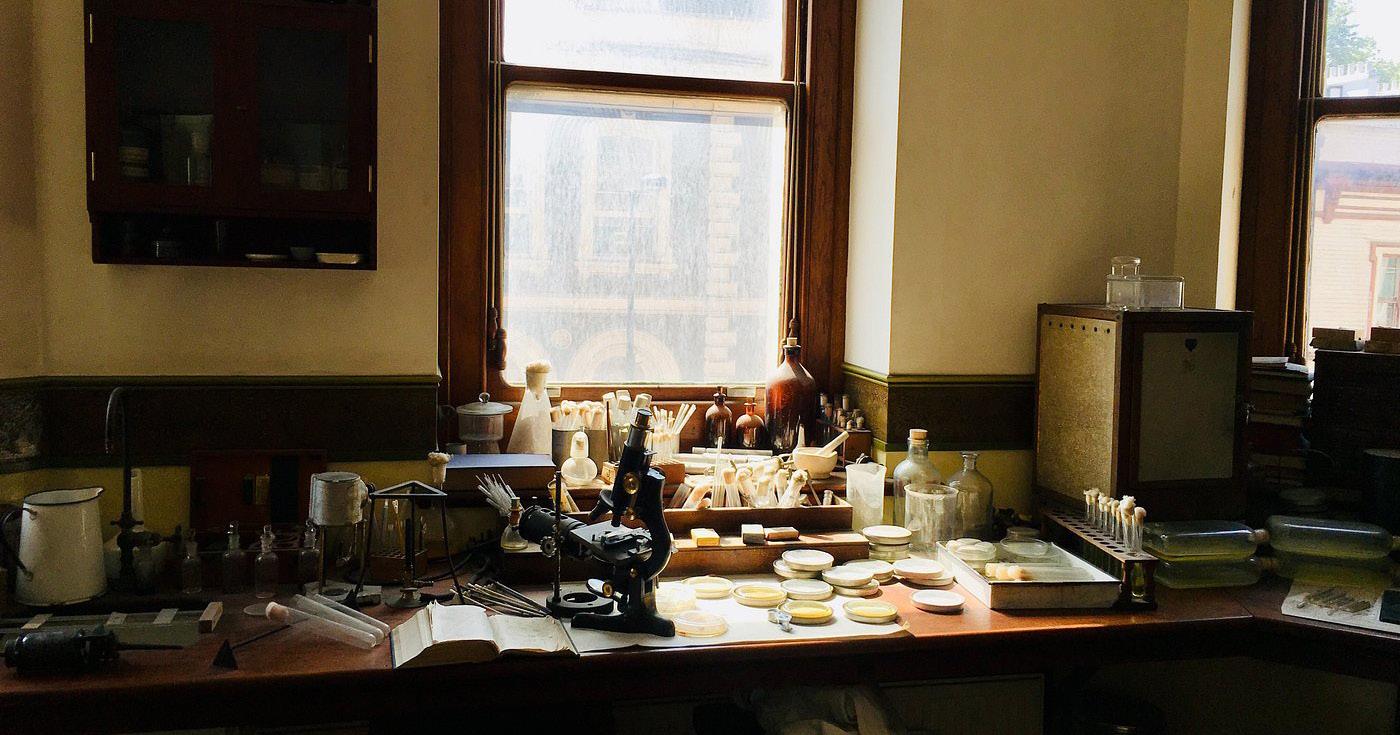
full working order – it’s a fascinating place, but so many people don’t even know it’s there.
‘I’ve tried to cover as broad a history as London itself has. Barts Hospital is in because it’s the oldest hospital in the country – it’s been on the same site since it was founded in the 12th century – and its museum shows how medical care has developed over the past 900 years. At the Hunterian Museum at the Royal College of Surgeons, there are exhibits from the ancient Egyptians right up to modern robotic surgery. And then there’s the Crick Institute, which offers free lectures to kids.
‘Probably my favourite place was the Fleming Museum at St Mary’s Hospital in Paddington, where Alexander Fleming discovered penicillin. It’s really small, and it’s in the hospital where he actually worked. You walk up these stairs, and it’s like walking back in time – you end up in his dusty old office, and you can see petri dishes left just as he left that food lying around and came back to find the mould. It’s so unchanged, so simple ... I loved it.
‘Another favourite was Big Ben – going up the tower to see it strike, and see all the engineering of the clock mechanism. Top insider tip – go on the 10 o’clock tour, because then you get 11 bongs. If you go on the 12 o’clock, you only get one bong! It’s really quite an experience to actually be in such an iconic spot, right when it was striking, and to be able to walk behind the clock face.
‘There are also quite a few Dorset connections in the book. We’ve got Robert Boyle, who came from Stalbridge – there are exhibits of his in the Science Museum, and he’s also linked to St Mary-le-Bow church: under the terms of his Will, he endowed a series of annual lectures which continue to this day.
‘Frederick Treves, the Dorset surgeon from Dorchester who rescued the Elephant Man and saved Edward VII, appears, as does John Freke, born in Okeford Fitzpaine, who was a pioneering 18th century surgeon at St Bart’s.
‘Artist William Hogarth married a Dorset girl, the daughter of Sir James Thornhill of Stalbridge, famous for the murals in Sherborne House and the Painted Hall at Greenwich – often called Britain’s Sistine Chapel. His epic ceiling includes around 200 figures depicting the 18th century story of political change, scientific and cultural achievements and naval endeavours.’
• The Science Lover’s Guide to London is available now, published by Pen & Sword.


top tip for

the Children patron HRH The Princess Royal comes to Sherborne –Jenny Devitt speaks to organiser Anne Dearle about her 30th concert
Friday 13th is not usually considered an auspicious date, but this September it turned out to be the best of days for Anne Dearle and her Save the Children volunteer colleagues. By special invitation, the Princess Royal visited – her third engagement in a busy day – to hear a concert of beautiful choral music performed by the Gentlemen of St John’s College, Cambridge in Sherborne’s Cheap Street Church. The occasion? To celebrate the 30th anniversary of the annual concert organised by Anne Dearle to raise funds for Save the Children. This year’s concert raised more than £11,000 – more than any of the previous concerts, helping Save the Children to respond within hours of emergencies, whenever and wherever disaster strikes.
Dorset’s new Lord Lieutenant Michael Dooley greeted Princess Anne outside Sherborne Boys’ School and presented her to High Sheriff Anthony Woodhouse (dressed in the eye-catching traditional Court Dress worn by all High Sheriffs since the mid-1700s), then to Dorset Council’s chair, Councillor Stella Jones, Sherborne Mayor Robin Legg and his fiancée (now Mrs. Legg – they married the next day!), West Dorset MP Edward Morello and Anne Dearle. The Princess Royal then joined a packed Cheap Street Church congregation, who were treated to a concert of choral music ranging from Orlando Gibbons to traditional folk songs and barber shop melodies. Pupils from Leweston School accompanied the first piece, after an afternoon workshop with the choir of St John’s.
This was not just the 30th Sherborne concert for Save the Children, it was also the last Anne Dearle organised. A former Hanford School teacher, Anne remembers the chance invitation to a Save the

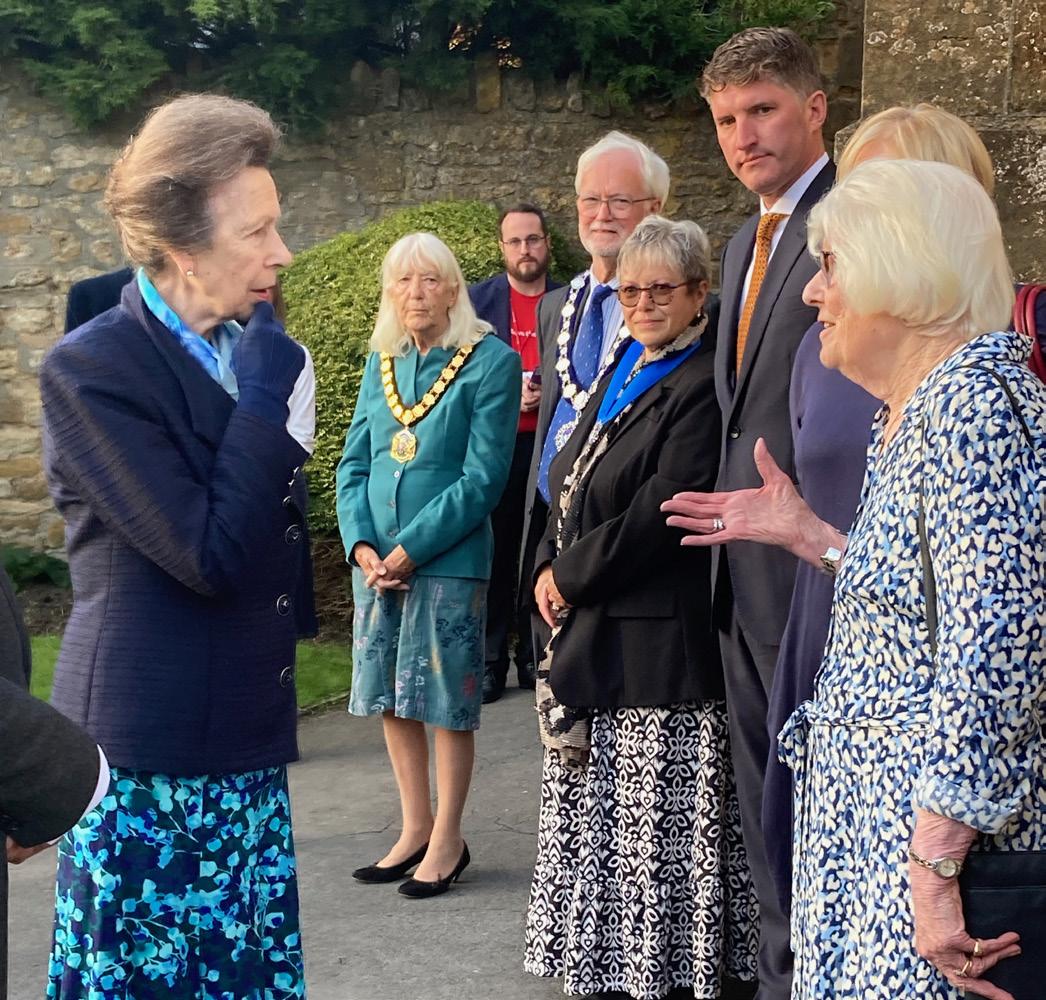
Children concert at Port Regis School that marked the beginning of her involvement. In 1994 the singers came from world-famous King’s College, Cambridge, and Anne was told by the charity’s Shaftesbury branch that the cost meant it would be a one-off. She suggested it could be held at Hanford School, and organised by the relatively new Blandford branch of Save the Children. A year later the event moved to Bryanston School and word spread about the quality of the concert and singers. It soon became an eagerly anticipated annual event at Bryanston, even after Anne retired and moved to Sherborne in 2006.
“Her” singers now came not from King’s, but the equally-excellent Cambridge choir of St. John’s, which has built up an affectionate relationship with their Dorset host.
As so often happens in recent years, COVID changed everything. Anne says: ‘It was obvious that a new plan was necessary. Reluctantly, we rejected the idea of commandeering a coach (to ferry Sherborne’s music lovers to Bryanston) and so we had to leave the generous hospitality of Bryanston. Instead, we decided to hold the concert at Cheap Street Church in Sherborne, where we have been since 2021, with the enthusiastic support of Leweston School.
‘I had no idea, 30 years ago, that the modest £124 we raised that first evening would be the start of three decades of successful fundraising – and of immense pleasure for appreciative audiences.
‘Miracles do happen.’
The attendance of Princess Anne, former president and now patron of Save the Children, was a fitting end for the hard-working former teacher who has organised the concerts for three decades.


Supporters hope it isn’t the end for the beloved Stalbridge arts centre and its legacy as a creative hub for the area – Rachael Rowe reports
People in Stalbridge and across North Dorset have a soft spot for Guggleton Arts Farm – known locally as the Gugg – which has been a centre of creativity for more than 25 years. So when it was recently announced that the Gugg’s farm buildings and premises were being sold, residents quickly took to social media to share their thoughts on its future, while acknowledging the reasons for its sale.
‘This place has brought a little bit of me out of myself this year, and I can’t thank them enough,’ said one message. Another called it ‘the lungs of Stalbridge,’ while others expressed that ‘it changed my life’ and described it as ‘such a special place,’ revealing the deep affection for The Gugg.
Isabel de Pelet set up Guggleton Arts Farm in 1995, converting the buildings in Station Road, Stalbridge, into galleries and artists’ workshops. She is well-known for promoting local artists and championing the creative arts in Dorset. Many

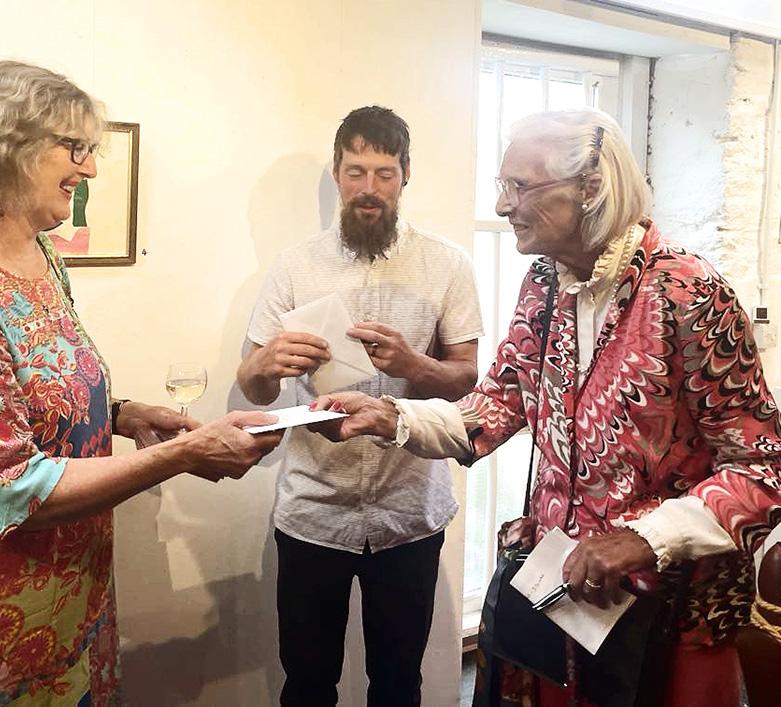
young people and artists have benefitted from her inspirational leadership at The Gugg and gone on to develop careers in the creative arts world. She received the Order of the British Empire Medal in 2015 in the New Year’s Honours list, for her services to artists in Dorset. Following her retirement, the premises are being sold.
Deanne Tremlett manages The Gugg today and is currently considering options for the future of the arts centre.
Guggleton Arts Farm was registered as a Community Interest Company (CIC) in 2020: its guiding principle is to offer opportunities to everyone to explore their own creativity within its spaces.
‘I got involved because I needed a studio,’ Deanne says. ‘I was at the Slade School in Wimbledon and I fetched up in Stalbridge one day to see Isabel, as I remembered she had studios. She said: ‘Do you want the whole place eventually?’ We both saw eye to eye on artistic things and how the Gugg promotes well-being and a sense of community.
‘Isabel said to me: “Will you run the Gugg for me, with a free studio and peppercorn rent? I accepted, set up a CIC and a team of volunteers.
‘What’s special about the Gugg is that it’s a very non-judgemental place. We also look to collaborate with others, and we’re very experimental. We look at what can be done rather than try to fit everything into a box.’
If you have never visited the Gugg, or looked at its website, you might be surprised at the astonishing variety of events and exhibitions. There are ceramics workshops, open mic sessions, live music, children’s ‘Guggleheads’ art activities, mixed media art classes, coffee knit and natter, exhibitions, comedy nights, Christmas wreath workshops ... and much more. There is literally something for everyone – even if that’s just a place to stop for a cup of coffee and a chat.
Fanny Charles, who was the editor of the original Stalbridge-based Blackmore Vale Magazine for 23 years, remembers the early days of Guggleton Farm (as it was then): ‘I knew Isabel because of our mutual interest in visual arts. After she completed her degree in environmental arts at the University of the West of England, she talked to me about her plans for the farm, which she owned. At the time it was fairly run-down, with slightly dilapidated stone buildings and an old Dutch barn. But it had character – and real promise as an unusual venue. ‘It took a lot of work to get the yard and the buildings ready, but it was so exciting when Isabel was able to start organising exhibitions. She had an amazing eye for talent, and one of the most consistently exciting parts of her programme was

Carers’ Day at the Gugg: carers are welcome to come and try out a craft or just watch others, sit, chat, make new friends, have a cuppa and a cake!

the annual young artists show, in late autumn. She showed work by emerging artists and people who were barely out of art school – some of them have gone on to great success.
‘The old stone building in the centre of the yard was the gallery from the start, but the project took a big step forward when Isabel was able to have the new floor put in to create a second space.
‘As well as Guggleton, Isabel was a leading figure in the visual arts scene in the region. She used to organise the hanging for the exhibition at the Royal Bath & West Show. One year, she asked me to help her and that was a real eye-opener.
Hanging an exhibition is not an easy job. Hanging an exhibition with hundreds of pictures, from spectacular paintings by leading regional artists to little watercolours and family portraits, in a way that allows them all to look their best – that’s a real art. And Isabel was brilliant at it. I hope her legacy can continue and that the current team at the Gugg can find a way to keep going.’
Deanne has lots of happy memories of the Gugg but there’s one that sticks out for her:
‘It was just after the Russian invasion of Ukraine. We thought, what can we do? So we asked our artists to donate one item of art for an auction. Gordon Brockman from the Antiques Roadshow came and we raised £5,000 for the Disaster Emergency Committee. It was a fantastic night.’
While dealing with the sale of the premises, the team at the Gugg are very supportive of Isabel and her family.
‘We completely understand the need for Isabel’s family to sell the premises for her sake. Isabel has given so much to the community and now she needs the gift back.’
• guggletonfarmarts.com

When William Saunders joined the Fun Box club at Sturminster Newton Boxing Gym five years ago, coach Shaun Weeks knew he was a future bright star for the club. Last year William made it to the National Schools Championship Final, narrowly losing out on a very tight points decision to an unbeaten boxer from Washington Tyne & Wear. The following season June 2023May 2024 William continued to improve, with a few narrow defeats that were on occasions hard to take, says Shaun: ‘Pushing European Champion Billy Long to the wire in the Barum Box Cup and then losing again in the King of the Ring (Sweden) final on a split decision was hard.
Again we thought William had done enough to win. So we sat down and had a chat to see what was needed to change those ‘nearly wins’ into actual wins.
‘The coaching team felt William just needed a bit more aggression and – more importantly – some self belief. He deserves to be on the top table. ‘William took it in, worked hard over the summer: and now he’s reaping the rewards. At the start of June he travelled to the Bristol Box Cup Championship and came home with a gold medal.
‘The following weekend we were in Manchester for their Box Cup Championship, and William beat the favourite to win a second gold in two weeks!
‘Then a few weeks ago we were in Ilfracombe to compete in the Barum Box Cup, where William won both the semi final and the final with stoppages. Three gold medals in a row: that’s some achievement for the 14 year old!’
William will be travelling to Sweden at the end of October


with nine of his teammates, looking to continue his gold rush at The King of the Ring Championships. Next March he will be looking to step up again in the National Championships, moving from the Schools age group to Junior as he looks for his first national title.


Tracie Beardsley catches up with C&O’s Matthew Holland - in between him selling tractors, fighting fires, making honey and selling cider!
When the excited 16-yearold Matthew Holland walked through the workshop doors of Stanley Pond Ltd in Blandford, it was his first step in making his childhood dream of becoming an agricultural engineer come true. Fast forward 46 years and Matthew is sales manager at the renamed C&O Tractors, the same family-run business dating back to 1753*, and now Massey Ferguson specialists. It’s one of the largest agricultural machinery suppliers in the south, with six depots, a hire fleet, parts and
after-sales services.
In his lilting Dorset voice, Matthew says: ‘My siblings went to university – I went to the university of Stanley Pond Ltd! But it’s given me 46 years of consecutive employment.’
July 3rd, 1978. I turned up on the moped I’d bought with money from summer bale stacking
He can even remember the exact date he started: ‘July 3rd, 1978. I turned up on the moped I’d bought with money earned
from summer bale stacking.’ His hands-on apprenticeship was four intensive years. ‘I was essentially married to the senior engineer Ronnie all that time. I was a teenager: he was hard on me, but I needed it. Back then the workshop was buzzing. We had a blacksmith and a real character of a tinsmith – Burt Gale. Even my listening to Radio One didn’t
drown out the backing track of Burt tapping out the tin.’
A rural childhood in Tarrant Keyneston ignited Matthew’s love for tinkering about with farm machinery. He was always either under the bonnet of a tractor or behind the wheel. ‘I loved going with my dad, a farm manager, to fix machinery,’ he says. ‘I was mesmerised by the forge and all the tools.’
Matthew says the industry has changed beyond all recognition: ‘We used to to actually repair things –hammering, welding, brazing ... that’s a style of welding with a bronze rod that’s not done anymore. For today’s agricultural engineers it’s far more complicated.
‘Machinery’s become so complex – it’s all digital, satellite, state-of-the-art technology. We need product specialists just to keep us on track ... especially me, computers are not my forte!’
Given the opportunity, Matthew will still roll up his sleeves and get his hands dirty: ‘I delivered a machine to my old form master recently and got my overalls on to get it ready for him. And I still tinker about in my spare time. I’ve got about eight acres and I keep some vintage Ford tractors that I love to play around with.’
There’s not much of that spare time, however! A fire engine hurtles past the C&O office and Matthew wonders if it’s “one of his”. He’s been a parttime firefighter for Blandford station for the last 39 years. He modestly reveals he’s just
received the Kings Coronation medal: ‘I was going to bring it in to show you but thought it would be a bit ostentatious.’
I ask him about this challenging – and brave –commitment taking up his spare time.
We used to actually repair things – hammering, welding, brazing ...
‘Who doesn’t want to drive a fire engine?’ he laughs. ‘I’m in the rare position that C&O will
let me “turn out” to a shout. My former boss Mr Pond let me do it, and so does my present boss, Andrew Coles, for which I am very grateful.’ Many of the “shouts” take him to his C&O customers. The heatwave summer of 2022 saw the rural crew regularly battling dramatic field fires.
Matthew has been a part time fireman for 39 years, and was recently awarded the King’s Fire Service Medal



Matthew Holland has recently been awarded received the King’s Fire Service Medal:
‘I was going to bring it in to show you but thought it would be a bit ostentatious.’
‘The adrenalin rush is incredible. It’s physically demanding, which I enjoy. I can also bring along my practical and engineering skills. And it’s very humbling. No matter how bad a day you’ve had, there’s someone else who’s had a much worse one! When things get demanding in the office, my leveller is my sense of humour. It helps to remind myself “no one’s died”.’
As if work and firefighting were not enough to squeeze in, Matthew also keeps bees and produces high quality craft cider and apple juice, aptly named Cider By Rosie. ‘I’m learning from an octogenarian cider maker. She’s the sorcerer and I’m the apprentice … again!’
There’s an agricultural saying about the secret of happiness: “tractors, fields and freedom”. Matthew certainly seems to
have found all three. ‘Work is a joy,’ he says. ‘It’s a good habit. I enjoy everything I do, and it’s all been made possible by the support of my wife Charmian and my two children, Daniel and Michaela – and more recently my two fantastic granddaughters.
‘I’ve had opportunities to move on over the years. Is it loyalty or lack of ambition that I haven’t? ‘For me, it’s loyalty, a value instilled in me. The Pond family were good to me when I was a boy. As a man, the Coles family have been brilliant. I’ve had only two bosses in 46 years, and the chance to travel to Brazil, Zambia, Canada and Arizona for work. It’s a job that takes me across the stunning Blackmore Vale most days, and I go home to my own “little piece of England” at the end of my day. Not bad for a country bumpkin!’
A-list dinner party guest?
‘Steve Fletcher, former centre forward for AFC Bournemouth when the club was going through a hard time. He was so loyal. And Eddie Howe, a top man who should have been knighted for Bournemouth FC’s fairytale transformation. Charmian, and also my first boss Timothy Pond, who I’m ever grateful to.’
Book by your bedside?
‘No books. Farmer’s Weekly Magazine. I go to bed dreaming of tractors!’
• C&O Tractors, Construction and Garden Machinery candotractors.com
• *C&O Tractors was founded in 2000 – Stanley Pond Ltd, now owned by C&O, was founded in 1753.

C&O Tractors are Massey Ferguson specialists, and one of the largest agricultural machinery suppliers in the south


New houses in Poundbury Dorset
Unrealistic targets double the build rate, threaten greenfields and ignore affordable homes and local infrastructure, says CPRE’s Rupert Hardy
Labour swept to power this summer determined to solve Britain’s housing crisis ... but is that crisis the same everywhere? We would argue that the Government is setting totally exaggerated and unrealistic housing targets for Dorset Council. The build rate in Dorset would have to more than double, as the Government seeks to shift house building from big cities, where most of the brownfield sites are, to greenfield sites in the countryside – a misguided policy. We also suggest that the proposed target won’t achieve key goals. It would neither bring down house prices nor address the shortfall of truly affordable housing and lack of social or low-rent housing. All the towns and larger villages in Dorset could be earmarked for new, large developments too, threatening the county’s exceptional environment, especially in North Dorset, which has a smaller proportion than other parts of the county within Areas of Outstanding Natural Beauty (AONBs, now National Landscapes) which have some degree of protection.
Large
would require the number of new homes to increase from the current 1,310 to 3,230 annually. This target is significantly higher than the Office for National Statistics’ (ONS) projected household growth of 1,212 per year, driven mainly by net in-migration of older residents. It is also much higher than the 1,793 homes annually figure proposed in the draft Local Plan, which was much criticised in the 2021 consultation.
housebuilding targets
do not lead to a decrease in house prices: indeed they may have the opposite effect
The new government formula calculates housing need only by looking at prices and incomes – a rather crude and simplistic approach compared with the standard method used by the Conservative government, which was in itself flawed.
• Supply chain constraints: Such high targets are far beyond the available supply of building materials and skilled labour.
Key issues highlighted by North Dorset CPRE:
• Unrealistic targets: We dispute the feasibility of Dorset Council’s (DC) new housing target, which, according to the Government’s formula,
• Demand and finance challenges: There is no evidence in Dorset that planning constraints are the main barrier to house building. There are currently 11,060 plots with permission in Dorset waiting to be built. Additionally, buyers with the necessary financial resources required are lacking.
• House prices: Contrary to public perception, large housebuilding targets do not lead to a decrease in house prices: indeed they may have






the opposite effect if developers look to buy more land. When prices start to fall, developers slow down rather than sell cheaply. The main factors behind house prices are the availability of finance and the level of interest rates.
• Risk of harmful development: Dorset allocating land for 48,450 homes, plus a potential 10,000 allowance for overspill from Bournemouth, Christchurch and Poole, could force planners to approve unsustainable Green Belt and greenfield sites.
• Environmental and climate change: Higher housing numbers may have an adverse impact on air pollution, carbon footprints, loss of natural habitats, reduction in ecological pathways and biodiversity, and, in Dorset specifically, nitrogen and phosphorus pollution in Poole Harbour.
• Traffic congestion, local infrastructure and public transport: Everyone in North Dorset has noticed the increase in traffic in recent years, driven mostly by new car-dependent housing. This has an adverse impact on the local economy in lost hours, exacerbated by the lack of public transport. Just imagine the gridlock we will see if the government’s housing targets are implemented. Labour has no announced plans yet to solve the critical lack of local infrastructure. Blandford and Shaftesbury only have one doctors’ surgery each.
• An alternative approach: CPRE would prefer realistic, achievable housing targets, based on local data detailing household growth and current home completions as well as affordability. Affordability should be addressed directly by investment in social rent homes. The Centre for Economics and Business Research published a report in February 2024 showing the cost-benefit of building 90,000 social rent homes nationally. It calculated that the longterm benefits far outweighed the costs by more than £50bn, thanks to reduced homelessness, increased employment and savings on
healthcare, among others. Subsidising new social rent homes would pay a handsome return for society and the economy.
DC deeply critical of government policy
Dorset CPRE hopes to work alongside DC, which is very critical of government policy, to develop appropriate responses. A senior DC housing policy officer spoke at 10th September cabinet meeting, responding to the question: “Do you have any additional comments on the proposed method for assessing housing needs?”:
‘The figures that the method generates need to be realistic. The figure for Dorset (3,230) is nearly twice the average annual completion rate, and in our view is not a realistic target given the constrained nature of Dorset, its lack of major industry and employment, and relatively poor transport connections.
‘We consider moving completions towards the current standard method target (c.1,800 dpa) to be a realistic challenge.
‘National targets, both the previous 300,000 a year – which has only very rarely been met, and only in the days when half of the completions were council housing – and the proposed 370,000 a year, are not based on evidence of need and are not justified. Targets based on more accurate evidence of need, including population growth, net migration and evidence of “hidden households”, would provide a sounder basis for explaining to local communities why additional housing is necessary.’
The next few years are going to be difficult, and it will take time for realism to permeate government thinking, but in the meantime, talk to your local Dorset councillor and protest to your local MP.
We may have an affordable housing crisis, which we addressed at our Affordable Housing Crisis conference in May, but it will not be solved by concreting over our beautiful countryside.
Dorset is worth protecting!




Britten Saint Nicolas
Britten Te Deum in C Vierne Messe Solennelle
Tom Hobbs — Tenor
Alexander Eadon — Conductor
SHERBORNE ABBEY
Wednesday 12th February 2025 at 7.30pm
Tickets £15.00, £12.00, £10.00
Scan the QR code to book online or email tickets@sherborne.org


Skyline, a recent painting which shows how landscape forms are creeping back into Zara’s geometric genogram paintings. All Images: Fanny Charles
The art of making patterns of chairs helps Shaftesbury artist Zara McQueen to tell her own story and those of other families
As a social worker and therapeutic family practitioner, Zara McQueen was used to making “genograms” with clients and patients, using personal papers and objects to help them explore their family backgrounds – but when it came to creating her own, she found she did not
want to lay out her life like that. Instead, the Shaftesbury artist hit on the idea of telling her story through patterns of chairs. The inspiration came from looking around her at the studio at Arts University Bournemouth (AUB) where she was studying for an MA in Fine Art.
Zara showing one of her mobiles to an exhibition visitor
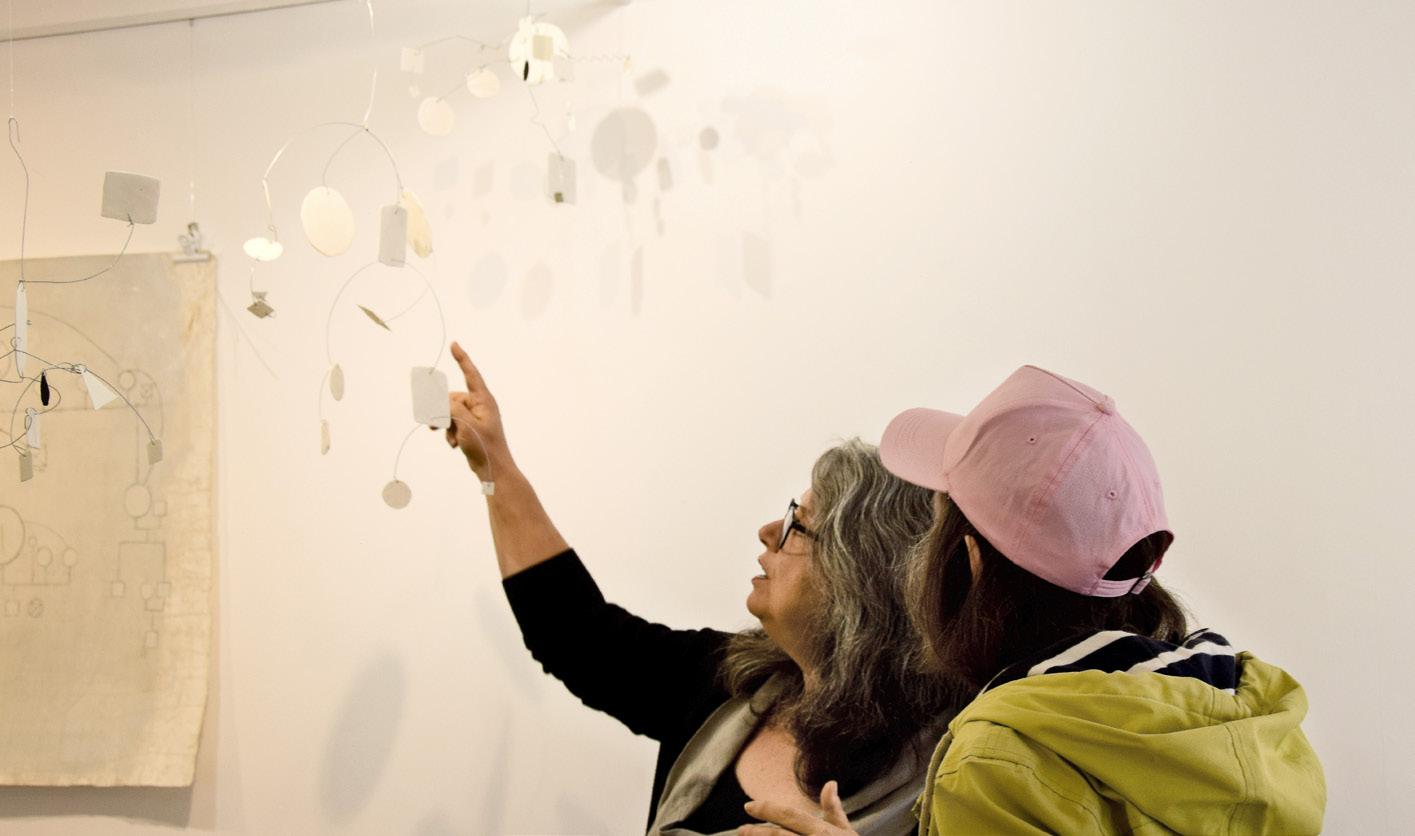
‘I noticed the chairs pushed up against the walls – brightly coloured plastic university chairs, marked with paint and studio life,’ she writes in the book of photographs which she produced after this unusual project. ‘I began to move them, transforming functional, splattered pieces of furniture into me and my family.’
As she explored relationships –two chairs was ‘a love story’ – and recreated the convoluted patterns of her extended families, with its journeys and multiple divorces, she decided to find out what chairs meant to other people. She invited a wide range of people to send an image and answer the question, Why this chair? The result is an extraordinary diversity not only of pieces of everyday furniture but of memories, ideas and individual stories.
Coloured plastic chairs were an immediately eye-catching feature of Zara’s latest exhibition at Shaftesbury Arts Centre, where visitors could both engage with the three-dimensional aspect –by sitting on or moving a chair – and explore other forms of genogram, in subtly-coloured geometric paintings and delightful mobiles. She says: ‘I have no idea where the current body of work will take me, but I am enjoying the exploration. Using chairs as stand-ins for people, making mobiles as well as drawings and paintings, is liberating.’
Zara is best-known as a painter of atmospheric and engaging landscapes and you could call her recent paintings ‘landscapes of the mind’ – but it is also clear that landscape is her natural artistic form, and it is evident from the recent exhibition that it is creeping back into her work. She was born in London, into a Jewish family with a complicated background that included numerous divorces and remarriages, and with a great-grandmother who came to England from Eastern Europe at the end of the 19th century. Zara was ‘totally dyslexic’ and painting and drawing were her favourite subjects. She wanted to go to art school but only finally achieved her ambition when she was 60, studying for an MA in Fine Art at Arts University Bournemouth

(AUB) where she graduated in 2023 with a distinction.
‘This course was my first formal art training. I always wanted to go to art school, and I got there, eventually! It was an amazing experience and a real privilege to study with some exceptional tutors and peers,’ she says. She went to AUB with a primary focus on making paintings and collages inspired by the landscape around Shaftesbury. But gradually, with the chair project developing, she began to produce paintings and mobiles which were inspired by and re-created the squares and circles of family groups. Now, a year on, her work is once again changing as the geometric shapes are increasingly influenced by landscape forms.
Zara has lived in Shaftesbury for 30 years and cites the

encouragement of the local community as an important factor in her success as an artist. She says: ‘I have had so much support from local people – they have been to my exhibitions and bought my art.’
The university course and the recent developments in her art follow a diagnosis of breast cancer and the inevitable emotional response. ‘I did a lot of deep diving and my work got very autobiographical,’ she says. ‘My art comes from me – it has always kept me sane.’
Zara has exhibited widely in Dorset and Wiltshire. Two recent works have been selected for the Royal West of England Academy’s 171st Annual Open Exhibition.
• A genogram is a graphic representation of a family tree that displays detailed data on relationships among individuals. It goes beyond a traditional family tree by allowing the user to analyse hereditary patterns and psychological factors that punctuate relationships. Genograms allow therapist and patient to identify and understand various patterns in the patient’s family history which may have had an influence on the patient’s current state of mind –Genopro.com

Equestrian photographer Brian Stubbs on the discipline of photography, the challenge of action shots, and the joy of the horse-rider bond
Born and bred in the Yorkshire Dales, equestrian photographer Brian Stubbs grew up on a farm surrounded by horses: ‘Nothing flash, we couldn’t afford that,’ he says. ‘It was Dad’s hobby – or vice. He said he “didn’t drink, didn’t smoke, so horses were his vice”. I wouldn’t say I rode, exactly: I sat on them and travelled around … but I really wouldn’t call it riding!
‘I trained as a teacher, went to Cambridge for my postgrad, and then moved to Somerset in 1982 to join Sexey’s School for my first job … and I stayed there until I retired from teaching in 2018.

Brian Stubbs

‘My daughter enjoyed riding, and eventually she got her own horse. I was taking pictures of them together, and my camera started to play up. So I invested
in a pro-level camera and lenses as a bit of a treat, and I started taking the photography much more seriously.’
Wincanton Camera Club
was contacted by Wincanton Racecourse with an invitation to members to come along and take some pictures. Brian took the opportunity, and submitted his





photos for the racecourse team to look at: ‘I was contacted by their press officer, and it led to a booking from the Jockey Club to cover four or five of their big race days in Wincanton.’
His reputation quickly grew, and Brian soon had an Access All Areas pass for the racecourse, where he got to know the local racing community.
‘I also called a couple of livery yards, and several asked me to take photos of their horses … and it all started from there. I now go to the Tizzard’s racing yard in Milborne Port quite regularly on the mornings they’re riding out. It’s quite nice for the staff, they don’t tend to get photographed because race days are all about the professional jockeys. For the yard staff it’s an opportunity to have a photo on the horse that they’re spending their life looking after. Kayley Woollacott also invited me to her yard at Crewkerne to cover her Owners Day, and that’s become another annual fixture for me.
‘I’m still a member of Wincanton Camera Club – we’ve got a big day on Wednesday with Charlie Waite, the landscape photographer, visiting (see the BV’s recent interview with Charlie Waite here): we have more than 100 people coming. ‘The club itself has around 20 members – but it’s thriving. And we’ve done well in the Western Counties Photographic Federation – of all clubs in the South West, we’ve won the Small Clubs Award two years on the trot. The club is for all abilities –even if you’re just taking photos on your phone. We all have to start somewhere, and the learning never stops.’
Brian’s enjoying his retirement – by not being at all retired: ‘The photography is growing, just by word of mouth. I primarily photograph horses and dogs: they are what I love, and I



therefore have an understanding of them. Like if I photograph a rugby match, I played a lot of rugby, so I know what’s going to happen. If you know an animal, you understand how it is going to react? A horse can make or ruin a picture with a twitch of an ear! And owners know that – if the ears go back, it’s not a picture they would buy. I’m always looking to capture the relationship between the owner
and the horse. They book me to take a horse portrait, but some of the best pictures are with the owner in the picture, focusing on their horse and totally ignoring the camera. They forget you’re there and you get to see that genuine relationship.
‘The biggest kick I get is being able to show them the photos afterwards, that’s what gives me a buzz. To know that you’ve given them something that is so

‘Some of the best pictures are when the owner is focusing on their
personal, it’s very much theirs. ‘I genuinely love the challenge of capturing action photos – horse racing, jumping, Eventing … I have photographed some of the top stars at Nunney, but it’s also nice to see it from the grassroots, from tiddlers up. One thing I’ve got gnawing away in the back of my head is to recreate a Stubbs painting as a photograph. I’d love to do that. But I enjoy just improving my art.
‘The more you learn, the more you realise how much there is to learn. Everybody’s got a camera in their pocket these days. But to take a quality picture is something else. If you are paid to cover an event, you can’t afford for one in ten to be OK, you need to have ten out of ten. Even then, the one that’s got that extra bit of life in it, that’s the bit that makes it really special. Focus, lighting, understanding the right moment … it’s a hell of a discipline, and it’s a good tutor.’
• Brian welcomes portrait commissions – please contact via bf-stubbs.co.uk



With a fresh start as part of the Fox-Pitt eventing team, Jess Rimmer has had a month of change, but is excited for a new chapter
September has been an exciting month for Team Rimmer. Having achieved a first class honours degree in Biochemistry, I decided to put it to good use (not!) and take the next big step in pursuing my eventing career.
Fontmell Parva has been my home for as long as I can remember, and I owe so much to both the place and the people for getting me to where I am today. But, as with any career, progression is natural and it was time for a change. A few weeks ago we made the move to Hinton St Mary, thrilled to be joining the Fox-Pitt eventing team. I have been trained by William since my teenage years, and with his recent shift towards teaching since retiring from top-level competition, the move made total sense – helped hugely by the support of my very generous owners, and of course my family.
New home, new routines
As you’d imagine, moving five horses, all their kit and all of mine (and yes, I took both lorries too!)

“What have you got in



was no mean feat. Between mum, Lily and me, we managed to get all settled in with just a few short trips. I was grateful we were literally only moving 15 minutes down the road and not three hours away!
I’m trying to embrace my tidy side (I’m still not sure it actually exists) as I organise my new tack room ... but hey, at least everything is in the same place! Elsa, Max, Jimmy, Henry and Mattie have all settled in beautifully, and they’ve adjusted to the new routine very quickly.
We’ve been here for a month already, and we are absolutely loving it! I’m living in the onsite accommodation otherwise known as The Lodge with four other girls, who come from all over the world, all with different horsey backgrounds. It’s so interesting chatting with them about the similarities –

and differences – in the ways we’ve all grown up with horses.
Although the work days are busy, there is a real sense of camaraderie and I’ve felt part of the team since day one. We all muck in and help each other, whether it’s yard work, riding or deciding which outfit to take on holiday! The working environment is great, and combining that with the fantastic training opportunities and facilities it feels like a real honour to be here, learning from world-class people in a world-class environment.
As far as actual eventing is concerned, I have been totally preoccupied with our big move, and
I can’t really believe how quickly the end of the season is creeping up on us.
We have one final push with the three 3* horses (Mattie, Elsa and Henry) as they aim for Bicton International at the end of the month, while the ‘young guns’ Max and Jimmy aim for Swalcliffe Park mid-month and Bovington the following weekend as their final runs ... Great British weather permitting, as always!
I’m looking forward to putting some of my new training to good use, although I do have to keep reminding myself that Rome wasn’t built in a day. Regardless of how the season ends, I’m beyond thrilled to be part of the Fox-Pitt team – I am SO excited for what’s to come.
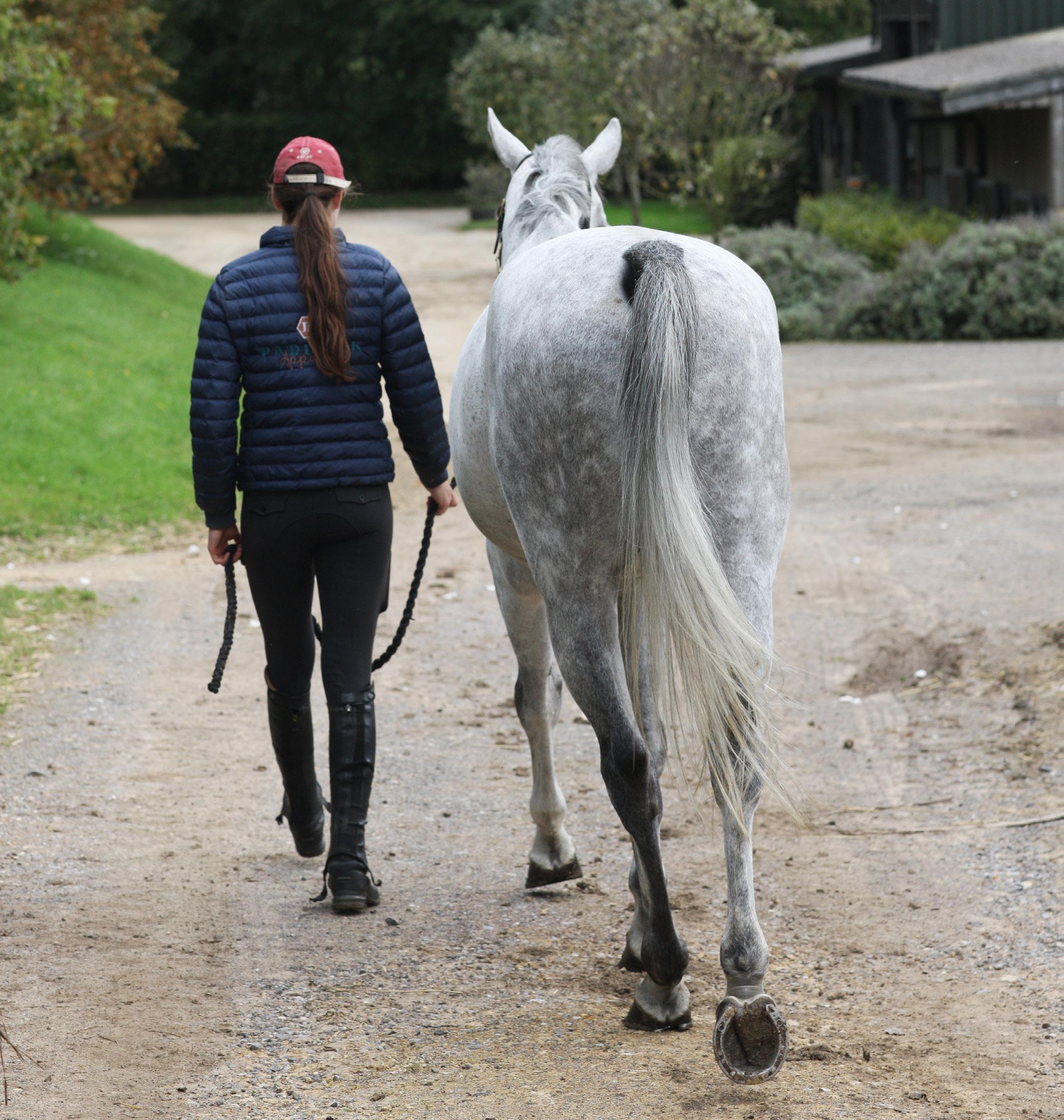

Pauline Batstone shares her monthly round up of what’s happening among the town’s collection of community enterprises and events
As I write the Vale Pantry folk are having fun organising some Halloween excitements for later this month ... nothing too scary, I’m assured ... Meanwhile we are approaching that time of year. *whispers* Christmas is just around the corner! We are getting ready – the Make Stur Sparkle leaflets will be out soon, so keep an eye open for one as it will tell you all that is going on in and around Stur from the beginning of November through to New Year’s Day. We’re excited to announce that we will be welcoming Paul Young and Los Pacaminos back to switch on the Christmas tree lights on Saturday 30th November: supervised, of course, by Father Christmas, who will be in 1855 to meet children each Saturday from then until the Saturday before Christmas. And the little Christmas angels will be flying into town from the beginning of December. The second Sturminster Newton Business

Awards will be launched shortly – and everyone will have the chance to nominate their favourite businesses, and thank those who offer the best service.
The popular Sturminster Newton Wedding Fair will be back next year, taking place in the Exchange on 25th January – trade stand space is still available for professionals to book.
St Mary’s Church will be once again be holding a display of wedding dresses (24th and 25th January) – it’s a wonderful exhibition, hopefully displaying the dress beside a wedding photo of it being worn – fashion history, social history and a romance story all in one. If your wedding dress would enjoy one more turn in the spotlight, the church would love to borrow it!
Meanwhile the SturAction shops are working hard to please their customers while raising the money to pay for the Christmas events in the town.


Balancing individual responsibility and government effectiveness, MP Simon Hoare argues for a ‘smart State’ that fosters independence
During the recent General Election campaign, I suggested that an issue that would need serious consideration is the role of the State, and the debate surrounding our rights and responsibilities as citizens. Too often, politicians are characterised as being either of the Left and therefore in favour of a BIG State or from the Right where a small state is preferred. To paint such strictured pictures gives the lie to the assumption that the State is static. It is not. Tide-like, it ebbs and flows: actively interventionist when required, passively observatory when it can be. Governments – in my view erroneously – often define their success in terms of the amount of legislation they bring to the Statute Book. A casual perusal of the many bookcases in Parliament shows that the volume of laws greatly increased following 1945 by comparison with earlier years, and this has shown no real sign of abating.
We have responsibilities and the State should not create an atmosphere where we can shirk them.
So, perhaps our first responsibility as citizens is to want Government to do less, but do it better? Give more time to considering legislation and its impact. Get it right first time.
The principal role of the State is to keep the country safe and defended. However, from most people’s perspective it is the provision of services and support systems, those things with which we engage most regularly, that are dominant in their evaluation of the effectiveness of the State. And I think the key word here is effectiveness. It is not a question of Big or Small State, but its effectiveness or, as I increasingly prefer to call it, Smart State. The full arsenal of AI and digital is going to have to be deployed. There will be transitional hurdles to face and surmount ... but that is nothing new. The Britain of the mid 21st century is going to need a State that is fleet of foot. In order to get there, it is also going to require politicians of all party persuasions to once again take up the responsibility of making the policy case for X, Y or Z, rather than merely being a cowardly echo chamber of inbox and social media.
Politicians need to have the courage to ‘make the weather’ in order to ‘turn the dial’. Lloyd George, Atlee, Thatcher, Blair ... they all did so. They cannot be a closed chapter.
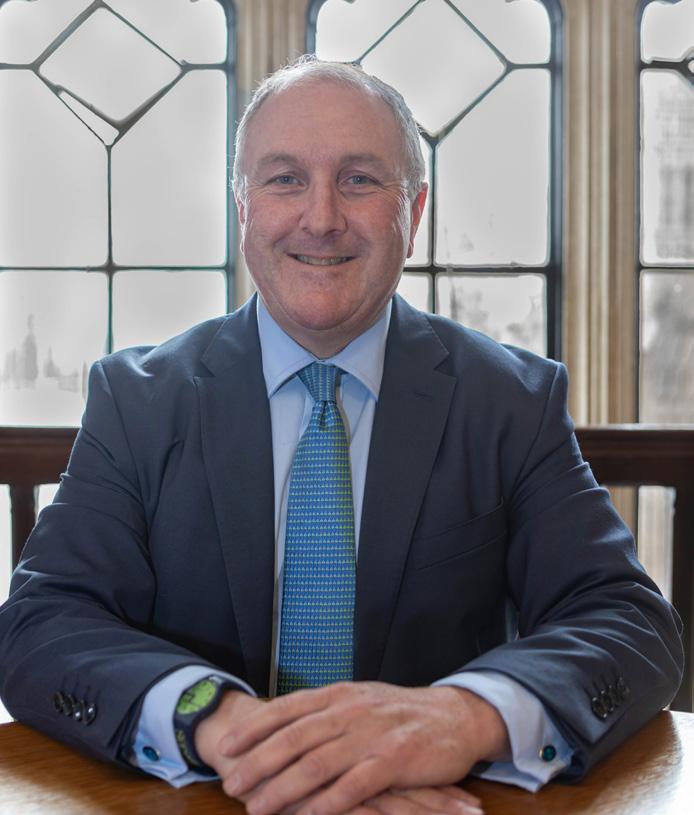
Infantilise the nation
Which brings me to our rights and responsibilities. Too often, the narrative has focussed on ‘I know my rights’ and ‘what I am entitled to’. We have a – correct –presumption that the State will help rather than hinder us. It will provide protections and the famous welfare ‘safety net’, below which none can fall. But it must always provide this as a springboard, from where people are able to improve things through resilience, independence and selfsufficiency.
I hope the PM will stick to his pledge to reform welfare to ensure that work always pays. He will face internal and external opposition, but not from most sensible-thinking people in the country.
The State-authored, welcome and necessary interventions during COVID and the cost of living crisis has, however,
encouraged a loss of individual independence and a greater reliance on the State to solve problems perfectly within our own control and competence. The State cannot, and should not, do everything. To try to do so leads to the infantilising of our fellow citizens and a dependency culture becoming ever more embedded. Why try to stand on our own
two feet when the Government will do it for us?
Our ‘rights’ are, in my judgement, enhanced when we accept and deliver our responsibilities. We do have responsibilities and the State should not create an atmosphere where we can shirk them. To create a oneway street of expectation is profoundly unhelpful. I shall
be returning to this theme in a subsequent article.
On a housekeeping point, I have diarised a list of Advice Surgeries held on Fridays across the constituency. If you have an issue or problem with which you think I can help please email me: simon.hoare.mp@parliament.uk
Vulnerable pensioners, hospitality and farming sectors are all in need of help – West Dorset MP Edward Morello calls for urgent change
In an effort to plug the black hole in public finances left by the previous government’s economic mismanagement, the new government has made the indefensible decision to strip pensioners of their winter fuel payments. This will directly impact more than 20,000 residents of West Dorset. The decision to do so means that many vulnerable people will be forced to choose between heating and eating this winter.
West Dorset is a wonderful a place to live, and understandably many people choose to retire here – but many of our fellow residents rely on that £300 winter fuel payment to soften the impact of energy bills that have increased by 34 per cent in the last decade. I have voted against this decision, and will continue to push the Chancellor to reconsider. In the meantime, I would strongly urge anyone
affected to see if they are eligible for pension credits. It is a somewhat convoluted application process, but if you are eligible then it means you will continue to receive your winter fuel payment.
With the arrival of Autumn it is worth reflecting on the extremely wet summer we have just experienced, and the significant knock-on impact it has had on two of West Dorset’s most vital sectors –hospitality and farming.
Early indications are that this year’s harvest is down 15 per cent on 2023, and hospitality takings down as much as 25 per cent
Early indications are that this year’s harvest is down 15 per cent on 2023, and hospitality takings are as much as 25 per cent down. As a result of high taxes, the cost of alcohol in pubs and restaurants means many of us choose to stay at home rather than going out.
Hospitality is one of the largest employers in West Dorset, and I will be pushing the Treasury to

look at what measures can be taken to reduce the operating costs for the sector.
At the same time, the NFU is reporting the farming budget was underspent by more than £300 million last year –in no small part due to bad management by officials – and that the Treasury might use this as an excuse to reduce the current spending.
With basic farm payments set to disappear, far from being reduced the farming budget needs to dramatically increase if we are to protect our rural food producers.
• Please do contact me on: edward.morello.mp@ parliament.uk
Our re-elected MP Simon Hoare has praised North Dorset voters for not falling for Labour and Lib Dem election promises –but the Labour and Lib Dem candidates between them received more votes than he did. In reducing Simon’s 2019 majority by 93% this time, most voters clearly remembered the past 14 years of scandal-ridden Conservative chaos, corruption and incompetence.
Worryingly, almost a third of the North Dorset electorate opted not to vote this time. No doubt many of them are disillusioned with the way the First Past The Post electoral system fails to provide a parliamentary voice for the majority of us.
Simon was chosen to represent North Dorset by just a third of those who voted: likewise, Labour gained their landslide victory with just a third of the national votes.
The new All Party Parliamentary Group for Fair Elections focuses on three key areas:
replacing First Past the Post with a proportional voting system, eliminating dark money from politics and countering disinformation in public debate. Good luck to them in their search for an electoral system that works better for everyone. Labour hasn’t made a great start so far, especially with the clumsy scrapping of the automatic winter fuel payment for pensioners. Revelations about various donations and services they’ve received have left them open to the criticism that they are no better than the Tories in that respect. Labour actually declared more donations during the general election campaign than all the other parties combined. It has increasingly strong ties with the financial sector, and before the

election campaign it received a £4m donation from a taxhaven-registered hedge fund with shares in fossil fuels, private health firms and arms manufacturers. This surely raises questions about what influence such donors hope to get in return.
The one topic that unites a majority of us is a growing concern for the environment and the worsening effects of the changing climate, and here there is a glimmer of hope. The new Foreign Secretary’s recent speech demonstrated a clear ambition to urgently address these issues. However, actions as ever speak louder than words, and we wait to see what actions the government actually takes.
Ken Huggins North Dorset Green Party
The Conservative leadership contest is down to its final four candidates: Kemi Badenoch, Robert Jenrick, James Cleverly and Tom Tugendhat. The Tory MPs will decide who the final two candidates are – Simon please choose well if you’re reading this – and then the party membership will vote for their leader. I have no skin in the game here, but I do care about our country, and a strong country

requires not only a strong government but also strong opposition. It’s vital the Tories break the habit of the past half-decade and choose the right leader this time. Let’s review the past three leaders of the Conservatives. There was Boris Johnson, who had a moral compass akin to a real compass in a solar storm. Liz Truss who delivered ‘a true Tory Budget’ which wiped £30 billion of the
UK economy ... that’s £666m for every day of her premiership. Finally, Rishi Sunak – who promised integrity, honesty and accountability on day one ... and then several hours later reinstated Suella Bravermen as a minister, just days after she resigned due to breaking government rules. Let’s leave these standards in the past. The country doesn’t need an opposition leader like Robert Jenrick, who oversaw the covering-up of children’s cartoon murals in UK asylum centres. How devoid of empathy must one be, to deny children a brief moment of relief during such a traumatic time?
I want the Conservative Party to return to a place where people like Rory Stewart or Anna Soubry are welcome – both were culled in 2019. While I might disagree with some of their ideas, I know they come from a place of rational thought and compassion. I don’t want the Conservatives’ gambit to be winning back voters from Farage’s Reform party by demonising immigration, or to withdraw from the ECHR – something which was conceptually endorsed by that little-known British Conservative
Sir Winston Churchill. I want the Conservatives to offer sensible policies: not those deemed likely to win a demographic of voter, but those which can be backed up by data, approved by experts and which are morally just. I have faith in Sir Keir Starmer’s government to deliver real change to the country and give us a platform where we can solve the issues brought about from 14 years of Tory government. However, I believe the best version of government occurs when there is also the
best version of opposition. Proper opposition will hold a government to account and offer fair scrutiny of its actions. So, to anyone with a vote on who the next Conservative leader will be, please vote for the candidate that will return the Conservatives to sensible politics, and not the candidate who wants to appease the far right, or wants the UK to leave the ECHR, because that is the politics of division. As a reminder to you, we’re the United Kingdom.
Guy Perkins North Dorset Labour
We must build many more affordable houses in this country. I lived in Stevenage until I was nine years old. My parents moved there from London to have a family, after leaving Northern Ireland a few years earlier to enjoy the swinging sixties. The new town of Stevenage was a triumph of central planning, but it took many years to become a vibrant, settled place. The genesis for Stevenage was in the post-war years of reconstruction. The story of the Labour minister breaking the news to the townspeople in a small, crowded hall remains recognisable today. As the then Minister of town and country planning, Lewis Silkin, stood before the anxious residents, he announced a bold vision for Stevenage – the first of the new towns designed to solve the post-Second World War housing crisis and urban congestion. The initiative was part of the broader New Towns Act of 1946, which aimed to create self-contained communities
with adequate housing, jobs and amenities, reflecting the utopian ideals of the era.

Silkin was lucky to get away from the meeting without injury. The angry residents let down his car tyres, hurled abuse at him and changed the signs on the town to “Silkingrad”. I have no doubt that Angela Raynor is just as robust, but times change and people are even less inclined to defer to authority today. There is renewed talk of new towns. Not here in North Dorset, but Stevenage illustrates that bold visions do not become reality without top-down direction and overcoming objections. Labour proposes to rekindle that spirit and suppress NIMBYism. They say they are prepared to be unpopular.
That’s all fine ... but I am confident that without the consent of affected communities, the targets will not be met and the outcome will be at risk.
That is why Liberal Democrats
prefer to agree to support good development and oppose bad development. We want great homes for people and we adopted higher targets than Labour, because that is what younger people demanded and so clearly need. The difference between good and bad development depends on swift engagement, genuine exploration and transparent decisions between local and national government and communities. Our planning system is rightly cited as a major blocker to development: but the question of what is in it for the affected community must be answered, and the consequences understood. I know that Nick Ireland and the Liberal Democrat controlling group at Dorset Council have set out a vision for future housing in Dorset, and we look forward to the community engagement that will secure more houses while retaining support. We need to give more people the chance to enjoy our Dorset life and build their future here. We need to do that by urgently building community consent and backing the vision for good development.
Gary Jackson North Dorset LibDems
Want to reply? Read something you feel needs commenting on? Our postbag is open! Please send emails to letters@BVmagazine.co.uk.
When writing, please include your full name and address; we will not print this, but do require it.
I am wondering if anyone else has noticed a lot of our sycamore trees have very brown dead leaves on them. With our elm, ash and some oak trees disappearing because of disease, I am hoping nothing like this is affecting the sycamore. H Rawles, by email
I’ve been farming in North Dorset for many years, and I’ve watched debates about our environmental policies with great interest. It troubles me to hear some folks dismiss our efforts to stop the decline in wildlife and plant life as foolish. The truth is, our land, and the creatures that live on it, are in trouble. If we don’t look after them, who will? From where I stand, taking care of our land isn’t just about today’s yield; it’s about making sure there’s a tomorrow for farming too. We need bees to pollinate crops, healthy soil to grow them, and good water management to keep the land from drying up or flooding. Hedgerows and old trees aren’t just scenery—they help stop the soil from washing away and provide homes for creatures like barn owls that help keep pests in check. The idea that modern farming means using up every bit of soil until there’s nothing left is outdated and harmful. We farmers know better than anyone that you can’t keep taking without giving back. We need to work with nature, not against it.
Environmental concern isn’t just politics or an agenda. This is about making sure our grandkids can farm this land like we have. We can’t let shortsighted decisions in trade and politics stop us from doing what’s right for our farms and our future. We need policies that actually support what we’re trying to do out here. It’s not just about money – it’s about making sure the way we farm today doesn’t ruin our chances tomorrow.
Name and address witheld
On the 25th September the Blackmore and Sparkford Vale hunt were, yet again, holding up traffic on the A30 near Henstridge. This is a busy road and traffic moves at speed.
Hunts are trying to convince us that they are genuinely following a trail – but if this is the case then surely they would want to keep the dogs and
riders well away from A roads?
I know a number of people locally are sick and tired of the problems caused by them and feel that more needs to be done to address the situation.
I hope the authorities take proper action before there is a serious accident.
Name and address withheld
With reference to your excellent article ‘David vs Goliath’ (The BV, Sep 24). The question of the suitability of the A357 and the ever-continuing expansion along its length in both North Dorset and South Somerset is a long standing one. It is patently clear to all except those under pressure to meeting housing targets that the A357 is not designed for either the type of traffic or the volumes it is now be subject to.
It is to be noted that in the North Dorset District Plan 2011, when referring to housing expansions in the vicinity of Sturminster Newton and Stalbridge, there appeared the comment ‘The A357 is a road of inadequate standard’ and the plan directly stated that it should not be subject to substantially increased volumes of traffic.
And yet the volume of traffic on the road since that time has increased enormously.
With the plans for new houses along its route and an Aldi with 100 car parking spaces, the trend is clearly set to continue: much to the detriment of those who live beside the road, as I do in Newton, Sturminster Newton, and of course to the very nature of the villages, most of which are conservation areas. I would suggest that putting massive volumes of traffic and lorries onto unsuitable roads is hardly preserving the area’s character and beauty.
Jeremy Squire, Sturminster Newton
The recent decisions by the Labour Party demand attention. Every adult understands the need to balance our budget and not spend money we don’t have. However, I question the Chancellor’s methods during this economic challenge.
It seems the main focus has been on reducing support for pensioners, like cutting the winter fuel allowance and adjusting pensions. Is this really the best and only way we can fix our economy?
We’re losing about £5.5 billion every year to unpaid

taxes – not regular PAYE workers but bigger entities that work hard to evade paying their fair share. Then there are those on Universal Credit who seem to manage a number of holidays a year ... I truly believe in a Welfare State that supports those in need, it’s the mark of any decent evolved society. But if we’re serious about fixing our financial problems, we need to be fair and make sure everyone contributes, not just pensioners. You can’t pick and choose who to pressure without losing trust. I hope the chancellor will look for broader solutions that don’t just burden the elderly and vulnerable.
F Scott, Sherborne
Hinton St Mary help
I’m reaching out to seek your reader’s assistance with a project I am currently involved in, alongside SAVE (Save Britain’s Heritage charity). We are focusing on a particular cottage in the village of Hinton St Mary – there is a photograph (opposite) and the below description for your reference:
“This cottage is so unloved that we do not even know its name, however its reference number with the District Council is 2/89/3337 for anyone interested in rescuing the building, which in the meantime sits and deteriorates.
In 1989 there was a planning application to convert the cottage into two residential units, it was refused on appeal however, on the grounds that the roof material should remain as thatch.
Planning Department, North Dorset District Council, Nordon, Salisbury Road, Blandford, Dorset”
I am trying to ascertain the current address of this cottage and whether it is still actively in use. Any information your readers could provide, or directions on where I might be able to find this information, would be immensely helpful.
A. Fitch, by email (*please send any replies to letters@bvmagazine.co.uk)


Whatever your next step is, we’re here to support you.
Whether you’re looking to buy or sell your property, create a Will, or appoint an attorney, we’re on hand to provide the clarity you need.
By working with us, you can be confident that whatever decisions you make, they’ll be based on sound legal advice that’s in your best interest.
Contact us at:
info@porterdodson.co.uk

porterdodson.co.uk
Crossword

Simply click to complete on your tablet, computer or phone - or there’s a download ‘PDF’ option if you prefer pen and paper.

Dahlia from our garden – just click to complete!



It’s October and that can only mean one thing – Halloween is coming! In this month’s article I’m going to talk about some of the great for some scary fun!
Ghost Hunting
Ghost hunting is an experience where you can go, usually with a group of people and a guide, and hunt for ghosts in a stately home or castle. Two companies that offer ghost hunts in Dorset are Haunted Happenings and Ghost Hunt Events – both have upcoming events in Dorchester at the Shire Hall and Dorchester Prison, Nothe Fort, the Rifles Museum in Salisbury and Merley House in Wimborne. They tend to book up quickly.
There are some fun local ghostly events happening this month:
Employ My Ability offers vocational training for students with learning disabilities and special educational needs. One of their students, Maddie Walters, spent her work experience with us, and now writes a regular column - Ed
• Haunted Harbour Tour, Weymouth takes you on a trip to the darker side of history. Saxon massacres, the Black Death, murders, mysteries and secret tunnels will all be discovered. Many dates still available for 2024 – including Halloween itself, October 31st! – £11
• Ghost Hunt at Museum of East Dorset, Wimborne Built in the 16th century, will you experience the reported disembodied footsteps or even see items moving mysteriously by themselves? Saturday 26th October, 8.30pm £33
• Ghost Hunt at Shire Hall Courthouse, Dorchester 19th October 2024 8pm until 2am, £46

And if an organised event isn’t your thing, Dorset has plenty of properties said to be haunted which would be fun for a walk as dark closes in:
• Knowlton Church, near Wimborne
• Corfe Castle, near Wareham
• Tyneham – Dorset’s ghost village, near Kimmeridge Happy haunted Halloween!
The UK’s leading end-of-life charity, Marie Curie, is inviting Dorset’s bakers to whip up some much-needed funds this autumn. Whether you’re a star baker or just discovering a passion for pastries, this is a chance to raise dough for a great cause while creating something delicious. Upon signing up, participants

will receive a special recipe pack featuring autumn-inspired bakes from chefs Melissa Hemsley, the Hairy Bikers and actor and author Fay Ripley. The pack also includes everything needed for a successful event, from posters and social media graphics to invitations and fundraising cards. Fay Ripley, who’s supporting the campaign with her banana and chocolate loaf recipe, says, ‘Get baking with me! Marie Curie’s work in delivering expert care at the end of life is so important, and baking can be a sweet way to support this great cause.’
Kara Frampton, Marie Curie’s community fundraiser for Dorset, added, ‘As the nights draw in, baking could be a fun and tasty way to help us provide expert care and support at the end of life. Whether you host a bake-
off with friends or simply hold a cake sale, your fundraising will ensure Marie Curie can continue its work in Dorset.’
Not a cancer charity, Marie Curie cares for people with any illness they are likely to die from. As well as providing hospice care and hospice at home care across the UK, Marie Curie has a free support line which is available to anyone with an illness they’re likely to die from and those close to them. It offers practical and emotional support on everything from symptom management and day-to-day care to financial information and bereavement support.
• To join the baking challenge visit mariecurie.org.uk or contact Kara Frampton on 07712 691510 or kara. frampton@mariecurie.org.uk.

by Rachael Rowe

Back when Sturminster Newton hosted its first Cheese Festival in 1999, there can’t have been many who envisaged its popularity being so longlasting that it would celebrate a 25th anniversary. ‘It’s a perfect day,’ said volunteer Steve Lewis, busy running the popular wine bar. ‘It’s absolutely rammed – last year it was too hot, the year before too wet, and then in 2021 we were coming out of COVID. Today is perfect!’
Outside, crowds gathered around the band stage, a glass of beer or cider in hand, relishing the warmth of the September sun. There were queues
Inviting samples ready to be tasted
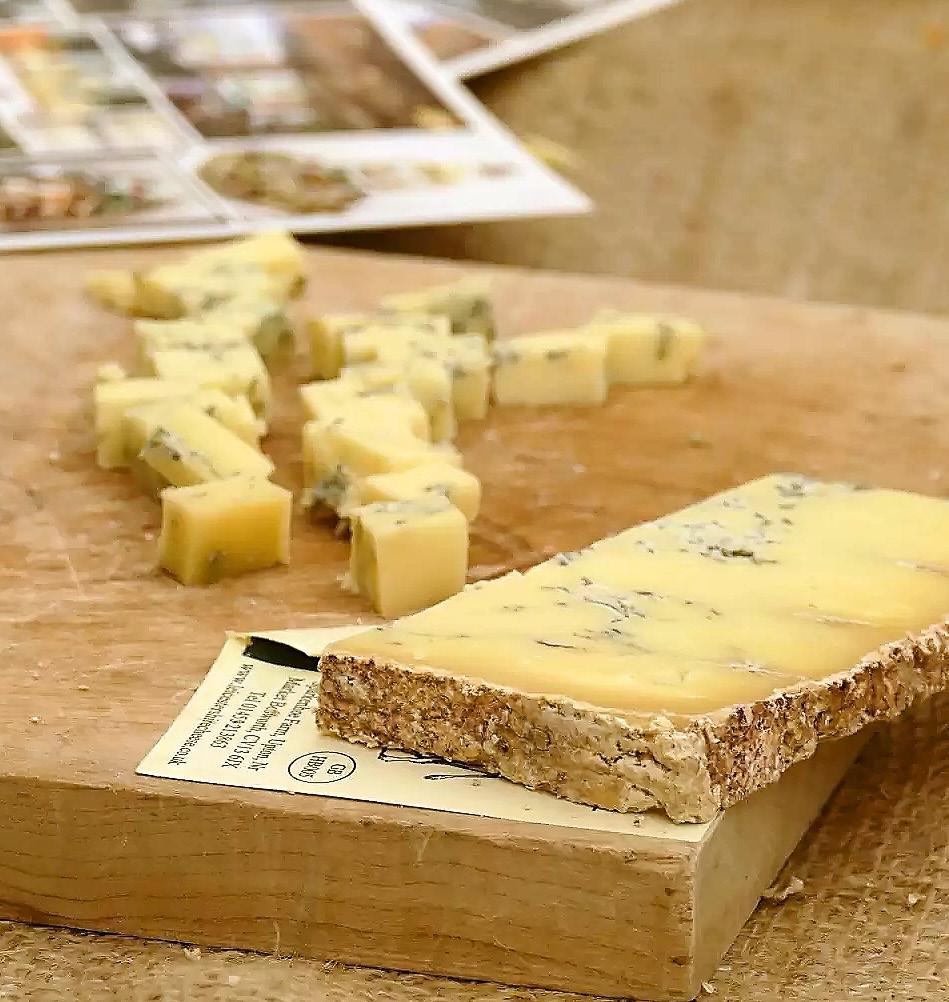
for the popular food stands – this year, the longest was probably for the Greek souvlaki and gyros stand, where two cooks worked frenetically … yet somehow appeared completely chilled out as they kept up with relentless orders. There was a similar scene at the Westcombe Cheddar toasted sandwich stall and Purbeck Ice Cream. Considering there were at least two other foodie festivals within a short drive, people had clearly chosen Sturminster Newton ... and for good reason.
Inside the enormous food marquees business was brisk, with producers highlighting classic ranges and new items. People had clearly come for the cheese … and particularly the samples. Dense crowds gathered around all the stalls, sampling and chatting to the producers. So that others didn’t miss out on the samples, some visitors passed pieces back to friends in the crowd. Feltham’s Farm, Lyburn Farmhouse Cheese and Book and Bucket Cheese were among the most popular with visitors. The Real Cure was another very popular stall with its tasty salamis and cured meats – and requisite generous samples.
Apart from tasting the cheese, interesting questions were asked as visitors took full advantage of being able to speak to the producers about their work. Why is Red Leicester cheese such a deep yellow? It’s due to a natural dye, annatto, which comes from a South American plant. It’s been included in the cheese since the 18th century. Many asked how long Cheddar cheese matured for – and then tasted the difference between the eightweek and one-year-matured versions. Despite the
crowds, the producers managed to keep up with both sample demand and all the questions being fired at them by interested, curious customers. Some of the more seasoned visitors had clearly come with a shopping list of favourite cheeses and foods to buy, having savoured the high quality produce in previous years. The venison at Taste of the Wild sold out within two hours of the show opening. A customer at Bath Cheese stand made a bee-line for the soft cheese, exclaiming: ‘I love this one. I always go for it.’
Outside the queue at the Greek gyros stand appeared to be getting longer.
There’s always something new at Sturminster Newton Cheese Festival. On the Weymouth 51 stall – renowned for its chilli sauces and fermented food – the new golden-coloured Dorset Fire was eye-catching. Owner Mikka Tamlyn explained: ‘It’s a probiotic health tonic, best taken before a meal. Made with Dorset naga, Dorset wasabi and apple cider vinegar, it has a surprisingly mild taste – and is also good in a G&T!’
While many of the stalls are regulars at the Cheese Festival, this year’s first timers included the Lyme Regis-based Black Ven Distillery, which attracted a crowd interested in its British rum. When owner John Tucker found that there were only a handful of true British rums (with most others being spiced blends), he started distilling, using almost all of his ingredients sourced from the South West. As a first timer at the Cheese Festival, John was clearly impressed: ‘It’s been amazing. A wonderful experience. The best show of the year for us.’
Sturminster Newton Cheese Festival is always about more than the food, however. The craft section seems to get bigger each year and 2024 was no exception. Autumnal decorative wreaths, glass decorations, hand-crafted leather mules, woodwork, weaving and more filled the tents and space outside. Hampshire-based Crackerdash had an innovative cheese-themed board game where you eat the cheeses as part of the experience (what’s not to like?): “We came last year and although it was hot we had a good time. So we’re back again this year but chose an outside pitch where it’s cooler!’
Visitors enjoyed discovering new foods and stocking up on old favourites and gathered with friends over lunch from one of the many food stands. There was even appreciation of the odd wasp: ‘It’s good to see them. There haven’t been many bees and wasps around this year.’
As the Sturminster Newton Cheese Festival celebrates 25 years, it’s wonderful to experience

a perfect day sampling some of the finest food produced in the West Country, and seeing the crowds enjoying a day in the sunshine. The queue at the Greek gyros stall got ever longer … if you didn’t brave it, hopefully they will return next year. Here’s to the next 25 years of cheese festivals in Sturminster Newton!
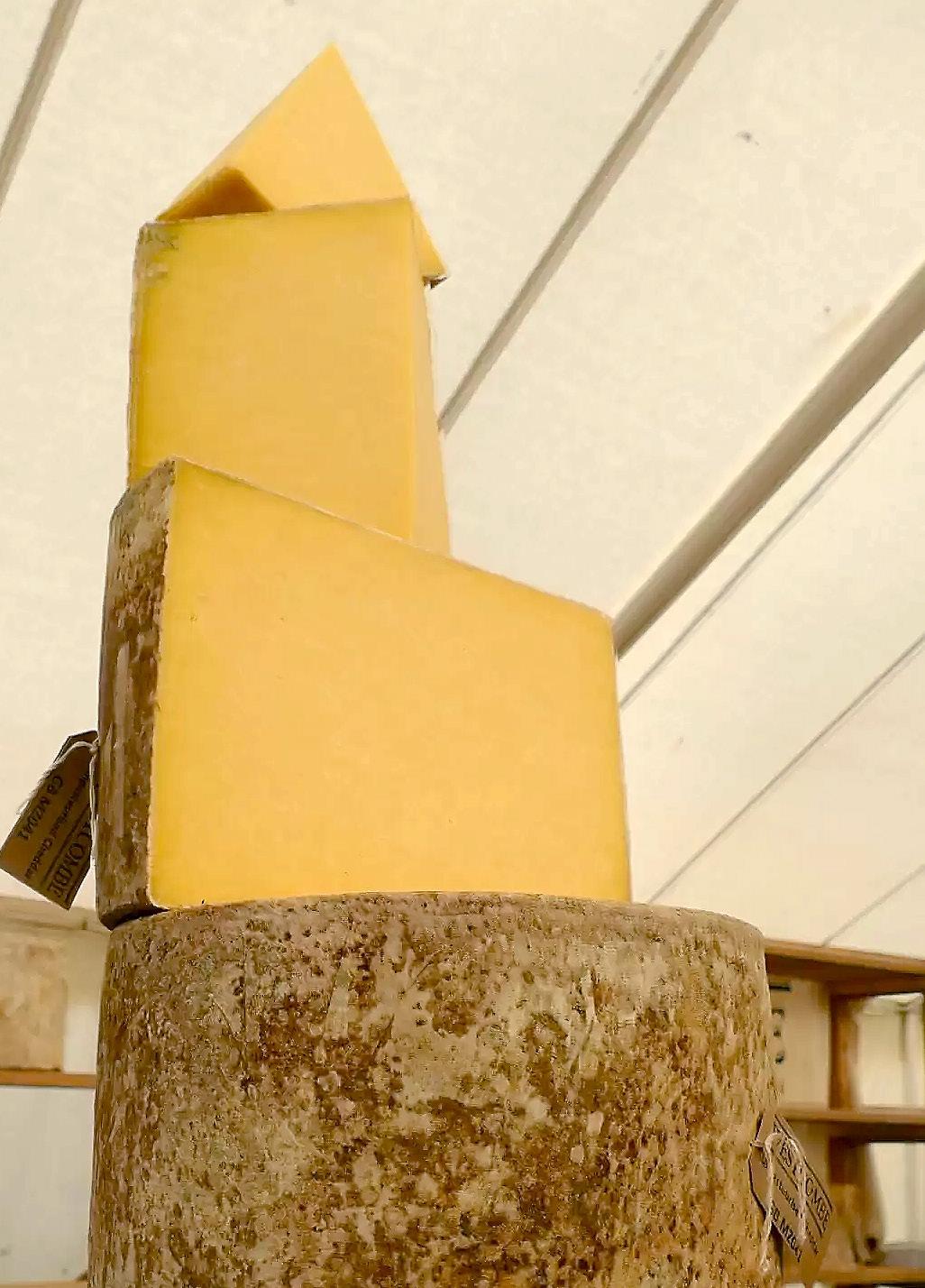

On Saturday 12th October, members of Ringwood & Fordingbridge Lions Club will be travelling to the New Forest For Ukraine (NFFU) Warehouse in Lymington to help package boxes of aid destined for war torn Ukraine. As winter fast approaches, families will be in need of warm clothing, hot water bottles, footwear, clean blankets, duvets and pillows, sleeping bags, portable gas cookers, toiletries, food, medical equipment and supplies. There is a comprehensive list that can be found on the NFFU website
If you are free on the morning of Saturday 12th October and would like to help out, or alternatively if you would like to donate items to send to Ukraine, then please contact Ringwood & Fordingbridge Lions Club via their website or by telephone on 0345 833 5819.
Ringwood & Fordingbridge
Ringwood & Fordingbridge Lions Club helping to package boxes at the NFFU warehouse in 2023

Lions Club President Alastair Ward says: ‘We are humbled at the amazing work of NFFU in maintaining a steady stream of humanitarian aid to those struggling in Ukraine. Our members are proud to help them prepare boxes of the muchneeded aid for transit.’
NFFU accept a wide variety of donations, which will be shipped to aid centres and hospitals in Ukraine and Poland for families
in need. There are collection points assembled all over the New Forest for anyone who would like to donate items needed for aid centres and hospitals in Ukraine. Anyone wishing to know more about either organisation or how they can help or volunteer can find out more at their respective websites:
• newforestforukraine.co.uk
• randflions.org.uk
On September 20th, Wimborne Community Garden was crowned Winning Community Garden at the South & South East In Bloom Awards at RHS Wisley – for the second consecutive year. Adding to their success, the garden also received the Judges Award, acknowledging the dedicated direction in which the core team has led this flourishing community project.
The garden, which is part of the charity Faithworks, focuses on growing produce to share with Wimborne Food Bank, the Community Kitchen and of course Beaucroft College’s café, as the garden is part of their site. Over the past two years the garden has developed into a flourishing space, filled with vegetables, fruit and flowers; it’s
also become a space filled with a great deal of friendship and joy. Like all gardens, it continues to grow – plans for a small kitchen area are in progress, enabling cooking skill-sharing, recipe swapping and the chance for communal feasts.
The awards judge praised the project: ‘The work that has been done over the last two years at Wimborne Community Garden is amazing. Keep up with this brilliant project—it certainly shows what can be achieved by a dedicated community group.’

Jane Benson (left) collecting the Judges Award from a trustee of South & South East in Bloom

Wimborne’s Museum of East Dorset has welcomed a familiar face as its new Learning and Family Assistant. Rachel Simpson-Fernandes, with over a decade of teaching experience in primary and special education needs (SEN), has joined the community-focused museum to inspire local schoolchildren through hands-on history. Rachel, who is passionate about both teaching and history, says, ‘I couldn’t believe my luck – teaching and museums! Two of my favourite things – the perfect role for me that combines creativity and practical skills.’
Her role will involve co-ordinating school visits from across the county, offering themed workshops that cover 2,000 years of British history. The sessions give children the chance to find out about life as a Roman, for example ... or as a scullery maid in the Victorian washroom. “I remember coming to the museum when I was at school,’ says rachael. ‘It’s changed so much since

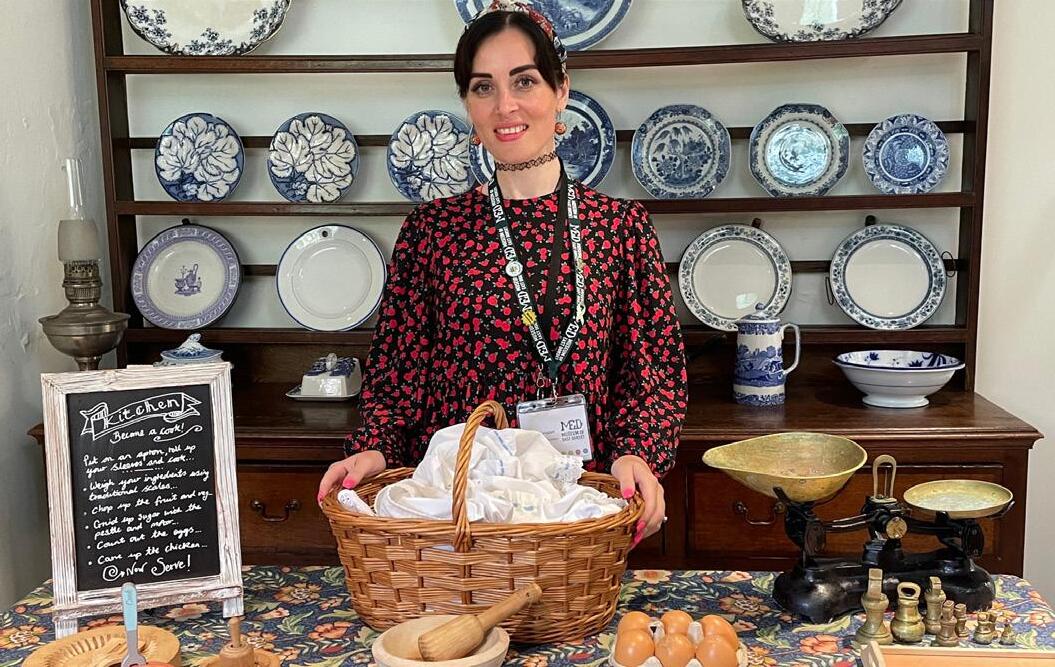
Rachel SimpsonFernandes in the Victorian Kitchen
then: no boring questionnaires here! It’s wonderful to play a part in moving the museum forward, offering even more activities for schoolchildren.’
The museum, which has earned the Sandford Award for heritage learning seven times, also offers a Hands-On History loan programme, making its resources accessible to schools nationwide. Now, Rachel is calling on locals to get involved as learning volunteers: ‘You don’t need experience,’ she says. ‘Training and mentoring is provided, and every session has a detailed delivery plan that is easy to follow. All we need is people with a passion for history, who love the magic of museums and how they enrich children’s lives. And if you fancy dressing up as a Victorian housekeeper or Roman soldier – even better!’
• If you’d like to learn more, contact Rachel on learning@museumofeastdorset.co.uk.
The Sturminster Newton Royal British Legion branch, ably led by Poppy Appeal Organisers Tracy and Anthony Walsh, were provided with a charity pitch at the Sturminster Newton Cheese Festival. Over the two days they sold raffle tickets for a wide range of prizes, including a very special bottle of gin dedicated to the Special Boat Service that had a commando dagger in the neck rather than a cork! Alongside the raffle there was a Name The Teddy competition for the children to win one of two bears, plus lots of poppy merchandise available for a donation to the Poppy Appeal. Over the two days the group raised a total of £2,473.11. Branch chairman Trevor Legg says: ‘It’s an amazing sum. We must send huge thanks to everyone who came over and said hello, and who contributed by buying tickets or donating. Without you we would have had nothing! Secondly, we thank the Sturminster Newton Cheese Festival
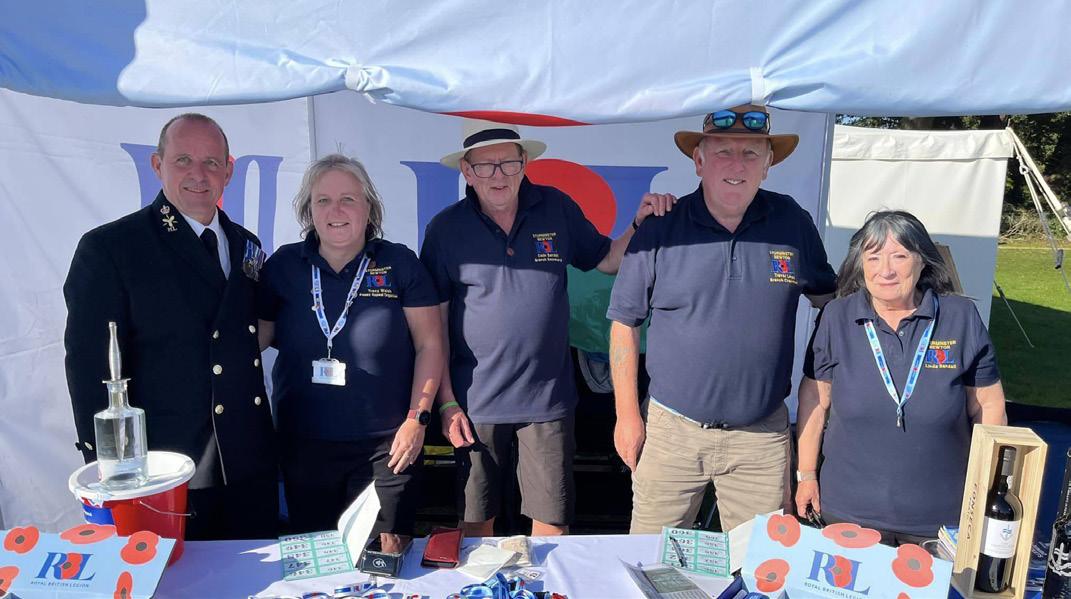
committee for letting us have a pitch this year. And lastly, we must thank all the businesses who donated prizes – without their support there would be no raffle!’
• Do you have a few hours to spare late October or early November? The Stur RBL branch are looking for Poppy Collectors. Please contact Tracy on 07967 412758 or this email

Sturminster Newton Floral Group are this year celebrating their 60th anniversary. To commemorate this event, the group invited international flower arranging judge and demonstrator Michael Bowyer to create several stunning flower arrangements. The Club also provided a delicious afternoon tea for the occasion, with a stunning 60th anniversary cake accompanied by a glass of fizz. The Floral Group is a member of the National Association of Flower Arrangement Societies (NAFAS) and the chairman of the Dorset area was able to attend the event, as well as past members of the club.
Sandy Milne, chairman of the Sturminster Newton Floral Group, says: ‘The afternoon was a great success and will go down as a day to remember.
‘One or two ladies in the club have been members for more than 30 years: during that time members have competed at the Chelsea and Malvern Flower Shows. The Club has a wealth of memorabilia recalling the success of flower arranging

shows held in Sturminster Newton over the years.
‘We have seen the fashions in flower arranging change, and more recently the impact that using less oasis – floral foam – to hold the plant material in place, because of environmental issues, has had. Styles have returned to the methods used prior to foam being invented – that of crumpled chicken wire and pin holders.
‘As a member of NAFAS there are always events taking place in our area that the group can attend, including flower arranging demonstrations, workshops, our annual Christmas celebrations and our Area Show – where the competitive classes demonstrate
the wonderful designs that can be created with flowers.’
The group meet at 2pm on the second Wednesday of each month in The Royal British Legion Hall in Marnhull, and warmly welcome visitors to attend (admission to nonmembers is £7). Meetings vary from flower arranging demonstrations by local and national demonstrators, workshops with guidance on the best ways to make the most of shop-bought and garden flowers, flower-related talks or have-a-go crafts with a flower theme.
• For more information see here, or contact Sandy on sandramilne22@gmail.com
A special evening hosted by the Stars Appeal Fundraising Committee at The Rifles Museum in Salisbury raised more than £27,000 for Salisbury Hospital’s charity. Over 250 guests attended the Late Summer Soirée on

September 12th, alongside hospital staff who act as charity ambassadors, committee members, and Stars Appeal president, the Earl of Pembroke. Stephen Oxley, Chairman of the fundraising committee, said: ‘We thank all those who made donations and pledges. It is only through generosity like theirs that the Stars Appeal can continue enhancing care for local people at the Hospital.’
Throughout the evening, guests heard moving stories from Stars Appeal Ambassadors Dr Tracey Parker and Dr Jim Baird, and Patient Ambassador Adrian Abbott,
who shared how the charity’s projects supported his recovery from a cardiac arrest. Neal Riley explained how the Stars Appeal Benson Suite, a space for families who have lost a baby, supported his family during their loss.
The soirée also focused on the charity’s latest initiative: providing 36 ‘by your side’ sleeper chairs for vulnerable or end-of-life patients to have loved ones stay comfortably by their side.
Funds from the event will contribute to the £1 million the Stars Appeal aims to raise this year.
• starsappeal.org

A local expert from Citizen’s Advice provides timely tips on consumer issues. In the postbag this month:
Q: ‘I want to make a will but I have no idea where to start or how to make it official.’
A:It’s very important to make a will because there are rules which dictate what will happen to your money, property and possessions after you die – without a will they may not go to the people you would have wanted. It’s a good idea to ask a solicitor to draw up or at least check your will. This is because it’s easy to make mistakes which could cause problems after your death. A solicitor will charge for their services, but they should tell you how much their help will cost before they start working with you.
Make a plan
Before you approach a solicitor, you should think about what you want to include in your will. Things to think about:
• How much money and property you have
• If any of your possessions are especially important to you
• Whether you want any of your money or possessions to go to specific family or friends after your death
• What you’d like to happen to the rest of your assets, including whether you’d like to leave any gift to charities.
• If relevant, you should decide who should look after any children who are under 18.
• Who will sort out your estate and carry out your wishes, as set out in the will. These people are known as the executors.
Make it legal
For a will to be valid, it must be made by someone who is 18 or over and ‘of sound mind’ – meaning someone who is capable of making and understanding decisions. It must be drawn up without any pressure from another person and must be made in writing and signed by the person making the will, in the presence of two witnesses, who must also sign the document in the presence of the person making the will. Lastly, it should be dated.


As soon as the will is signed, dated, and witnessed, it is complete. It should then be kept in a safe place: at home; with a solicitor or accountant; at a bank; or at HM Courts and Tribunals Service.
• You can find out more information about making a will on the Citizens Advice website.
This month Barry Cuff has chosen two postcards more modern than usual, and scenes no doubt familiar to older locals. Both were sent by holidaymakers on the coast – Charmouth and West Bay.

Sent in May 1966 to Mrs B Newey of 80 Carless Avenue, in Birmingham. Gresham House was previously Sea House, but new owners from Gresham Street in London had changed it to a hotel at the turn of the century. In the 70s it became the Sea Horse Hotel, and was demolished in 1990, replaced by a block of apartments of the same name.
‘Gresham House Hotel, Charmouth, May 21st. Very many thanks for letter which I will answer when I get home. Tish (?) fetched me last Tues & we arrived in time for lunch, & Jill is going to take us back to-morrow morning. Feel a lot better for the rest & change & all the nice meals put in front of me. Mrs Mac is off work with nervous debility! Luckily Mrs Amor is OK, Mr & Mrs Davis (one of Mrs Barnard’s daughters) called yesterday. She has grown awfully like her mother! Do hope you are OK. I will write soon. much love Violetta’


The West Bay postcard was sent on 6th October 1970. In 1884 the Great Western Railway was extended from Bridport down to the harbour. The new station was initially called Bridport Harbour, but it was soon renamed Bridport West Bay by the GWR to attract day trippers and holidaymakers to the seaside by rail. Some older 19th century maps referred to the stretch of sea in the area as West Bay so this must have influenced the new name, although it was neither west of Bridport nor a bay! Soon the whole settlement was known as West Bay.
‘Tues. Thanks for letter. Crossed with mine. Shall be on my way from here on Thurs. Have loved being here. Guess you would like it too. Love to all. Hope for good news of G soon. Love Betty’
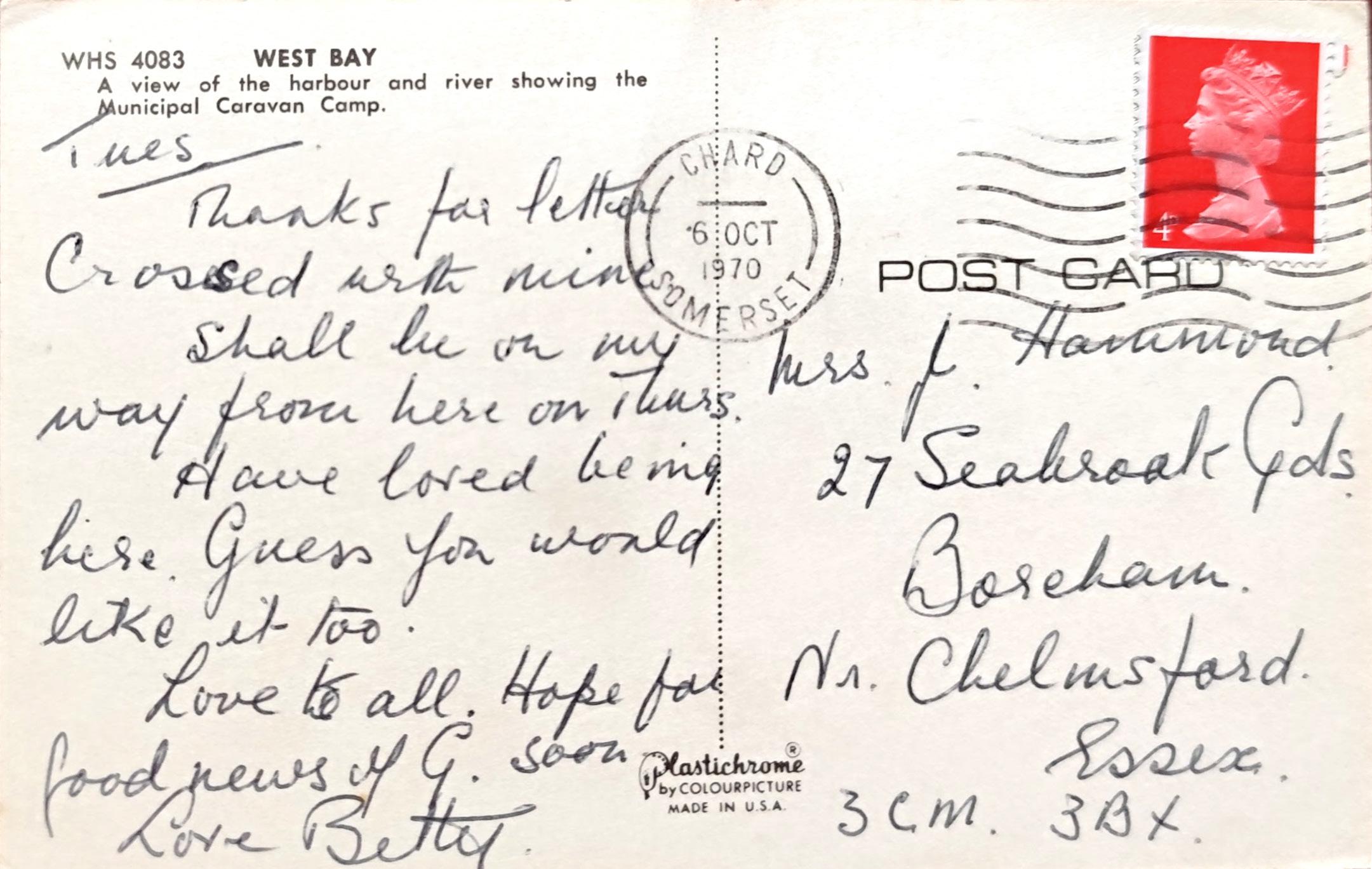
Step back in time with our ‘Then and Now’ feature, where vintage postcards from the Barry Cuff Collection meet modern-day reality. Explore the past and present on the same page, and see the evolution of familiar local places. ‘Now’ images by Courtenay Hitchcock
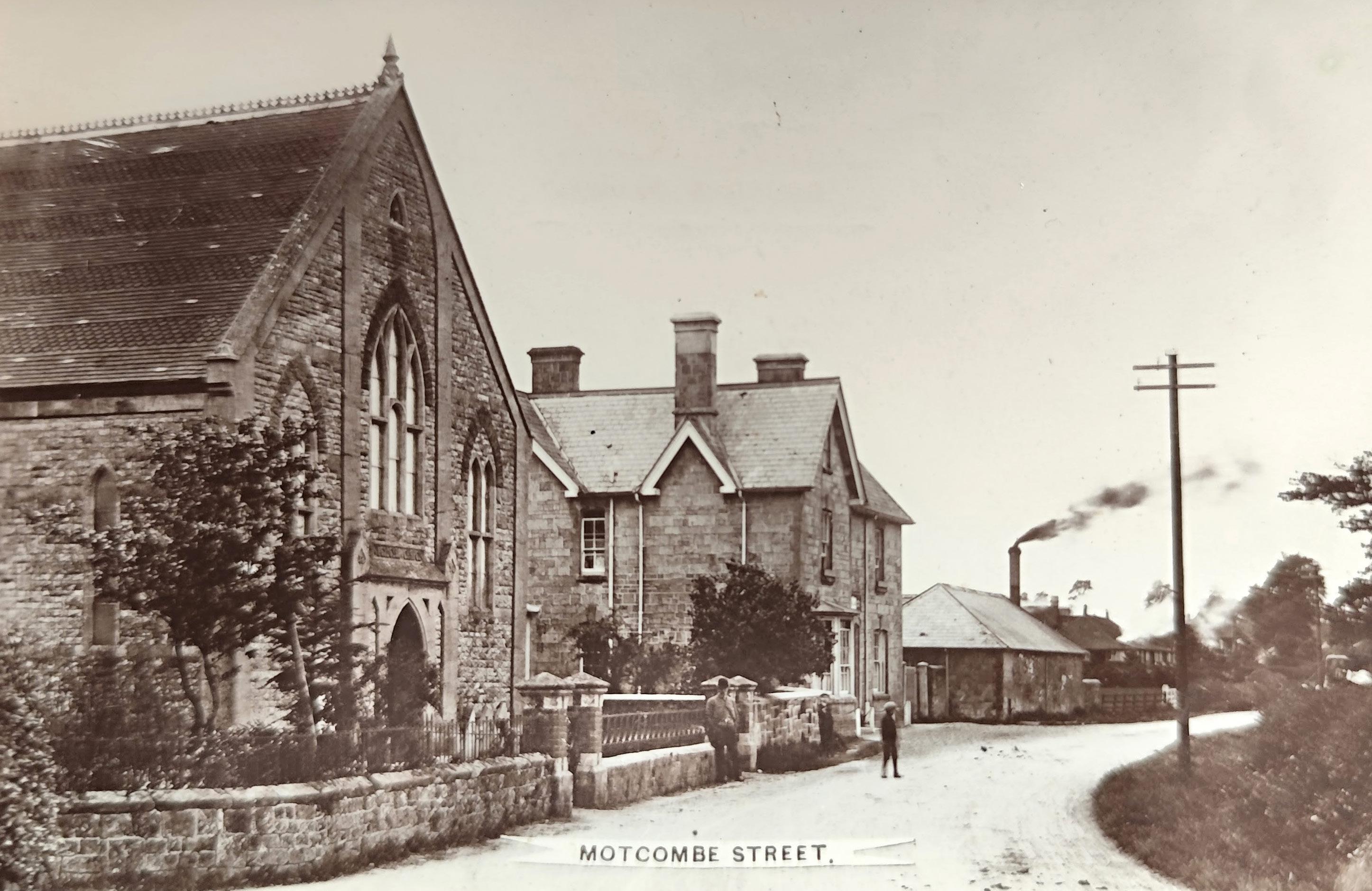

The Street is largely unchanged, though hedges have replaced the perimeter stone walls. The single storey building with the tall chimney is just about still visible, too. The angle is changed as the street is wider and straighter than it once was
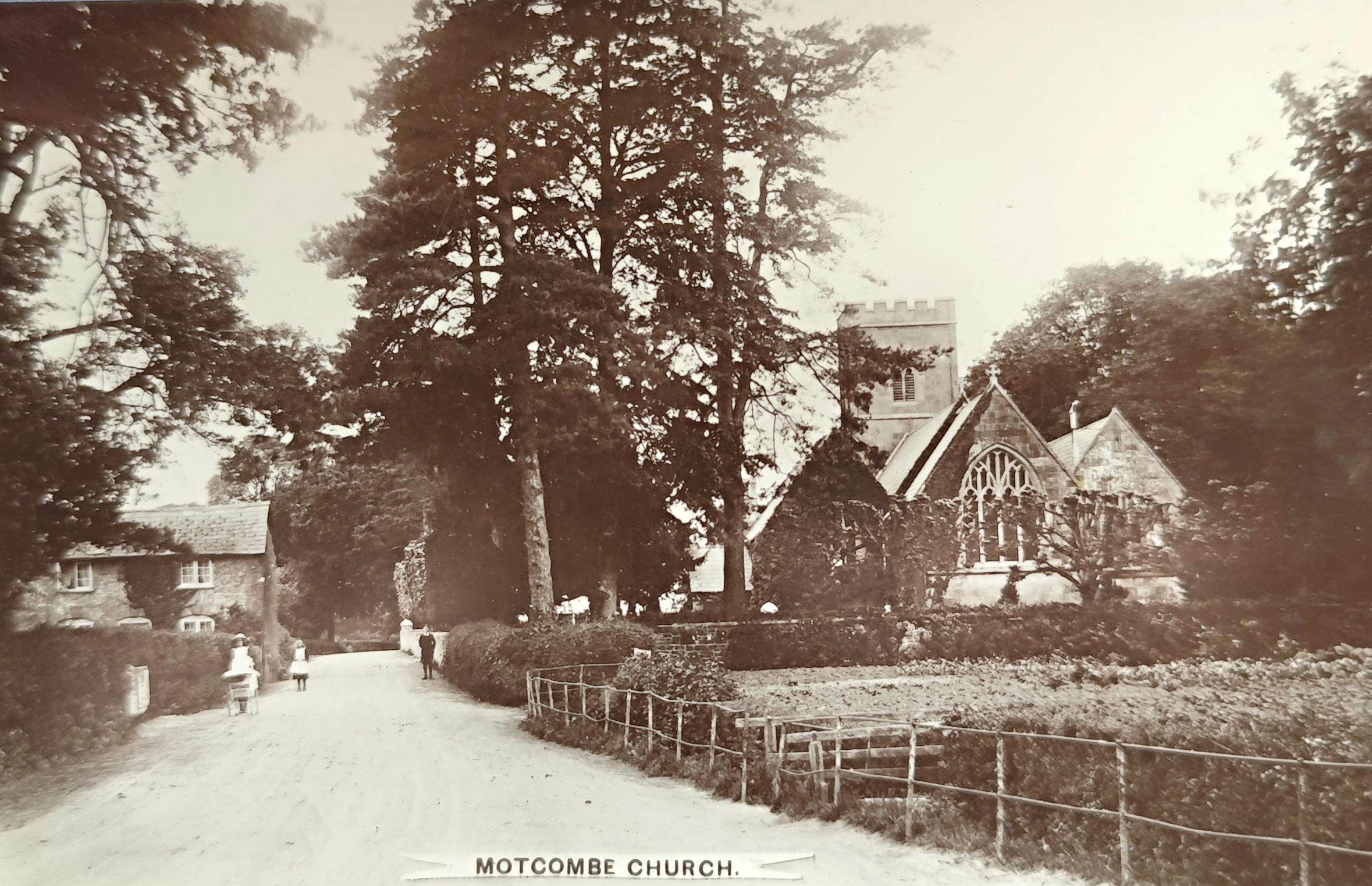
The church is still there - just no longer visible from the road!
The iron railing is still present today – it’s apparent how much lower the road level used to be.

In his 1937 Shell Guide to Dorset, Michael Pitt-Rivers is rather unimpressed with Motcombe: ‘A sprawl of cottages, some old but mostly new. A large symmetrical church (St Mary) built ... in 1848. Dark trees without; cream-wash and pitchpine within. A few dim medieval features incorporated. One brownish stained glass window.’
The ‘dark trees without’ theme remains to this day, obviously! Motcombe House, now Port Regis Boys’ School, was built in 1893 by Sir Ernest George for Lord Stalbridge in an Elizabethan manner with red brick and a Tudor-style tower.
The Year Clock brings William Barnes, Dorset’s self-educated teacher and parson, to life through notes, anecdotes, newspaper reports, and personal letters either written by or about Barnes during his lifetime. Written in 2001 by Tim Laycock, the play explores the inner tensions of a highly educated man who chose to write in the rural dialect of Dorset, highlighting the contrast between the rapid industrialisation of Victorian England and the traditional way of life that was slowly disappearing – a theme with striking relevance today.
William Barnes was best known for his Dorset dialect poetry – most famously, Linden Lea, which was set to music by Ralph Vaughan Williams. However, Barnes himself regarded his work in philology – his study of more than sixty languages, and his search for the root of all speech – as his most significant achievement, particularly his Philological Grammar.
Thomas Hardy, Barnes’ contemporary and longtime friend, once described him as “the most interesting link between the past and present forms of rural life that England possessed.”
Similarly, Francis Kilvert who visited Barnes at his rectory in Winterborne Came in 1874, called him “the great idyllic poet of England, half hermit, half enchanter.”
The poems and songs woven into The Year Clock were written between 1835 and 1870, with the exception of the final piece, The Geate a-Vallen To, which was dictated to his daughter shortly before his death in 1886.
Accompanied by Dorset folk music, performed on the violin and guitar by Colin Thompson, the performance is a vivid, fast-paced portrayal of Barnes’ world, offering a poignant reflection on the forces of change.
Directed by Sonia Ritter, The Year Clock is a revival that connects the past with the present – it has


been performed more than 70 times to date, and could not have been written without access to the William Barnes Archive.
The revival of The Year Clock are more than a tribute to William Barnes – it’s part of an ongoing effort to preserve his legacy through the ‘Barnes for All!’ fundraising campaign. When Barnes passed away, he left a rich archive of writings, including poems, sermons, posters, woodcuts, and engravings. This invaluable collection offers a glimpse into Victorian Dorset and Barnes’ creative and intellectual world.
Now owned by the Dorset Museum and Art Gallery and housed at the Dorset History Centre, the collection has been cared for by the William Barnes Society for many years. The ‘Barnes for All!’ project aims to make this collection more accessible by cataloguing each item to international standards and digitising key documents for online access. Once completed, this digital archive will open up Barnes’ life and works to a global audience. Scholars, enthusiasts and anyone interested in Barnes’ contributions as a schoolmaster, priest, poet and philologist will be able to explore his world in detail – bringing Victorian England and rural Dorset to life.
The campaign’s goal is to raise £35,000, and every penny from events like The Year Clock performance will go towards making the archive available for future generations. This project not only honours the poet himself but also preserves the cultural heritage of rural England that Barnes cherished.
• 24th October, Dorchester, 7pm.
Tickets £20: DorsetMuseum
• 3rd November, Sturminster Newton, 3pm
Tickets £20: The Exchange
To learn more or make a donation, visit williambarnessociety.org.uk

For nearly 30 years, Purbeck Film Festival has been bringing the pick of new and classic films from around the world to venues and village halls across Purbeck – and sometimes further into Dorset. This year is the 29th festival and the programme is one of the most varied and exciting yet. There are special guests from across the industry, including Oscar-winning director Sam Mendes, who will be at the Mowlem Theatre, Swanage, on the opening night, 18th October, when the film is the First World War drama 1917, which he directed. There are films for all tastes, from Hallowe’en horror (Late Night with the Devil and The Shining, at the Mowlem on 31st October) to Fantastic Machine, a 2023 Scandinavian documentary that traces the invention of the camera from the first mechanical models to the latest technology (Poole Lighthouse on 23rd October).
And talking of taste, there is a lot of food – the theme for this 2024 festival is Food on Film. There will be suppers at village pubs and canapés at Creech Grange and Swanage Waterworks, alongside a feast of some of the greatest food films of all time, including Big Night, Babette’s Feast, Chef, The Taste of Things ... and more.
One of the most interesting new films this year has been selected for the gala evening at the Mowlem on Saturday 19th October – My Favourite Cake (Keyk-e mahboob-e man in Farsi) is a delicate and touching Iranian film abut the joy of sharing cake and conversation with a friend. It is impossible to comprehend why the Iranian authorities tried to ban this funny and moving film.
The Waterworks, a one-time derelict Victorian water-tower, has been imaginatively restored and is now an elegant and unusual venue. Festival films there include, on Sunday 20th October, an Ingmar Bergman double bill of The Virgin Spring and The Seventh Seal, both preceded by wine and canapés supplied by Wareham’s The Salt Pig. Another theme is the environment, with outstanding documentaries including Wilding, Six Inches of Soil and Fungi: The Web Of Life, presented by Merlin Sheldrake and narrated by Bjork, and a weekend dedicated to the unsung heroes and heroines of adventure and war films particularly, the stuntmen and women, with films featuring exciting stunts and a chance to hear from four experienced stunt people.
Films come from all corners of the globe, this year including foreign-language films from Mongolia, Lithuania, Korea, Bhutan, Turkey and Georgia. Among the special double bills and weekend events, there is a sport double bill at the Mowlem, and a
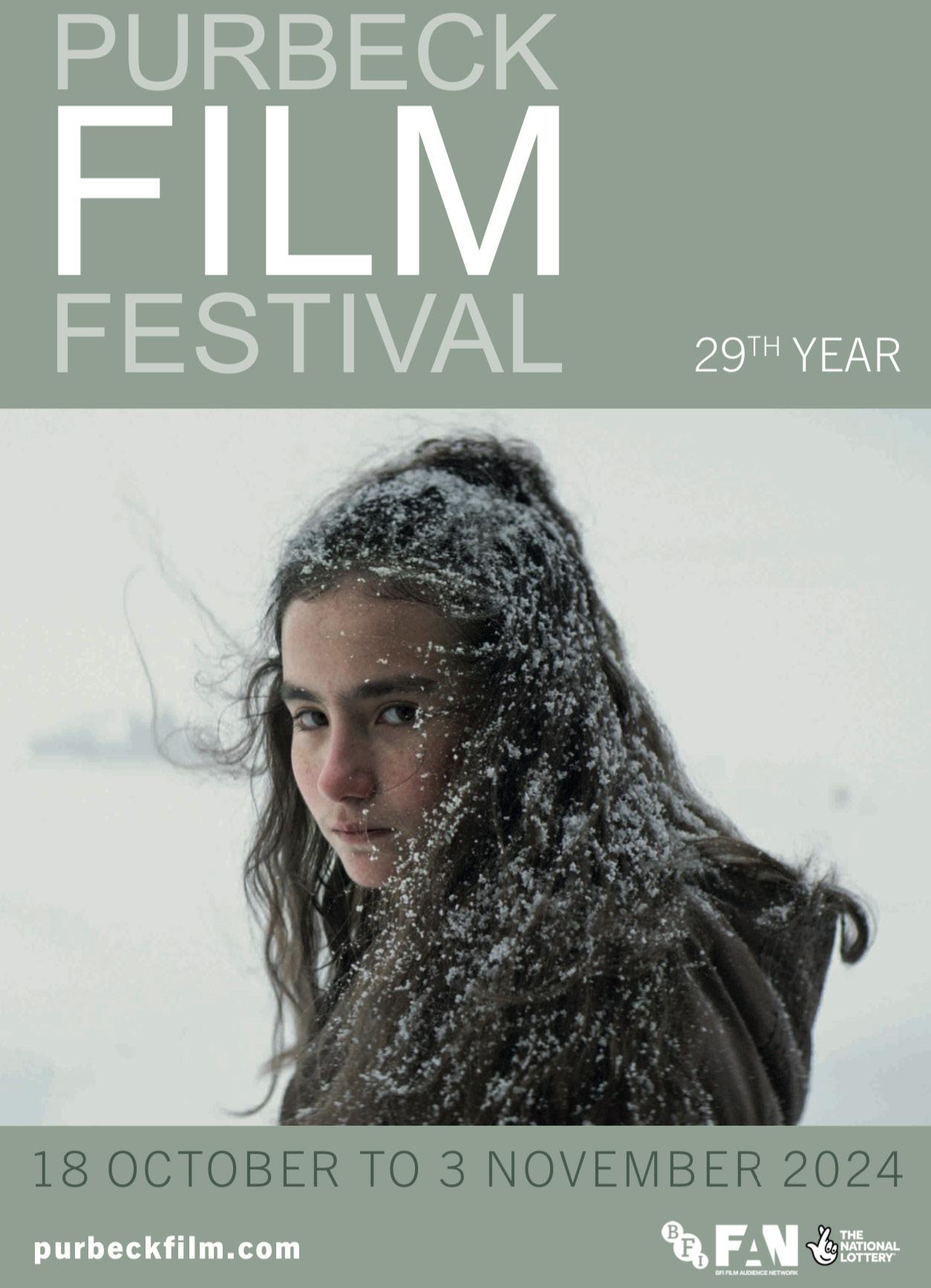
celebrations of two great directors, Ingmar Bergman and Francois Truffaut.
The oldest film being screened is 1944’s Gaslight, adapted from the Patrick Hamilton novel that gave its name to a particularly egregious form of coercive control – it stars Charles Boyer and Ingrid Bergman. The newest is Sean Baker’s Anora, which is being screened at the Mowlem on its release date, 1st November. It’s an exhilarating comedy drama about a New York sex worker who is given a way out of her life on the streets: on a whim, she marries the son of an oligarch. It is also a searing portrait of class inequality in the USA today.
For the Purbeck audience there will be a special interest in Nuts In May, a famous 1976 film by Mike Leigh, which was filmed around some of Purbeck’s most famous and beautiful locations including Corfe Castle and Kimmeridge. It’s at Corfe Castle village hall on Friday 1st November.
The festival ends with the annual Purbeck Shorts film competition, with screenings and announcements of the winners, at the Mowlem on Sunday 3rd November.
• As well as the principal venues – the Mowlem, Wareham’s historic Rex Cinema and Poole Lighthouse – films are also being shown at Carey’s Secret Garden, the Isle of Purbeck Golf Club, village halls, Dorchester Corn Exchange and Bridport’s Electric Palace.

1.45pm Cheap Street Church (unless otherwise stated)
FREE ADMISSION ALL WELCOME
13th September Meet the Music Staff
20th September Instrumental and Vocal Soloists I
27th September Pianists I
4th October Woodwind
11th October Brass
18th October Instrumental and Vocal Soloists II
8th November Singers
15th November Strings
22nd November Jazz
29th November Pianists II
6th December ‘Mince Pies’ Chamber Music (Tindall Recital Hall, Music School)



Tenors Unlimited, fondly known as the Rat Pack of Opera, will bring their new show, Great Songs Tour, to The Exchange in Sturminster Newton on Saturday, October 12th, at 7:30pm. The dynamic duo, Paul Martin and Jem Sharples, will be joined by local choir Gillingham Singers for an evening of musical entertainment that spans opera, musical theatre and pop.
The duo redefined the modern tenor by merging opera, musical theatre and classical music. The UK’s original classical-crossover “man band” have performed alongside stars such as Sting, Lionel Richie, Katherine Jenkins, Beyoncé, Hayley Westenra, Simply Red and the Royal Philharmonic Orchestra to name a few, and at prestigious venues such as the Royal Albert Hall. For 20 years, Tenors Unlimited has been entertaining audiences world-wide, bringing their own blend of wit, humour, charm and vocal arrangements to their performances. Fresh from a UK and USA tour, captivating audiences on both sides of the Atlantic, Tenors Unlimited promises an evening filled with fabulous harmonies and fun repartee.
Jem says, ‘There’s something for everyone in our new show – from Puccini’s Nessun Dorma to


Freddie Mercury’s Barcelona, The Pearl Fishers’ Duet and songs from The Greatest Showman. We’ve also included some of our own compositions.’ Their entertaining blend of popular classics, crooner hits and original songs makes for a unique, memorable performance.
In 2019, Tenors Unlimited won the Broadway World Best Touring Show Award in the USA, and their single Who is He? topped UK charts in aid of The Salvation Army.
• 12th October, 7:30pm, adults £24. For tickets, see stur-exchange.co.uk

Get ready for some ghostly fun as the Museum of East Dorset in Wimborne celebrates Halloween and half-term week with its special Spooks and Spectres Museum Trail!
From Saturday 19th October to Saturday 2nd November, visitors of all ages can become ghost hunters, track down spirits and uncover some of East Dorset’s spookiest local legends.
Alongside the haunted trail, junior visitors can enjoy hands-on activities, including colouring, crafts, and dressing up in spooky costumes.
Aidan Hill, programming officer for Museum of East Dorset says: ‘It’s been brilliant researching the ghosts of Wimborne. I’ve talked to lots of local businesses and it seems Wimborne is still very popular with inhabitants from its past!
‘The Oddfellows pub in Church Street has a poltergeist called George, a pint-pulling prankster who gets up to mischief behind the bar. The ghost of Granny Snow, the last resident at No 9 on the Green before it became a tearoom, is known to rattle many a teacup and rearrange the kitchen!
‘And of course, the museum itself has its own resident ghost! There have been reports of strange murmurings at the bottom of the main staircase, a








man being seen surrounded by newspapers in our second-hand bookshop and books being thrown off the shelves during the museum restoration a few years ago.
‘There are so many spooky local stories that adult visitors can enjoy, and our ghost trail will appeal to children of all ages as they can join in the spooky hands-on history activities!”
The Spooks and Spectres Trail is FREE to all paying visitors, with children under four gaining free admission. Entry prices are £5.50 for children aged 5 to 16 and £12 for adults, with family tickets available. And a ticket grants 12 months of free reentry to the museum.
• For more details museumofeastdorset.co.uk or call 01202 882533.
In this special free spin-off evening to the Dorset Scriptwriting Festival, writers and anyone interested in scriptwriting can enjoy work by local scriptwriters Sue Ashby and Craig White, delivered by their chosen actors, alongside film contributions from actors, playwrights and directors including Mark Rylance, Patrick Marber and Beth Flintoff. The evening will also feature a Q&A with festival director Ed Viney, where you can find out more about the next Dorset Scriptwriting festival in 2025, and how you can be involved.
The Exchange is hosting this event in partnership with Artsreach and Dorchester Arts Centre, and the event is free to attend, though booking is advised and donations to The Exchange will be welcomed. The Bibbern Gallery Bar – currently showing a photographic look at Dorset landscape and wildlife by Marilyn Peddle – will be open from 6.30pm and for discussion after the programmed event. Further information is available by contacting The Exchange on 01258 475137, or by visiting the Exchange website.
Turk(ish)
The next Artsreach event at The Exchange is an empowering autobiographical show by

contemporary circus artist Poppy Plowman, on 29th November, with a tightwire workshop session available on the same day. The Exchange is immensely grateful to William Fox-Pitt and Alice Plunkett for a fascinating illustrated conversation about a glittering career in eventing presented to a large and enthusiastic audience, all for the benefit of The Exchange. The next fundraising event will be a Quiz on 24th October – why not get a team together and give it a go.
• stur-exchange.co.uk/whats-on
Shaftesbury Arts Centre’s Music and Drama Group is thrilled to announce their highly anticipated autumn show, *Rehearsal*, an original dark comedy with a supernatural twist, written by the talented local playwright, Steve McAuliffe. The show will run for three nights, 17th to 19th October, promising an unforgettable experience that blends humour, chaos and a touch of the unworldly. Set in the crumbling remains of a once-grand theatre, now slated for demolition, *Rehearsal*

follows the tumultuous behind-the-scenes drama of a group of mostly washed-up actors attempting to pull together a play. However, the production quickly descends into disorder and, spookily, ghosts of former performers start to make their presence known, adding a sinister, surreal twist to an already chaotic situation.
*Rehearsal* is a must-see for anyone who loves theatre and enjoys the thrill of dark comedy. The cast, directed by Joni de Winter, features an outstanding group of local talent, who bring McAuliffe’s quirky and flawed characters to life.
Friday night special
As a special treat, Friday night’s performance on October 18th will include a post-show Q&A session with Steve McAuliffe in person, interviewed by Joni De Winter, and promises to be an invaluable experience for theatre enthusiasts.
• Tickets for *Rehearsal* are £12.50, and available from shaftesburyartscentre.org.uk, or from the Shaftesbury Arts Centre box office on 01747 854321, 10am to 12.30pm (not Sundays).
Bournemouth’s biggest fireworks party is set to be louder and brighter than ever on Saturday, 2nd November, as Oasiss, one of the UK’s top Oasis tribute bands, headlines the live entertainment. Taking place at the Littledown Centre, Bournemouth Fireworks promises a triple display to light up the sky and plenty of music to get everyone in the party mood.
‘There’s no Definitely Maybe about it – we’re celebrating the Oasis reunion by sending a real Champagne Supernova into the sky from Bournemouth Fireworks!’ says event director Michael Callaghan. ‘And unlike the amazing fireworks, our prices are anything but dynamic. We’ve held our prices steady for the last three years.’
Early bird tickets are now on sale, with family tickets available for just £27 – a £7 saving on gate prices. Adult tickets are £8, children’s tickets are £4.50, and under-3s go free.
Gates open at 5.30pm, and collection baskets will be available to support the event’s charity partner, the RNLI, celebrating its 200th anniversary.

Three displays
The night will have three fireworks displays: 7pm, 8pm and culminating in the famous White Knuckle display at 9pm, the biggest and loudest display in the south! Beyond the fireworks, there’s live entertainment from the amazing fire performers before the 7pm and 8pm displays, and an all-new live music arena.
• Firework displays at 7pm, 8pm, 9pm littledownfireworks.co.uk
This October half-term, families across Dorset can enjoy an array of entertaining shows filled with puppetry, live music, and interactive activities, thanks to rural arts charity Artsreach. With mischievous goats, a playful puppy, and a cheeky magpie, there’s plenty to entertain!
The Goat Show
In a countryside corner not too far away, goats are causing mayhem, stealing sandwiches and munching on flowers. Running Dog Theatre brings The Goat Show to Sixpenny Handley (01725 552812) at 2pm on Saturday, 26th October. It’s a fun-filled adventure with puppetry, storytelling, and music about goats, overcoming conflict, and competitive poo collecting! A week of goat-themed activities will also lead up to the show.
Oskar’s Amazing Adventure
Fideri Fidera presents Oskar’s Amazing Adventure, the award-winning story of a fun-loving puppy seeking playmates in the snowy Alps. Suitable for ages 2-7, the show is packed with storytelling, clowning, puppetry, music, and song. Meet Oskar
at Milborne St Andrew Village Hall (01258 839060) at 2pm on Monday, 28th October; Hinton Martell Village Hall (07476 020522) at 11am on Tuesday, 29th October; and Powerstock Hut (01308 485730) at 11am on Wednesday, 30th October. After each performance, a drama workshop inspired by themes of hibernation will be held – places are limited, so booking is essential.
Scarlet Oak Theatre returns with Along Came a Magpie, a heart-warming adventure featuring puppetry, plants, and lots of pots! The gardener’s peaceful potting shed is turned upside down by a mischievous magpie.
Find them in Buckland Newton (01300 345431) at 10:30am on Wednesday, 30th October, and Wootton Fitzpaine (01297 560948) at 10:30am on Thursday, 31st October. Each show is followed by a fun puppetry workshop – book your place early to avoid missing out.
• For further details on all Artsreach events, please see the website – artsreach.co.uk




busy collecting the pollen on an ivy flower

It’s the unsung hero of autumn: as other blooms fade, ivy flowers offer insects a final feast before winter, says wildlife writer Jane Adams
As we quietly slip into autumn, with fewer hours of daylight and cooler temperatures, many of our flying insects are making their last farewells. Of course, not all are nearing the end of their lives: some, like bumblebee queens, will tuck themselves away until warmer weather returns. But before they go, there’s time for one last hurrah.
butterflies with their hankie wings, as well as wasps, hornets, ivy bees and fluffy yellow and black virgin queen bumblebees.
It’s approaching sensory overload, I admit, but there’s a wonderfully rowdy and friendly festival vibe.
There’s a rowdy and friendly festival vibe
With the vibrancy of spring and summer faded, it can sometimes feel like winter is approaching fast. Happily, October still has a few surprises tucked up her sleeve – and one of those is the humble ivy, or, more specifically, its flowers. I know what some of you are thinking. Ivy? Has she lost her mind? Bear with me.
Ivy is easy to dismiss as an invasive weed which rampages through gardens and smothers everything. However ... sometimes that smothering is exactly what’s needed.
We have a dead apple tree in our garden. Many years ago, it became the scaffolding for an ivy with high-rise aspirations. Gradually, the ivy crept up the trunk of the old tree, until one autumn it reached a height of about six feet ... and flowered. It can take ivy up to ten years to reach maturity and bloom, and even then, it will only do so when it gets enough sunlight ... but wow, when it does, you’ll know about it. If I step into the garden on a sunny day in October, I can smell the honeyed fragrance of the ivy flowers before I even see them. As I get closer, the ivy’s firework-like blooms explode with a myriad of colours, shapes and species of insects: black, yellow and orange marmalade and hornet hoverflies, comma and tortoiseshell
So, when the sun shines this month – as we all hope it will – I encourage you to go in search of a flowering ivy and immerse yourself in this autumn phenomenon. But be quick. This performance is over in the flap of a wing and the stare of a compound eye.

Farming columnist George Hosford had surprise farm guests this summer, prompting a delicate rescue before harvest
Before we could start harvesting this year, we had the small matter of owls in the combine spout to deal with. In May, a barn owl had been spotted entering and leaving the unloading tube of the combine parked up in the tractor shed. We were told it was likely to be a solitary male, and best left to find a new home. As is so often the case, things turned out rather differently.
Several weeks later, as the days were getting longer and the yard was quieter at dusk, we had forgotten all about it … then some odd noises were heard coming from the combine.
More advice was taken, and this time the conclusion was that perhaps there might be chicks in the auger tube.
What kind of crazy bird would lay eggs down a cold metal tube filled with a twisty metal auger? It was also a bit of a problem. No one wants to disturb young chicks, but harvest was rapidly approaching, and we needed to run up the combine to check all was working.
But we clearly couldn’t risk mangling up any chicks, so we eventually decided to slowly turn the auger manually, and see if we
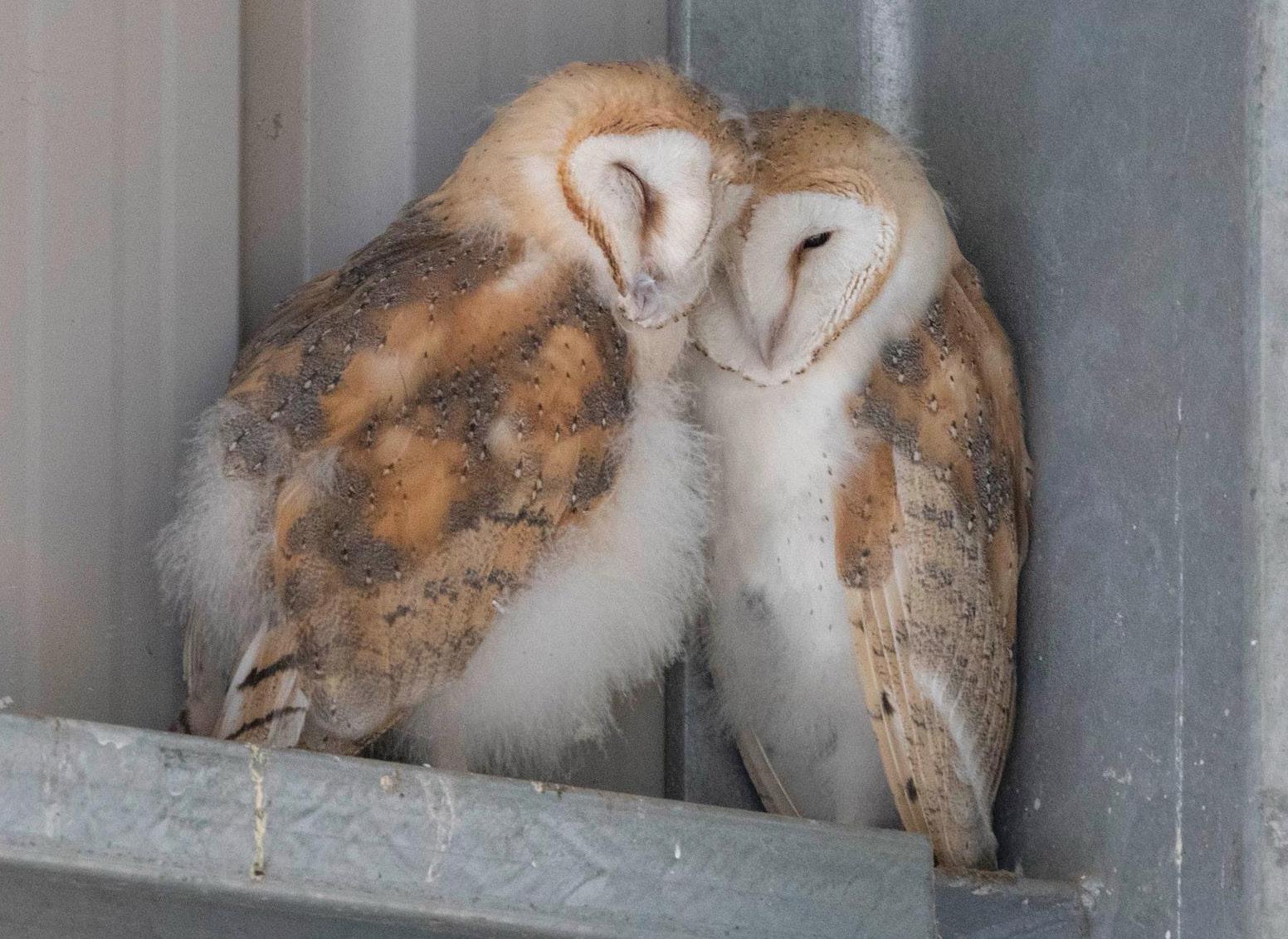
could persuade anyone in there to come out.
Sure enough, gradually coming into view were the pale brown feathers of a young barn owl, who we managed to catch and move into the owl box recently installed in the tractor shed.
The number of turns on the pulley that drives the auger meant that the nest must have been at least a metre down the tube. Was there going to be another? We turned the auger a few more times, just in case,

and hey presto, out came chick number two!
When I say ‘chick’, I really mean beautiful, fully feathered young adult barn owls – they must have been on the cusp of fledging. Seeing as they couldn’t possibly have ever seen daylight, they coped remarkably well. How they would have found their way out of the auger tube, a metre or more from the open end, without our assistance, is a good question. And if we had not heard them, and had thrown the auger into gear a few days later, they would have been history. Fortunately, we managed to get them both into the owl box. The next morning they had managed to jump/fly out and were perching on the wall bars of the shed. After a day or two hanging around and doing some flying practice, they disappeared from the yard, but they have been seen locally on numerous occasions. We think their parents had kept them fed throughout, and will no doubt have taken them out for hunting lessons.


From free roaming cattle to thriving wetlands – rewilding efforts at Wild Woodbury are enhancing
Three years into Dorset Wildlife Trust’s rewilding project at Bere Regis, Wild Woodbury has become a beacon of environmental restoration and community involvement. The site is thriving thanks to its pioneering initiatives, including the introduction of free-roaming livestock, transformative river restoration and inspiring community efforts, the site is thriving.

One of the standout achievements has been the introduction of free-roaming livestock. In partnership with a local farmer, Wild Woodbury has welcomed Hereford cattle, Exmoor ponies and Mangalitsa x Berkshire pigs to the 170ha. They all play a key role in the natural management of the landscape. Their grazing, rootling and browsing creates a dynamic habitat, enhancing biodiversity and allowing a wide variety of plant species to thrive.
Wild Woodbury has recorded an astonishing increase in wildlife, with more than 1,900 species now identified on-site – an uplift of 600 species since the project began – and small mammals like harvest mice and water shrews have flourished.
The small mammal abundance has in turn benefitted reptiles and birds of prey, and we have now recorded four out of the UK’s six native reptiles on site: slow worm, grass snake, adder and common lizard.
The ambitious Stage Zero* river restoration work carried out in year two has allowed water to follow its natural course, creating new wetlands across Wild Woodbury that support species such as frogs, dragonflies and wetland birds like common snipe and lapwing.
In fact, all birdlife at Wild Woodbury has thrived.
Regular bird-ringing sessions revealed that 40 different species were ringed in the third year alone, including nightingales and pied flycatchers. Birds of prey such as red kites, sparrowhawks and peregrine falcons are now frequently spotted, drawn by the increase in small mammals. The project has also improved the water quality. Regular water testing, conducted through taking monthly water samples across the site, has shown that levels of nitrogen, phosphorous and suspended solids have decreased across Wild Woodbury, helping to prevent these nutrients from entering the watercourse which feeds internationally-significant Poole Harbour. It has been wonderful to witness the local community actively engaging with Wild Woodbury. A new car park and 13 hectares of open-access land have enhanced public accessibility, allowing more people to explore the site. Guided walks and educational tours about rewilding have proved hugely popular, helping visitors to connect with nature and understand the principles behind this ground breaking project.
Three years in, Wild Woodbury stands as a shining example of how rewilding, supported by community efforts, can restore landscapes and create rich, biodiverse ecosystems.
• To learn more about Wild Woodbury, three years on, visit: dorsetwildlifetrust.org.uk
* Stage Zero restoration works to restore a waterway to its natural floodplain, stream processes and ecosystem, producing remarkable benefits to river health, heritage, wildlife, sustainability and resilience.
This nightingale is just one of the 40 different species ringed at Wild Woodbury in 2024


A happy pair of Wild Woodbury’s free-roaming heritage breed Mangalitsa x Berkshire pigs. Pigs are widely used to improve the biodiversity of land where a few species have come to dominate. They can also help eradicate invasive species, without the environmentally damaging effects of heavy machinery and chemicals. Image: Rob Farrington
Take a Hike:
10.5 miles

This is a day’s walk (we took a relaxed four hours, with some nice stops along the way) which sets out along the South Dorset Ridgeway with fine views, and follows quiet paths taking in the Kingston Russell stone circle and the less-walked areas that sit behind the popular coast path. The benefit of heading to one of Dorset’s most popular walking areas is that it has wellmaintained gates at all points (no tracking up and down the hedge, looking for that stile which is buried in a season’s bramble growth). No map stress means a relaxed stroll taking in the amazing views from almost every point of the route. The first half will no doubt be busy in summer months, but in the autumn we have the whole route to ourselves – the second half is away from the better-known routes, and will be quieter even during busier seasons. The Kingston Russell stone circle is our preferred
sandwich spot: it’s a late Neolithic or Bronze Age stone circle consisting of 18 stones (we’re not talking Stonehenge, they’re moderately unprepossessing small boulders) and they sit on a hilltop overlooking the Jurassic Coast. They are never busy as they’re only accessible to walkers. The route is very exposed to the sea, so be sure to go prepared for the wind, and be aware that any rain will come in sideways! There are lots of chalk paths, too, which become slippery after rain. Parking is easy in the Hardy Monument car park –it’s National Trust, so only free for members, and it’s open dawn to dusk. If you can, park on the far edge overlooking the sea, and then it’s a perfect spot to sit with a flask of hot chocolate at the end of your walk!
• CLICK HERE for more images, an interactive map and a downloadable .gpx
• See all previously-published Dorset Walks on the website here. You can also find every route we’ve walked, including many which are unpublished in The BV, on OutdoorActive here (just zoom in/out on the map) – all include a downloadable gpx file.




Shakin’ off the day, one droplet at a time Annette Gregory
Ready for his close up Dave Taylor




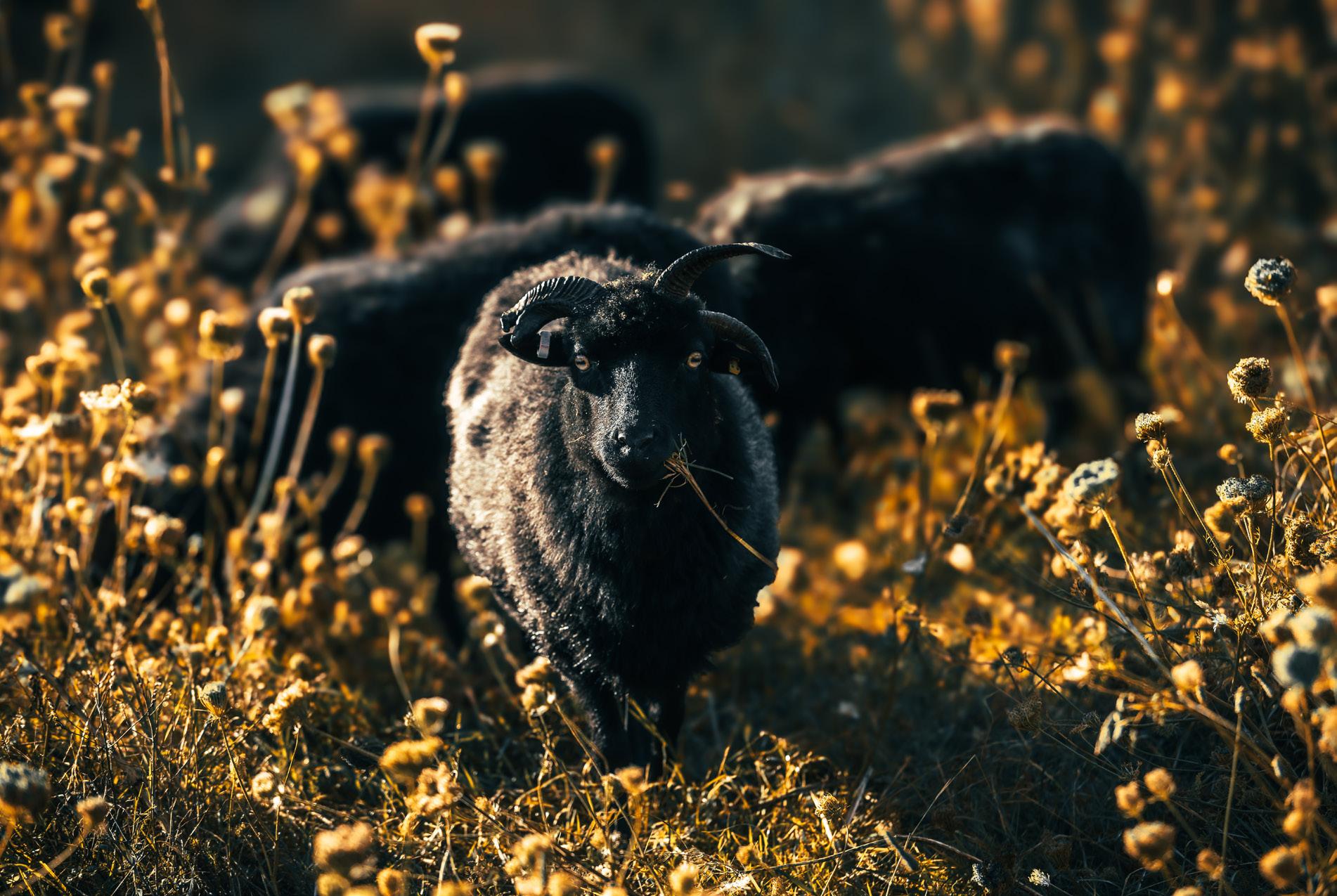

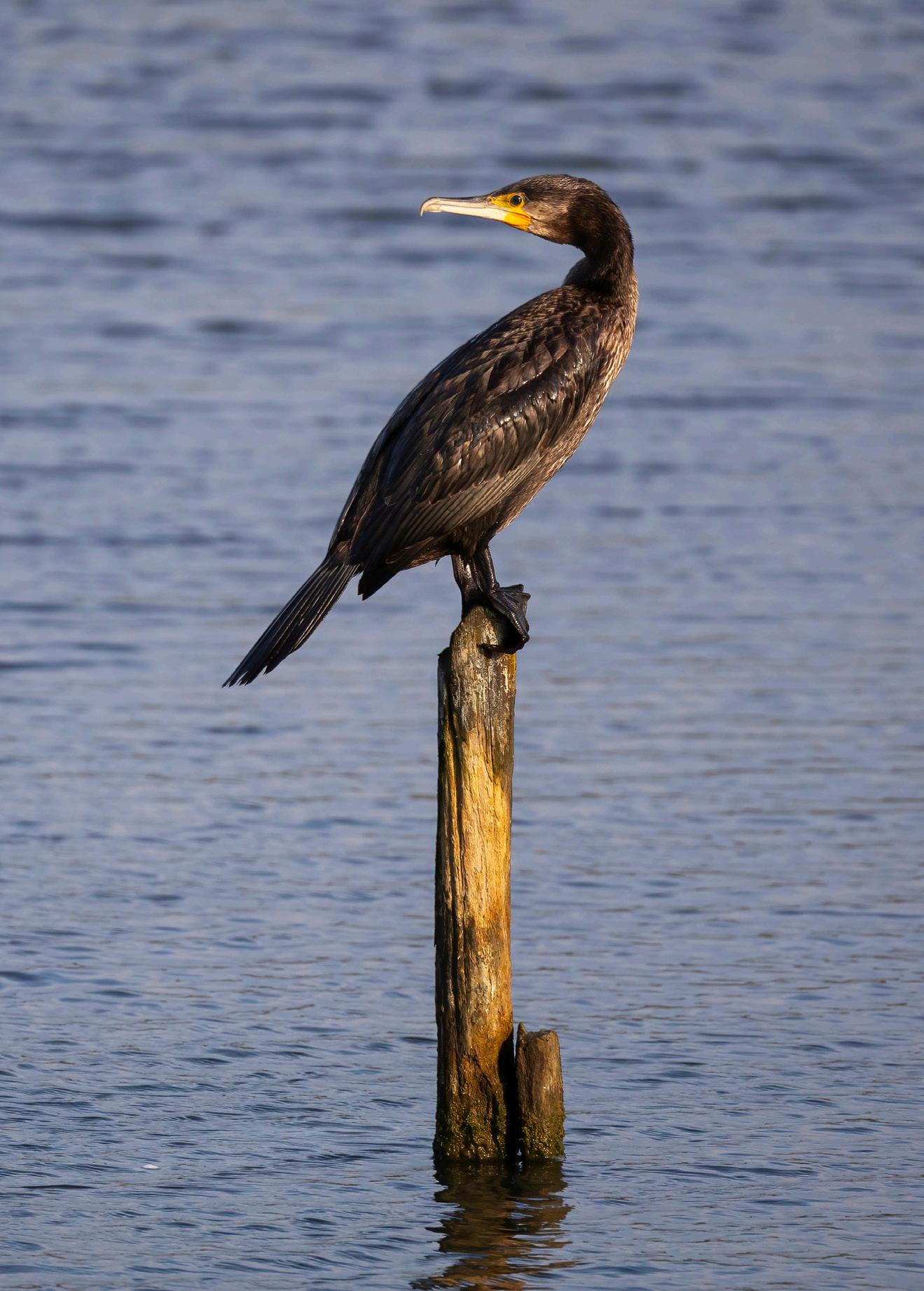
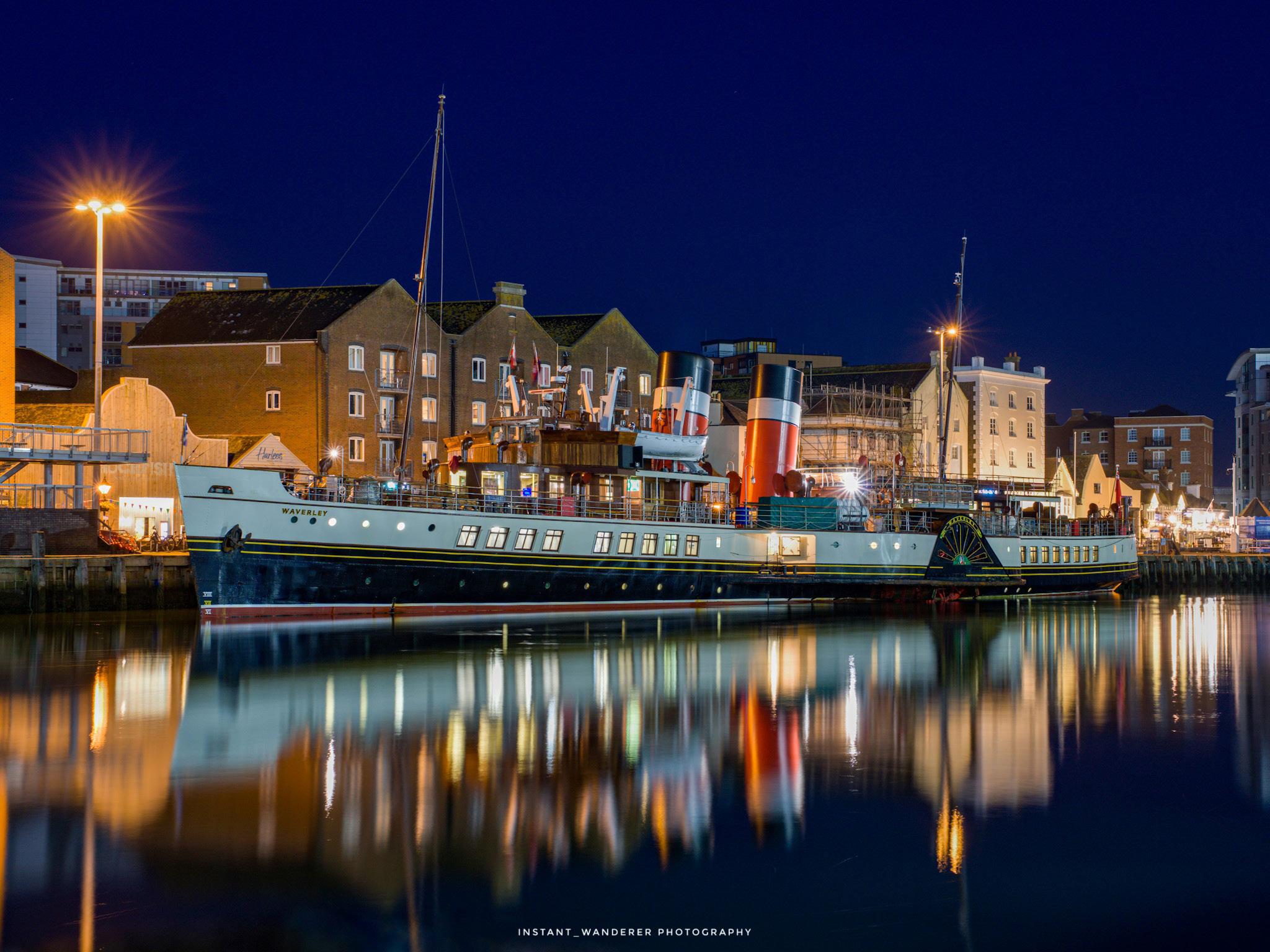
We welcome photography submissions from readers – the only rule is that they must have been taken locally in the last month. Our cover shot is always selected from our submissions pile. If you’d like to join in, please share it in The BV community Facebook Group or simply email it to us on photos@bvmagazine.co.uk
Dunn Sun-kissed Mike Howson





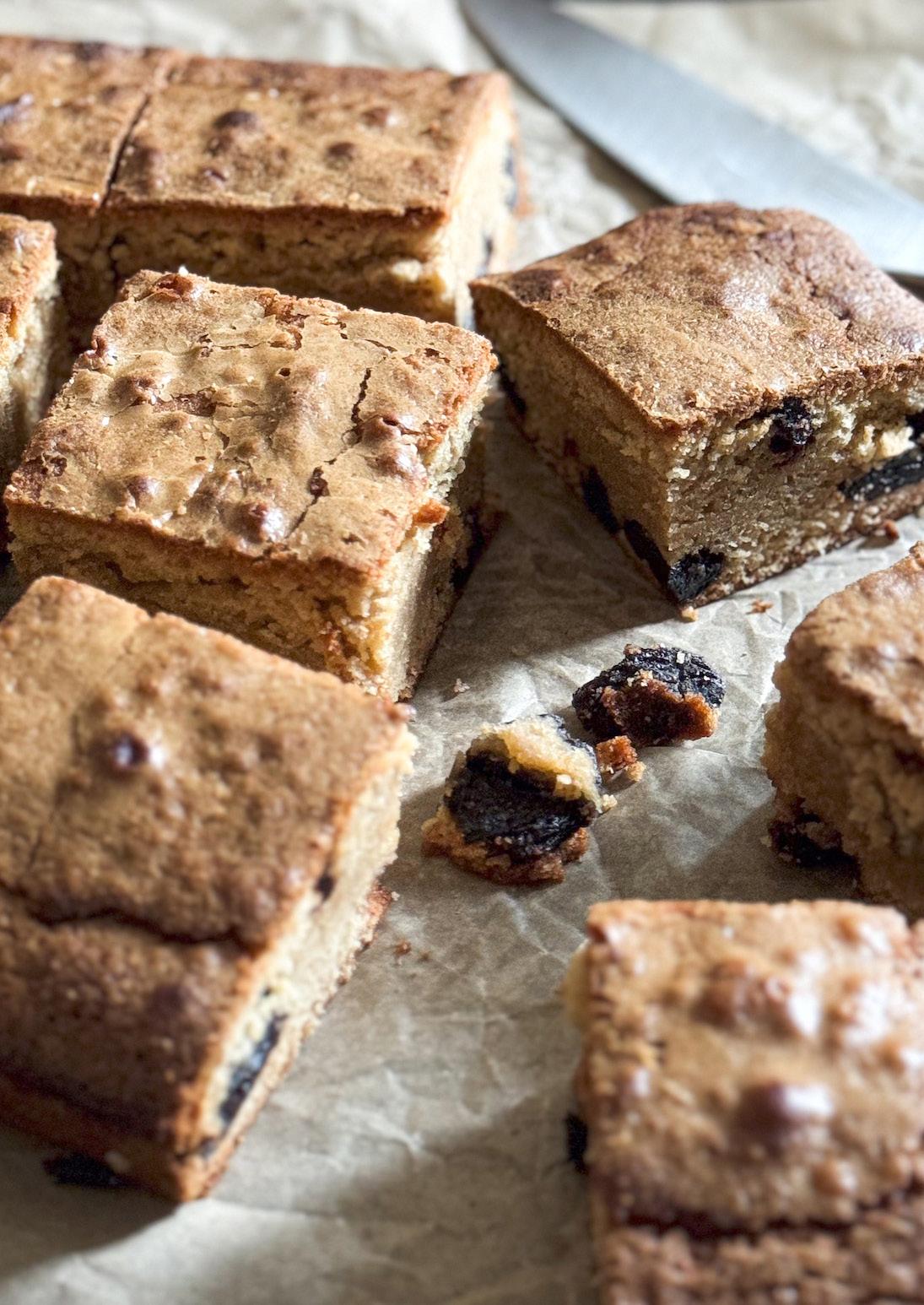
by Heather Brown
A blondie is the brownie’s fairer sister: and while the texture can be similar, the delicious, caramel flavour of a blondie comes from soft brown sugar. In this recipe, I have used dried cherries because they bring a tiny amount of sourness to offset some of the sweetness. You can find these in some supermarkets (definitely Sainsburys and Waitrose) and in health food stores or online. These are wonderful with a cosy cup of tea when it’s cold and/or wet outside: perfect for our current autumn weather!
– Heather
• 12oz/340g soft brown sugar
• 6oz/170g butter
• 2 eggs
• 1tsp vanilla extract
• a good pinch of salt
• 7oz/200g plain flour
• 8oz/225g dried cherries
1. Pre-heat the oven to Gas 6/180º fan. Grease and line an 8” x 8” (20x20cm) baking tin.
2. In a saucepan, gently melt together the butter, sugar, salt and vanilla extract, and mix until smooth. Take the pan off the heat and mix in the two eggs.
3. Gently fold in the flour and then stir through the cherries.
4. Pour into your baking tin and bake in the oven for 35-40 minutes. When you move the tin, the middle shouldn’t ‘jiggle’ and the top should have lots of cracks.
5. Allow to cool in the tin.

We were thrilled to host some of Dorset’s finest producers at the 2024 Love Local Awards. Founded six years ago, the LLTL campaign promotes trust in local, British produce and food labelling, valuing quality, honesty, and proximity. Every entrant’s journey was inspiring, making judging tough. This year’s winners:

1. Barbara’s Kitchen
Barbara’s Kitchen, based in Dorset, creates award-winning chilli preserves using homegrown chillies. Rupert, Barbara’s husband, grows a variety of chillies from seed, planted in January and harvested in autumn. Handmade in a traditional one-pan method, all preserves are vegan, gluten-free, and perfect for cheese or charcuterie boards
2. Honey by Ian
With hives in Ringwood, Alderholt and Ferndown, this family business produces smooth, local honey in limited quantities. Caring for honeybees and ensuring their safety is a priority, and knowing exactly where their honey comes from brings joy and motivates them to grow further.
3. Coastline Soaps
Living and working on Dorset’s stunning Jurassic coastline inspires every soap design. Each fragrance reflects the beauty of the area, from fresh herbs by the river to breezy beach days. With new scents and designs always in the works, there’s a soap for everyone!

4. The Book and Bucket Cheese Company
Founded by Peter Morgan, The Book and Bucket Cheese Company began with the aim of making small, high-quality cheese batches for local restaurants. Inspired by industry advice and “bucket science,” Peter launched the company in 2019. Now, his award-winning cheeses are available on Cunard liners as well as outlets across the South West.
5. The Wimborne Pig
The Wimborne Pig is a small, modern British restaurant with a big heart, focusing on locally sourced, seasonal ingredients. Menus change regularly to showcase Dorset’s fresh produce. With professional yet laid-back service, guests are welcomed and made to feel at home from the moment they arrive.
Sophie, founder of Farm Girl Sausages, creates high-quality meat and vegan products in the Dorset village of Holt. With natural ingredients, gluten-free recipes, and eco-friendly packaging, the award-winning sausages and burgers are made without fillers. Supporting British farmers,
they offer both meat and plant-based options for everyone to enjoy.
7. Purbeck Cider
Nestled in Dorset’s Purbeck hills, this cider maker crafts premium ciders using 100% singlepressed British apples, including those from their own orchards. Made traditionally without artificial flavours, additives, or concentrates, their ciders are naturally delicious and full of flavour, just as the apples intended.
8. Lizzie the Baking Bird
Passionate about Dorset’s produce and producers, this baker loves bartering bread for fruit and foraging for wild garlic and elderflower. Starting in the bakery at 3 or 4 am to bake fresh bread is all part of the joy – competing with deer for the best fruit each year is just a bonus!
9. Ellie’s Farm Shop
Ellie’s Farm Shop continues Kilnyard Farm’s legacy of locally sourced, farm-fresh produce. Inspired by the generations of family farming and her father’s dedication, Ellie established the shop to bring the best farm-to-fork goodness to customers, honouring the history and passion of Kilnyard Farm.
10. South Paddocks Ltd
A family-run smallholding in the Winterbourne valley, South Paddocks offers farm visits, alpaca experiences, and pedigree pork, goat meat, and eggs. With a “paddock to plate” ethos, all animals are reared and finished on the farm, maintaining high welfare standards and low food miles. Proudly representing Dorset’s finest produce.
11. Relenka Sweet Treats
Lewis bakes small batches of fudge using the best ingredients, locally sourced when possible. With heart and soul poured into every creation, his fudge often surprises even those who don’t usually like it – a testament to its exceptional taste and quality, as shared by delighted customers.
12. Shroton Fair Gin
After postgraduate study, Wilfrid returned to his Dorset village to perfect the taste of Zummit Dry®. After many trials, Shroton Fair Gin® was born. Every step—from crushing botanicals to distilling, labelling, and emailing—is done by Wilfrid himself in his workshop under Hod Hill.
13. Parkstone Fisheries
A team of four friends with over 100 years of combined experience, Parkstone Fisheries proudly offer the best quality fresh fish, shellfish, and smoked fish.
Supporting local fishermen and responsible sourcing, their shop guarantees exceptional quality and flavour. Even their smoking wood is sourced locally to enhance their products.
14. The Little House
This small Dorset business creates highquality chocolates with a focus on supporting local. Run by a dedicated duo, they handle everything—from production to design and customer relations—bringing joy through sweet treats. Though not always easy, their passion for introducing exciting flavours and sharing Dorset’s best is truly rewarding.

by Fanny Charles
Mike and Judy Smales of Lyburn Cheese, who won the Golden Fork for Best English product. All images by Sam Pelly, © the Guild of Fine Food
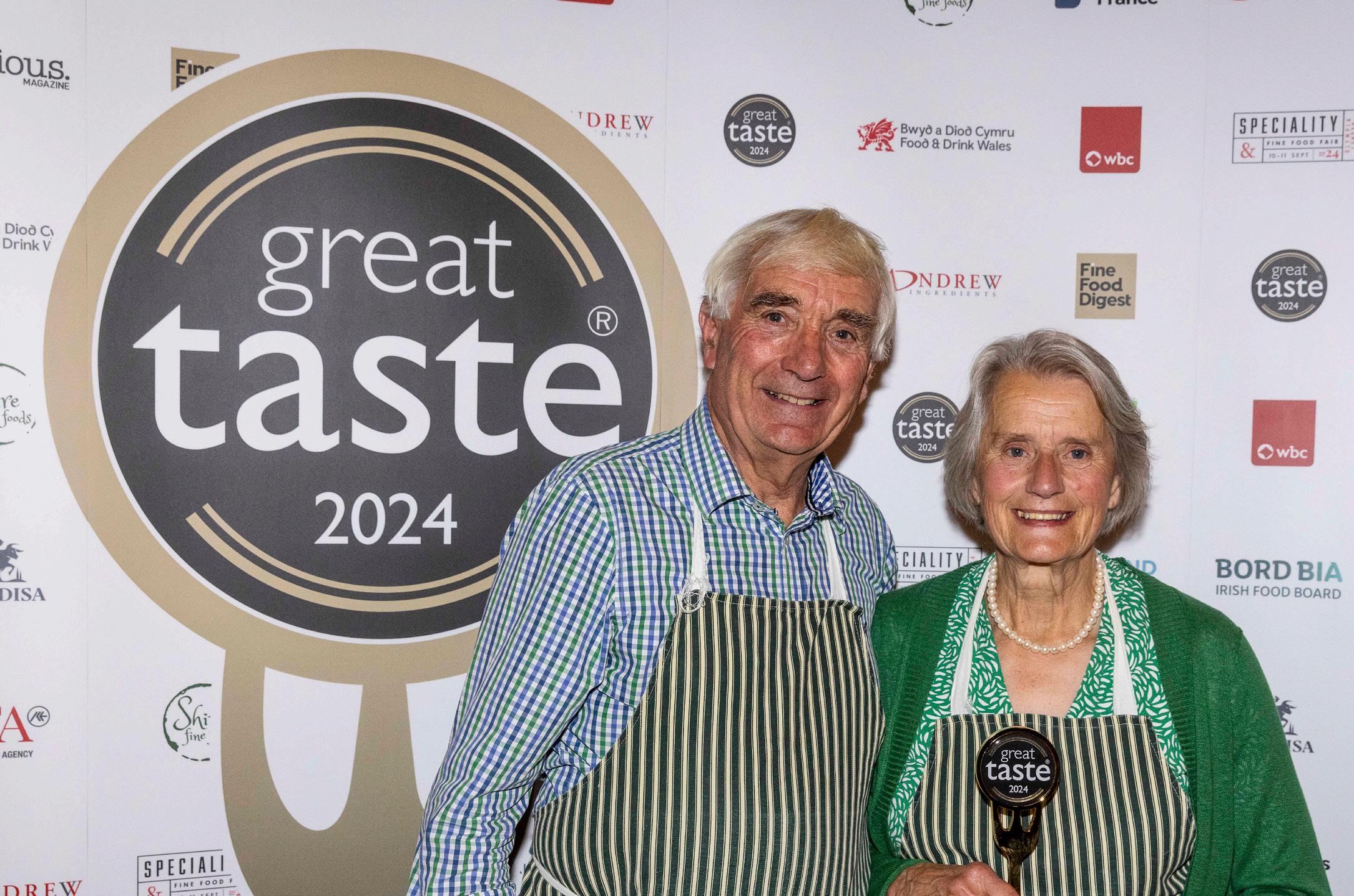
Local cheese-makers Lyburn Cheese took home the Golden Fork for the best English product at this year’s Great Taste awards night
Battersea Arts Centre might not be an obvious destination for foodies, but for the second year this ‘centre for the extraordinary’, which is celebrating its 50th anniversary in 2024, hosted the Golden Forks evening, the annual presentation of the top Great Taste awards – the best tasting products from around Britain, Europe and the world. Arguably, it is one of the most important events of the year for artisan, specialist and fine food producers.
The building, originally Battersea Town Hall, dates from 1893 and was imaginatively restored after the Grand Hall was seriously damaged in a massive fire on Friday 13th March 2015. It provided an atmospheric and spacious setting for the awards, which featured the cream of this year’s three-star winners, ranging from sea salt made in a blackthorn-tower on the coast of Ayr to the Supreme Champion, a thyme honey from bees on the island of Crete.
in Gillingham, with a second home near Borough Market in Southwark. This year’s 266 three-star winners were selected over weeks of blind tasting by judges drawn from across the food industry – cooks, food writers, journalists, food buyers, restaurant critics, producers, instagrammers and more – from a total of 13,672 entries.
The 266 three-star winners were selected through blind tasting by cooks, food writers, journalists, food buyers, restaurant critics, producers, instagrammers and more, from a total of 13,672 entries
The awards are run by the Guild of Fine Food, which started life in Wincanton and is now based
After further rounds of judging, the award-winners, including the supreme champion, are selected from the finalists. These included Lyburn Cheese, made by Mike and Judy Smales, using milk from their own herd at their farm on the northern edge of the New Forest, near Salisbury. Their three-star Stoney Cross, a mould-ripened semi-hard cheese, went on to be named the winner of the Golden Fork for England. This is wonderful news both for artisan cheese-makers across the country and for our region specifically – and it had a special resonance for me. I grew up in the New Forest, and learned to drive at Stoney Cross – an RAF bomber
and combat fighter airfield during the Second World War. In the 1960s it could still be used to practise your steering, reversing and other driving skills! Mike and Judy were thrilled: ‘We didn’t see that coming!’
The family has been dairy farming at Lyburn Farm since 1952, and started making cheese in 1999 to add value to their milk. Their other cheeses include Lyburn Gold, a washed curd cheese a little like Gouda, which is ripened for eight to 12 weeks; Winchester, a rich creamy cheese which has some of the nuttiness of Cheddar; Old Winchester (also called Old Smales), a harder, distinctively nutty and very versatile cheese which can be used in dishes where you would use Parmesan; Lyburn Lightly Oak Smoked; and Lyburn Garlic and Nettle, made to the same recipe as Lyburn Gold, but ripened for a shorter period.
Another local cheese-maker, Peter Morgan of The Book and Bucket Cheese Company at Cranborne, won three stars for his Cranborne Blue.
Other Dorset three-star winners were Baboo Gelato at Rampisham for their double chocolate gelato, Brassica Dorset, at Beaminster, for their organic chicken, leek and tarragon pie and Dorset Pastry’s all-butter puff pastry, made at Crossways.
The most important person
Food awards are generally rather formulaic affairs, with a guest presenter – often a celebrity from the food industry – and a lot of those reality televisionstyle faux climaxes, when there is a heavily pregnant pause after the names of the finalists are read out “and the winner is ...” These awards can feel as if they exist solely to make money for the organisers (which is often the case), rather than to reward quality and hard work.


The ethos of Great Taste has always been that the artisan producer is the most important person, and the awards are a way of helping them to reach a wider market.
Guild of Fine Food managing director John Farrand says: ‘It is important to understand that Great Taste is merely the process that identifies one, two and three-star winners and, in doing so, encourages makers to improve. In announcing the Golden Forks, we are celebrating the very best producers – those who take care to ensure their products hit the markers of trusted raw ingredients, simple production methods and food and drink that has personality ... but ultimately, food that tastes great. ‘We’re particularly chuffed to be doing our thing for international trade and relations by welcoming entries from 115 countries this year. In addition, we’re bestowing two new awards: one to a company that demonstrates inspiring business acumen, and the other to an organisation showing genuine commitment to sustainability. These winners must, at the same time, be making outstanding food and drink.’
The Golden Forks is one of the most enjoyable food awards we have ever been to – informal but very professional, in a setting that has star quality of its own. The room was surrounded by tasting stations, where guests, including food journalists, chefs, buyers from leading food companies and shops, Great Taste judges and food and drink producers, could meet and talk to the finalists and sample their products. The award announcements, by John Farrand and food writer and industry commentator Malika Basu, were informative and warm, greeted by enthusiastic applause and almost invariably delighted astonishment by the winners.
The Great Taste awards are internationally recognised as the largest and most trusted food

and drink accreditation scheme in the world. Of the 13,672 entries, 5,590 received one, two or three stars. There were 16 Golden Forks presented at this year’s awards, plus the two new trophies for sustainability and better business.
An innovation last year, marking 30 years of Great Taste, was the bursary programme, which gives 50 micro-producers the opportunity to take part in the awards scheme for free. This year, the single-estate spice trader Food of Gods received the Golden Fork for Outstanding Bursary Winner for its Kandy Heirloom Cinnamon from Sri-Lanka.
One of the most surprised winners of the evening was the Scottish food campaigner, broadcaster and investigative journalist Joanna Blythman. She was with friends and had no idea that she was there to receive the prestigious Guild of Fine Food Contribution to Food & Drink award. Joanna’s books include Shopped, Bad Food Britain, How To Avoid GM Food and The Food We Eat. Her writing and campaigning have been recognised by the Guild of Food Writers, the BBC Food and Farming Awards and five Glenfiddich Awards. She was a high profile supporter of Scotland’s Errington Cheese in their battles with bureaucracy over their delicious unpasteurised cheeses.
Dorset readers may recall that Joanna was actively involved in the successful battle to keep a giant supermarket out of Sherborne. She not only helped to get Sherborne into the national press and supported the Dorset campaigners but came to Sherborne and spoke to a packed meeting at Castle Gardens, before the welcome news came that the supermarket had decided not to proceed with the planning application.
Throughout the Battersea evening there were opportunities to try many of the finalists’ products. There was the deliciously aromatic Lussa Gin,
made by three women on the Scottish island of Jura; a delicate large-leaf Oolong tea – Smaller Green Leafhopper honey flavour black tea – from the Junjie Lin Tea Garden on Taiwan (winner of the Golden Fork for the rest of the world); a rich traditional Sri Lankan curry from one of this year’s Great Taste bursary winners, Rosheana Olivelle of Hop and Roll; an irresistibly moreish smoked duck breast from the Black Mountain Smokehouse in Wales, (which won the Golden Fork for Wales); the famous Cashel Blue cheese, currently celebrating its 40th anniversary (and winning the Golden Fork for Ireland); and Due Vittorie apple cider vinegar from Italy.
Honey is always a major product in the Great Taste Awards, with more than 400 entries from around the world – this year’s included honeys from Saudi Arabia and the Yemen, as well as Eastern Europe and Greece, where honeys reflect the mountains, forests and biodiversity of both the mainland and the islands.
Outstanding honeys this year were Louisa’s Bosco forest honey, made from pollen and nectar – and winning the Golden Fork for Italy – and Authentiko, a thyme honey from Melicreta-Leontarakis, based on Crete, which won the Golden Fork for Greece and was named Supreme Champion. The other Golden Fork winners were: Scotland, Blackthorn sea salt flakes; Northern Ireland, Hannan Meats, porchetta; Spain, Cesar Nieto, Jamón de Bellota 100% Ibérico DOP Guijuelo; the Rest of Europe, Isigny Sainte-Mere, crème fraîche d’Isigny AOP 40%; Sustainability, Seabuckthorn Scotland CIC; Better Business, Dark Woods Coffee; and the Nigel Barden Heritage Award, Dà Mhìle Absinthe from Dá Mhìle Distillery in Wales. You can keep up with news from the Guild and the awards with the new Great Taste podcast, taking you behind the scenes of the judging process.
• gff.co.uk/for-food-lovers



The no-dig school of gardening isn’t just for the veg patch, says Pete Harcom: get healthier soil, fewer weeds and more insects, as nature does the work
Here’s a thought ... How about considering ‘No Dig Gardening’ for your flower borders?
While it is very often used in the vegetable-growing world, it can also be very beneficial to ensure a healthy soil in the flower borders. Soil is a living organism and simply not digging the border over – just mulching perhaps twice a year – can really make a difference to suppressing weed growth and ensuring healthy soil.
The guru on this seems to be Somerset-based Charles Dowding – there is plenty of information on his ideas on Youtube and his website charlesdowding.co.uk.
One thing to mention though: if you have a lot of pernicious perennial weeds such as bindweed or nettles in your border, you may wish to spend some time trying to remove the weeds individually by hand. Alternatively, you can cover your border with cardboard and a thick mulch and leave it for a few months. The cardboard will smother the weeds, but then rot down and become part of the soil (no digging!). If perennial weeds are a real problem, you may have to clear the bed and leave it fallow for 12 months, continuing to remove weeds throughout that time. Not digging can really help soil fertility and also bring back many insects. Mulch/garden compost or
farmyard manure needs to be at least four inches deep and I would suggest twice a year to ensure soil improvement. Worms will do the digging over of the beds for you, and will drag the mulch, manure or garden compost down into the soil too.
If you are lucky enough to have a weed-free border, then after the mulch is put down you could immediately plant wallflowers, pansies and forgetme-knots ready for the spring.
Here are a few other jobs for the month:
• Autumn is the best time for planting new trees, shrubs and hedges.
• Clean out the greenhouse, and prepare it for winter sowing. If you have shade paint on your greenhouse glass, now is the time to remove it: on a dry day remove the paint carefully with a dry cloth. This will help let in more light in the shorter winter days, and help grab the sun’s heat in the cooler months.
Also remember to clean and disinfect the pots, staging and the inside of the glass with a warm solution of disinfectant to reduce pests and fungal infection.
• Move tender plants (fuchsias, pelargoniums etc) into the greenhouse to overwinter later this month, ahead of first frosts.
The Voice of the
Barry Cuff takes a look back at his diary of what happened on the plot last month
I have been out of action this month due to an injured leg. Val, my wife, stepped in for me. She carried out any essential work, such as the last seed sowings of the year and some weeding of later-planted crops. As well as harvesting and collecting the fallen nuts from our hazel bushes, she has needed to water thirsty vegetables during the middle of the month. Well over five inches of rain fell during the period, giving a flush of weed seedlings on any ground cleared of crops. Not a major problem at this time of year, as long as they do not flower and produce seeds – in fact they provide good green cover. Later in October, these areas will be sown with green manure for overwintering.
The Kings Seeds catalogue has arrived – allotment association members get 40% discount!
Beetroot – Two varieties, Moulin Rouge and Cylindra, were pulled as required for salads and also for pickling.
Broccoli – Plants looking well for harvesting from January to March.
Brussels Sprouts buttons starting to show. We’ll harvest these from December onwards.
Calabrese – (Ironman) Cutting nice heads from the later plants, and good side shoots from the earlier ones.
Cabbage – The Red Drumhead are standing well, and we have cut heads as required: mainly for salads and stir fries.
Cauliflower – We’re cutting average heads of the variety Cheesy. Cendis, a later variety, will be ready in November.
Carrot – (Early Nantes) Still pulling as required Celeriac – Looking well due to rain and a regular liquid seaweed feed.
Celery – (Golden Self Blanching) Lifting as required now. Good plants with some superficial woodlice damage.
Chicory – (Witloof) looking well for lifting and blanching in November.


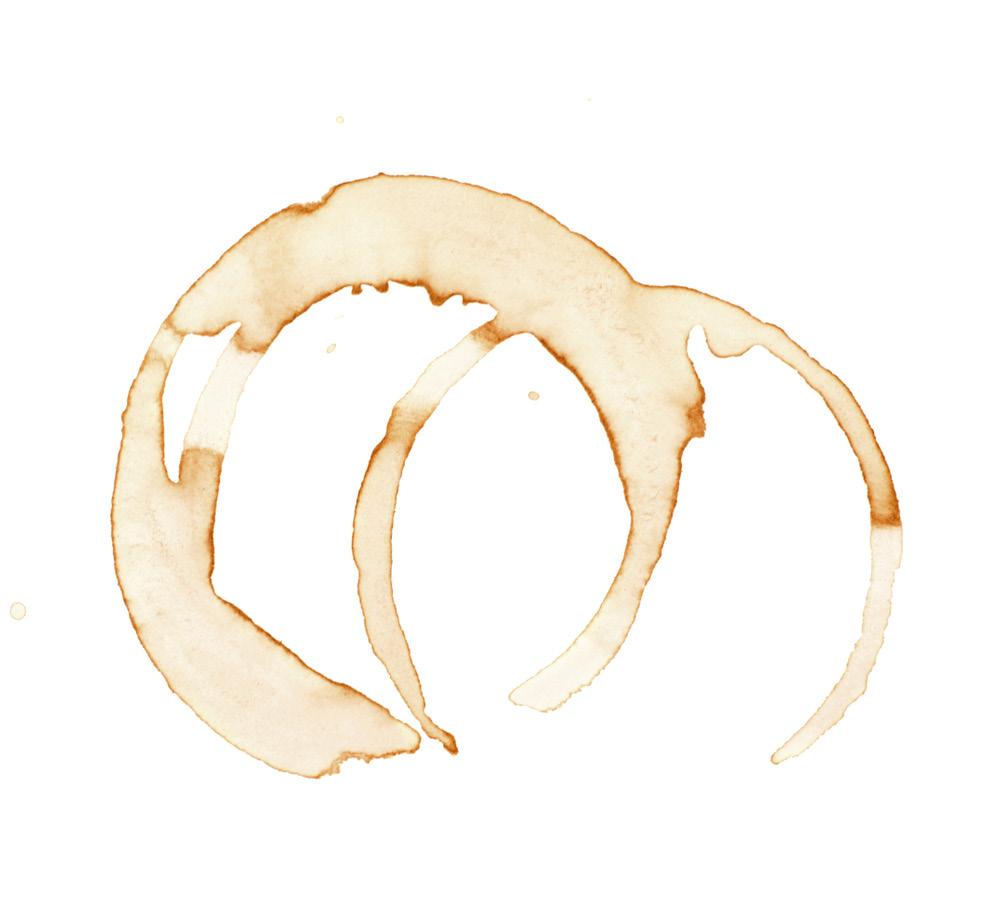

Chinese Cabbage – Cut our first head on the 24th September Courgette – They never stop!
Dwarf French bean – Both varieties Nautica and Safari keep on producing a mass of pods.
Flowers (for the bees and for cutting) – Some late flowering echinops and also some orange and yellow-flowered tithonia.
Hazel bushes – Another good harvest from the hazel.
Leek – Looking well now Val has weeded them!
Lettuce – (Little Gem) Currently cutting plants put out in August, and more were planted at the beginning of the month.
Parsnip – (Palace) We dug our first root on 24th A little early, but just for a taster.
Radicchio – The Rossa Di Treviso planted out from plugs at the end of August, and they have put on a lot of growth.
Runner beans – The variety Moonlight has more or less finished, but we have a lot of flowers on the Scarlet Emperor plants.
Squash – Now the foliage is dying back we can see good fruits of Crown Prince and Butterfly: they should be ready to harvest next month.
Sweetcorn – (Swift) The last cobs were harvested on 24th. Tally this year: 74 good cobs and 20 smaller cobs from 70 plants.
Sweet pepper and tomatoes (in the greenhouse) Everything is slowing down in the greenhouse, though we are still picking tomatoes every third

The pollinators enjoy the late-flowering echinops
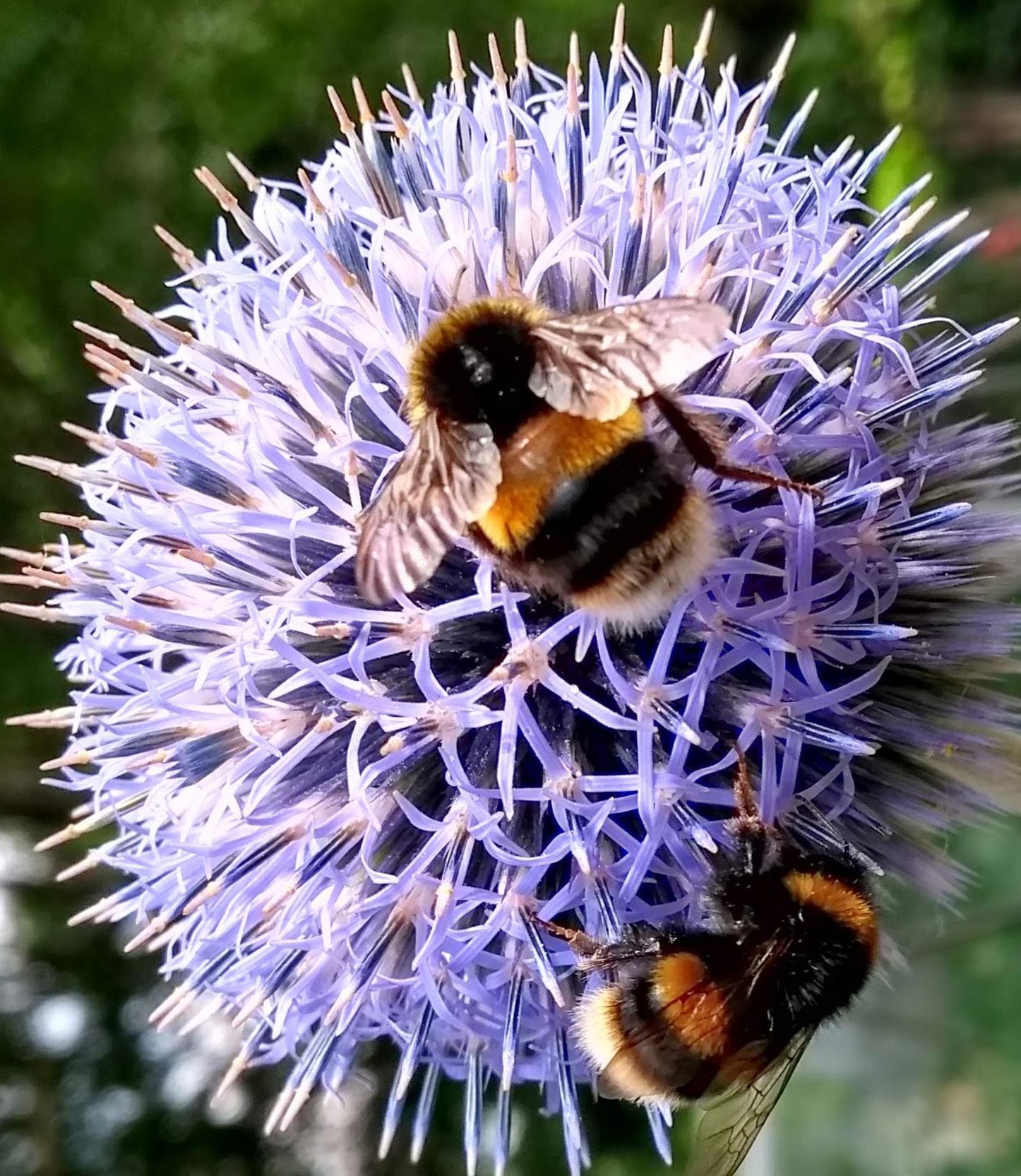
or fourth day, and a few sweet pepper plants have new flowers.
Winter salad – Val has made two sowings of oriental mustards, mixed salad leaves and Chinese radishes.
• If you are interested in an allotment in Sturminster Newton, get in touch on sturminsternewtonallotments@gmail.com
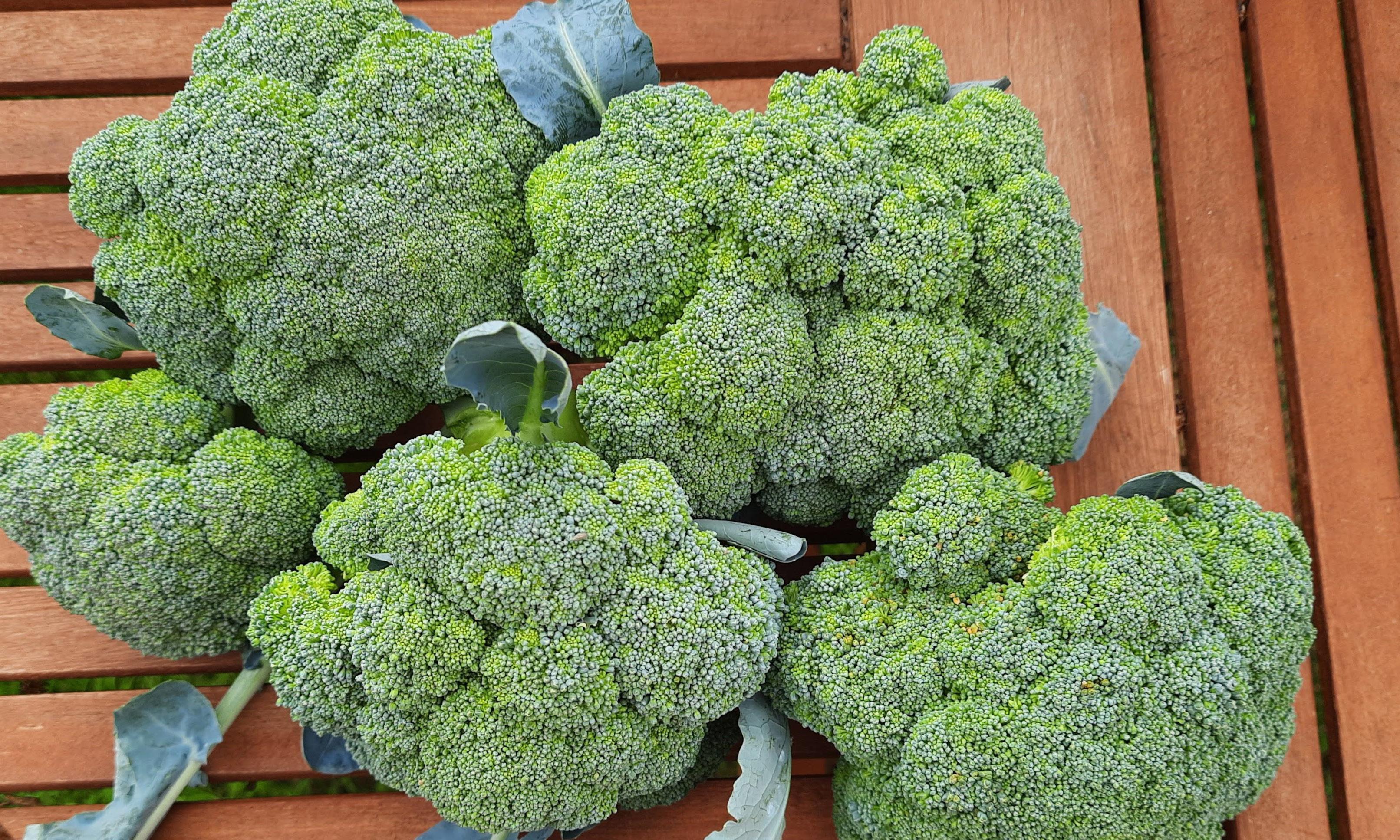
from the later plants, and good side shoots from the earlier ones’

Autumn at Thorngrove: from hanging basket workshops to Halloween crafts, it’s a season full of events, creativity and community fun
Autumn is here, and we are fully embracing all that comes with the new season. A diverse range of plants to keep things vibrant in your garden, and we’re hosting a wide range of events in the coming weeks and months – there is so much happening! Kicking off in October, our Hanging Basket Workshops are returning, and we’d love you to join us. Using a selection of plants here at Thorngrove, we will show you how to plant and arrange a beautiful Autumn basket to take home with you. No experience needed, and all materials are provided (we have a ticket option for those who wish to bring their own basket too!). Oh, and we offer discounts for large group bookings! Full details and dates on our website here.
October Half-Term and Halloween season means our Crafts for Children will be on, and the theme will be suitably seasonal. Hosted by Tracey in our glasshouse crafts room, we will have six sessions across three days at half term. Bring the children along to create mini gardens with a choice of decorations, plant some seeds and decorate Halloween jam jar lanterns. These are the perfect way for the little ones to get creative, take an interest in seed planting ... and keep them occupied during the school holiday! £7.50 per child, includes soft drink and biscuits. All materials provided, and adults go free.
You can also now book for our FESTIVE MENU in The Secret Garden Café! It will be available from Monday 18th November, and is perfect for group


gatherings, family get togethers, or work lunches. Stop by our beautiful hidden gem of a café in Gillingham and enjoy the special menu, including roast turkey, roasted gammon or nut roast – all served, of course, with roast potatoes, pigs in blankets, a medley of vegetables and a homemade Yorkshire Pudding.
Wreath Making Workshops kick off on November 26th: they’re a brilliant way to make your own wreath, or create one as gift – no experience needed, we will be your guide. Complimentary hot drink and mince pie included. For full dates and times visit our website here.
The Thorngrove Christmas Market is back for another year on Sunday 24th November. Held in our glasshouse, the market is a gather of local craftspeople and small businesses, offering seasonal gifts and treats, so stop by for a mulled wine and find something special to take home. (Christmas Trees should be ready to pick up by then too!). At the time of writing we are finalising details for Brunch With Santa, which will take place on Saturday 14th December.
Tickets going live VERY SOON!
That just about covers it … we hope to find ourselves in your diary this autumn and festive season. See you all soon! •
Is it time to import, asks Andrew Livingston, as welfare standards force British chicken farmers to cut stocking density
It was only in April of this year that I wrote in the BV of the mounting pressure for legislation to change the stocking density of chickens on British farms (See Cluckonomics here – possibly one of my finest headlines - Ed)
Since then it’s all changed. Interestingly, however, it wasn’t led by the government. It is the supermarkets who have changed the game. Just to recap: as it stands at the moment, the law states that you can have a maximum of 38kgs of chickens per square metre in a housing unit. However, the majority of the main poultry producers in the country are only stocking their shed to 30kgs per square metre. It’s pretty boring maths, but it has huge ramifications for the amount of chicken that we can produce in this country. The move from 38kg to 30kg is a reduction of around 20 per cent – so that’s around a fifth of the poultry grown in this country gone from the market. As a nation we aren’t eating less chicken, so where is it going to come from?
The simple answer is to just build a fifth more chicken sheds to grow the birds in. But it is nigh on impossible to get planning permission for poultry housing, due to the perceived effect of the environmental damage that growing the birds causes (a debate for another column, I’m afraid). So, perhaps we should bin off eating 20 per cent of our chicken dinners? Nice idea, but not going to happen. To me, poultry is the fastest and most efficient meat to provide protein. The only meat that is more efficient is insects (I wrote about bugs as food back in 2021 here!), but I still don’t think we are ready to stomach it!
The real answer? Imports.
We can’t do it
I attended the Poultry Meat Conference at the beginning of September (yes, it’s exactly what it sounds like: a conference where we all sit around and talk about poultry meat), and the 30kgs number was the big talking point. Everyone had an opinion to share. Around 200 of us were sitting in a swanky hotel,
We can’t have the highest welfare, be completely carbon neutral, have estates left for nature and biodiversity and be self-sufficient

waiting for the first speaker, when the chairman of the event – who happens to also run one of the largest producers of chicken in the country – told the room: ‘As an industry, we now can’t be afraid to import chicken.’
I thought it odd that a poultry producer would want to encourage poultry producers from across the world to get an invite into our market and trade .... as the saying goes, it’s a bit like turkeys voting for Christmas! He suggested that the UK should import the chicken for all of our frozen breaded chicken needs. At first, I hated it: ‘My kids aren’t eating Polish chicken nuggets!’ I thought (but thankfully didn’t scream out mid-conference).
But then I realised.
I had finally given up the dream.
As a nation, we can’t have the highest welfare standards for our animals, be completely carbon neutral and have huge forests and estates that are left for nature and biodiversity, while trying to be self-sufficient.
We simply can’t do it all. We are too densely populated.
So I concede – start importing the meat. But let’s make sure we leave the best bits to be farmed here in Britain. I don’t need to have lamb chops from New Zealand, but, if you want to mince up their rubbish meat, then maybe I’ll squish some on a stick in the summer and do some Kiwi lamb koftas. Then, in a few years time, once the technology has taken another leap forward and food becomes more efficient to make, we’ll be food secure and self-sufficient and we can tell the foreign muck to go home. Either that or we’ll all be eating British grasshopper kebabs.
When we move the sheep between paddocks, there’s always someone who insists on going the wrong way! Luckily, help was at hand from willing volunteers who just happened to be passing

From cover crops to clever seed mixing, George Hosford is balancing the harvest chaos with new technology and sustainable farming practices
It seems so long ago that we started harvest, way back in mid July – it turned out to be one of those long drawn out affairs, very much stop/ start due to the weather. We started with cutting the plot of turnips destined for sowing again this year as seed in our cover crop mixes, swiftly followed by the crimson clover plot for the same purpose, and then the phacelia. Since
We were hand-blending purchased bags of seeds into a barrow, then bagging up 20kg at a time … tedious!
they were all sown in autumn, they ripened much earlier than the buckwheat, vetch and camelina, which need to be sown in spring as they rarely survive the harsh winter cold.
What are cover crops?
‘We plant cover crops, also known as “green manure”, in fields that will be left fallow over the winter before a spring crop is sown,’ says George. ‘These crops protect the soil from harsh weather and absorb any remaining nutrients from the previous crop, preventing them from leaching into watercourses.’
Staying on the cover crop theme, we have ramped up our seed mixing system a good deal this year. We have purchased a selection of Tote Bins that each hold up to 1.5 tons of grain or seeds, and a brand new pan mixer (usually intended for mixing concrete!). These additions have revolutionised the set up. Formerly we were hand-blending purchased bags of seeds into a feed barrow, then bagging up 20kg at a time … all a bit tedious after the first 20 bags! Now we are mixing 600kg at a time, using mainly home-grown seeds which have been combined, dried if necessary, placed in a Tote Bin, then weighed directly into the mixer. The mixer sits on a pair of weigh bars, which are
Aerial view of our seed plots in July 2024

spring beans following an overwintered eightspecies cover crop mix, grazed by cattle

another essential ingredient for this new system. Once mixed, the blend – often containing up to drying, which I had hoped would shrivel them smaller and make them easier to remove, far too many remain. A cleaning charge will have to be faced, as running over a gravity separator offfarm may be the only way to clean them out.
Modern farmers will be yelling at the screen right now, asking why on earth did we not use more weedkiller to solve the cleaver problem? But the simple answer is, we couldn’t, because the contract we have with Wildfarmed for combination crops stipulates no weedkiller or fungicide, and only limited amounts of artificial fertiliser.
However, early gross margin calculations are showing that these two particular combinations have performed significantly better than any solo spring bean or linseed crop, and in fact compare favourably with our other crops, apart from the first wheats.
The winter wheat with beans blend, however, was awful: riddled with disease and very short on yield, despite having looked strong for much of the season.
The lateness of sowing the spring wheat/bean blend put the lid on our yield hopes, but we hoped it would be
better than the winter blend. We were very pleased, then, to find the wheat met quality standards, and should get the full premium, leading to a useful margin compared with our other crops. The millet looked fantastic throughout the summer, but knowing when to cut was a challenge, as the leaves were still very green when the seeds were beginning to turn. As I write at the end of September, I am still drying that darn millet: it’s now had six runs through the drier. I think we cut it a bit early due to trying to beat forecast rain.
Three very greedy young pigs were with us for the summer, enjoying an entirely home-grown diet for the first time. Our local mobile feed wagon called in to mill up some wheat, barley, peas and beans, to which I add 10 per cent protein-rich rape meal from which we have already squeezed the oil, and mixed the lot into a yummy porridge. They appear to approve the recipe, anyway, slurping it down in seconds. And they are certainly growing well on it – they look like they will perform at least as well as their predecessors who were fed on purchased weaner pellets (which no doubt contain imported soya from who knows where).
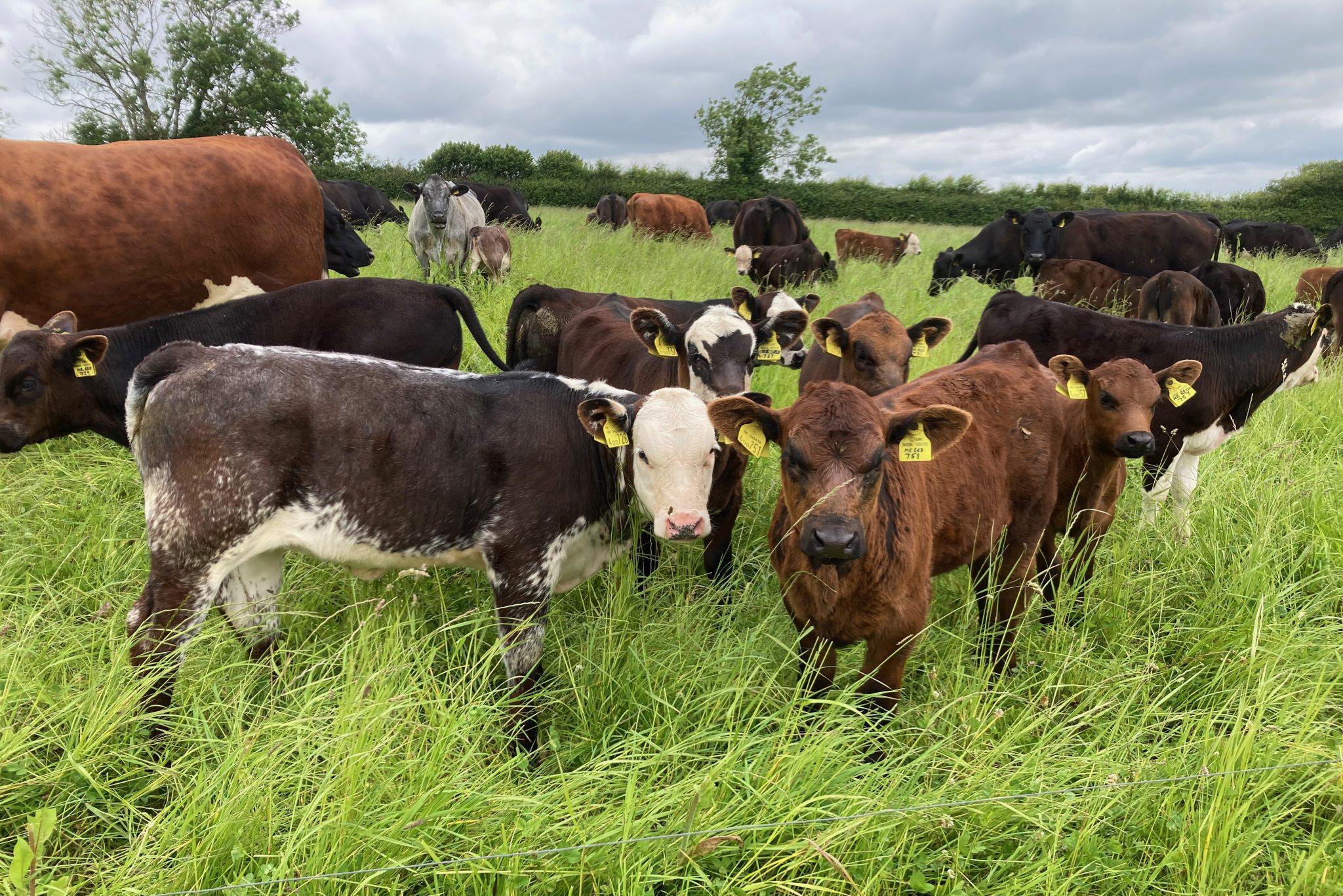
* You may by now be thinking that I am a little obsessed with cover crop seeds and grain store activity. But that is the nature of harvest for the old man left in the farmyard while everyone else swans
around in super-cooled hi tech cabins with satnav doing all the steering …
• Read 15 years of George’s monthly farm diary on
viewfromthehill.org.uk


Dorset Mind’s Mery Zanutto says we should treat mental health like physical health with daily self-care and asking for support
What exactly is mental health? This question often elicits a range of responses, highlighting the complexities and misunderstandings surrounding the topic. People often address their physical health assertively and confidently, yet discussions about mental health are met with ambiguity and hesitation.
Physical vs mental inequality
Mental health is just as important as physical health: it’s an integral part of our overall wellbeing, affecting how we think, feel and act. It influences our ability to handle stress, relate to others and make decisions. Yet, despite its importance, mental health is often shrouded in stigma and misunderstanding. It’s time to start viewing mental health as an equally-essential component of our wellbeing as physical health. Maintaining mental wellbeing should be a part of our everyday routine. Just as we exercise to benefit our physical body, we need to cultivate practices that support our mental wellbeing. This includes self-care strategies like mindfulness, regular physical activity, healthy eating, adequate sleep and, importantly, talking about our feelings and experiences with others. At Dorset Mind, we excel in providing a safe space for individuals to reach out and talk about their mental health. Our comprehensive range of services is designed to support mental wellbeing at every stage of life for both adults and young people aged nine upwards.
Observed on October 10th, World Mental Health Day is dedicated to raising awareness and promoting mental health education.

It’s an opportunity to address stigma, advocate for mental health policies, and celebrate progress made in mental health care. Taking responsibility for our mental health can be empowering. It involves recognising when we need help and then seeking support without shame.
Dorset Mind’s CEO, Linda O’Sullivan, says: ‘We cannot always do this alone. As humans, we need connection and the support of others, but importantly we often need to recognise this ourselves.’ Seeking help is an essential first step towards maintaining mental wellbeing. It can also be the bravest thing you do.
As we celebrate World Mental Health Day, let’s commit to making mental wellbeing a daily priority. Reach out, talk to others and utilise the services available at Dorset Mind and other sources we have locally and nationally.
Together, we can support each other in achieving better mental health and wellbeing.
• For more information about our services, please visit Dorset Mind’s website at dorsetmind.uk, where you’ll find what the charity offers, as well as signposting for crisis support and other help for adults and young people.
• First steps towards support should be to speak to someone - a trusted friend, family member, professional or your GP
• Visit Dorset Mind for local mental health support and helpful advice
• The Samaritans are there to listen 24/7, call them free on 116 123
• Call Dorset’s mental health helpline Connection for support on 0800 652 0190

by Karen Geary, Nutritional
From lowering blood pressure to improving digestion and relaxation, these six teas can enhance your daily wellness, says Karen Geary
Tea is one of the most popular beverages around the world, celebrated for its flavour, variety and numerous health benefits. Across different cultures, various teas are known not only for their soothing effects but also for their healing properties. They are a cost-effective way of accessing good nutrition and are often under-utilised. This month I thought I’d share some of my favourite teas and the ones most often recommended in my practice.
Hibiscus
Hibiscus tea is made from the dried calyces (the protective covering) of the hibiscus flower and is known for its tart, cranberry-like flavour. One of its most notable benefits is its ability to lower blood pressure. Numerous studies have shown that drinking hibiscus tea can help reduce systolic and diastolic blood pressure in people with hypertension, which can support heart health. Hibiscus tea is also rich in antioxidants, which help fight oxidative stress and reduce inflammation, potentially lowering the risk of chronic diseases.
Drink two cups a day consistently for six weeks minimum to see a noticeable effect. It’s also lovely as a cold, iced tea, but some may need honey added as it is very tart.
Ginger tea, made from fresh or dried ginger root, is a powerful digestive aid. It has been used for centuries to soothe stomach aches, relieve nausea and reduce indigestion. Ginger has natural anti-inflammatory properties, making it useful for potentially reducing symptoms of arthritis and muscle soreness. Additionally, its warming nature can boost circulation and immune function, making ginger tea a favourite during cold and flu season. Gingerol, the active compound in ginger, is also linked to reduced risks of cardiovascular disease and may help in managing blood
Green tea, loaded with antioxidants, is one of the most widely consumed teas in the world

sugar levels. For a simple ginger decoction, try this recipe. Adding honey is a personal choice: I don’t. For something a little different though, try Ginger and Honey Switchel, a rather addictive drink!
Green tea is one of the most widely consumed teas in the world, and for good reason. It is loaded with antioxidants, particularly catechins, which have been shown to reduce the risk of heart disease by improving cholesterol levels and lowering blood pressure. The presence of epigallocatechin gallate (EGCG) in green tea can boost metabolism, aiding in weight management.
Additionally, green tea contains L-theanine, an amino acid that promotes relaxation and improves cognitive function without the jittery
effects of caffeine. Studies also suggest that regular consumption of green tea may reduce the risk of certain cancers, including breast and prostate cancer. Green tea needs to be brewed at around 80°C to maximise EGCG extraction without scalding it. It tastes better too if it isn’t scalded (not so bitter), so brew the tea AFTER the water has been boiled.
Regular common-or-garden black tea is packed with polyphenols, tannins and flavonoids. Brewing black tea at around 90-100°C ensures you extract the full range of its polyphenols, tannins and flavonoids, which contribute to its flavour and health benefits. It’s fully oxidised, so more stable brewing at higher temperatures in terms of extracting the benefits than is green tea. For best effect, drink without milk!
Chamomile tea is best known for its calming and soothing effects, and is often consumed before bed to improve sleep quality. It contains apigenin, an antioxidant that binds to certain receptors in the brain, promoting relaxation and reducing insomnia. Chamomile tea also has


Numerous studies have shown that drinking hibiscus tea can help reduce blood pressure, and also help reduce inflammation, potentially lowering the risk of chronic diseases
anti-inflammatory and antibacterial properties, making it useful for alleviating symptoms of colds, such as sore throats and nasal congestion.
Its mild sedative effects also help reduce anxiety and stress levels, making it an excellent choice for those looking to unwind.
Holy basil, also known as tulsi, is a revered herb in traditional Ayurvedic medicine, known for its adaptogenic properties and is extremely well researched. Holy basil tea helps the body adapt to stress and promotes mental balance. It is packed with antioxidants, supporting immune function and detoxification. Tulsi tea is also believed to lower blood sugar and cholesterol levels, contributing to better cardiovascular health if consumed regularly.
Additionally, holy basil is antibacterial, antiviral and antifungal, making it a great tea for overall immune support.
Incorporating these teas into your daily routine can provide a range of benefits, from improving heart health and digestion to reducing stress and promoting relaxation. Whether you’re sipping hibiscus for its heart-healthy properties or enjoying chamomile to wind down, each tea offers unique advantages that contribute to overall well-being.

Dorset Chamber CEO Ian Girling talks about the need for celebrating success, and looks ahead to navigating uncertainty and fostering growth
I’d like to begin by saying a huge thank you to everyone that is participating in the 2024 Dorset Business Festival. With several events across Dorset, our aim is to unite Dorset businesses and celebrate the importance of business as a force for good – we kicked off festival fortnight with an insightful networking breakfast on Sandbanks, and this week have had a brilliant two day Business Expo. Now we look forward to next week’s Business as a Force for Good Conference (still some tickets available).
I’d also like to offer our congratulations to all the finalists in the Dorset Business Awards, and I look forward to seeing them all at the sold out Gala Dinner on the 10th October. Business makes a hugely positive impact to society on so many levels and we should always remember and celebrate this.
Change may be coming 30th October will see the delivery of the Autumn Budget by Chancellor Rachel Reeves –we will of course be gauging the reaction of Dorset business to the budget. A couple of weeks ago, we ran a LinkedIn poll to

see how business people were feeling about the impending budget, given the very gloomy messages coming from Government in the run up to it. Unsurprisingly, of the people that responded to the poll, 48 per cent said they were very concerned about the forthcoming budget, 42 per cent are somewhat concerned and only 10 per cent not concerned at all. It will be interesting to compare this to the days after the budget is delivered. Businesses have been through an incredibly challenging few years with Covid, Ukraine and the cost of living crisis with its high inflation and a significant
increase in interest rates. Businesses need a period of stability, and an economic environment that supports business, encouraging growth, employment and investment. We will continue to push on this locally as well as at a national level through the British Chambers of Commerce. We’d welcome the views of Dorset business around the economic plans from the new Labour Government, as well as the new employment legislation which is significant for all businesses employing people. If there is anything we can help you with, please don’t hesitate to get in touch.

Dorset Chamber’s chief executive, Ian Girling, has observed a clear shift in the job market, with many jobseekers—particularly younger generations— prioritising conscientious employers over higher salaries. His comments come ahead of the Dorset Business Festival Conference on October 9, which will include a panel discussion: ‘Gen Z – Alpha and Beyond: Their Future in our Hands,’ will be focusing on how businesses can adapt to the expectations of tomorrow’s workforce.
Ian’s insights are in line with recent data from the Office for National Statistics (ONS), which shows that the employment rate for those aged 16 and over fell to 4.1% between May and July. As the recruitment landscape changes, employers are increasingly finding that factors like wellbeing, environmental practices, and social responsibility are becoming more important to potential employees than pay alone.
‘Employers continue to face challenges in recruitment and retention,’ Ian said. ‘It is clear that many now choose their workplace based on whether it is a conscientious company that does the right thing. Expectations are changing, and businesses need to keep pace to meet the needs of tomorrow’s workforce.’
To find out more about these emerging trends and discussions on adapting business practices, join the Dorset Business Festival on 9th October. The day-long conference will feature inspirational

Political strategist and policy maker
Lord Matthew Elliott will be a keynote speaker
panels, spotlight speakers, and opportunities for Q&As and networking. Hosted by broadcaster Declan Curry, the event includes keynote addresses from changemaker and climate change consultant Benita Matofska as well as political strategist Lord Matthew Elliott.
Consumers, investors and talent are increasingly drawn to businesses that make a positive impact alongside profit. The conference explores why being a force for good is not just beneficial for society but a smart strategic business move, from attracting top talent to boosting brand loyalty and fostering innovation.
• For more details and tickets, see dorsetchamber.co.uk








Do you love great food? Are you happy to get stuck in and enjoy working in a jolly, busy environment as part of a team? Are you capable of working competently in an ever changing environment? If so, then this could be right up your street.
We are on the lookout for more Production Oliveers to join our growing business, helping to make all kinds of lovely things at our Sturminster Newton HQ.
If this all sounds like you, please drop us line with your CV and a bit of an outline of what makes you tick and tell us why we’d be off our rocker’s not to hire you...




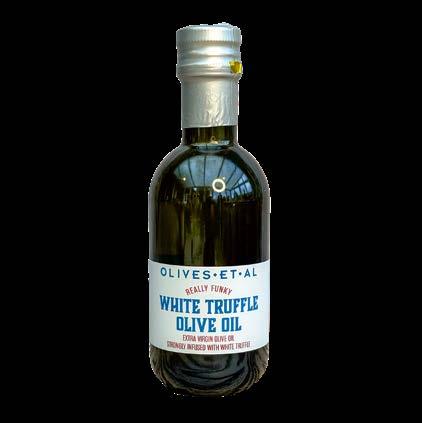



O c t o b e r , b a p t i s e m e w i t h
l e a v e s ! S w a d d l e m e i n
c o r d u r o y a n d n u r s e m e
w i t h p e a s o u p .

D o y o u t h i n k a l o c a l ( o r y o u r
o w n ) b u s i n e s s w o u l d m a k e a
g o o d p r o f i l e f e a t u r e ?
K n o w s o m e o n e d o i n g g o o d
t h i n g s t h a t w e s h o u l d t a l k a b o u t ?
S e n d a q u i c k e m a i l t o L a u r a :
e d i t o r @ B V m a g a z i n e . c o . u k
G e t i n t o u c h w i t h C o u r t e n a y t o c h a t
a b o u t w h a t y o u ' r e l o o k i n g f o r - w e ’ r e
a l w a y s k e e n t o t a l k t o l o c a l b u s i n e s s e s
l o o k i n g f o r n e w w a y s t o b u i l d t h e i r
p r o f i l e a n d r e a c h :
a d v e r t i s i n g @ B V m a g a z i n e . c o . u k
0 1 2 5 8 4 7 2 5 7 2
N e x t P u b l i c a t i o n D a t e :
1 s t N o v e m b e r
( d e a d l i n e 2 5 t h O c t o b e r )
T h e B V p u b l i s h e s o n t h e f i r s t F r i d a y
o f t h e m o n t h , a n d t h e a d v e r t i s i n g
b o o k i n g d e a d l i n e i s a l w a y s t h e
F r i d a y p r i o r t o p u b l i s h i n g